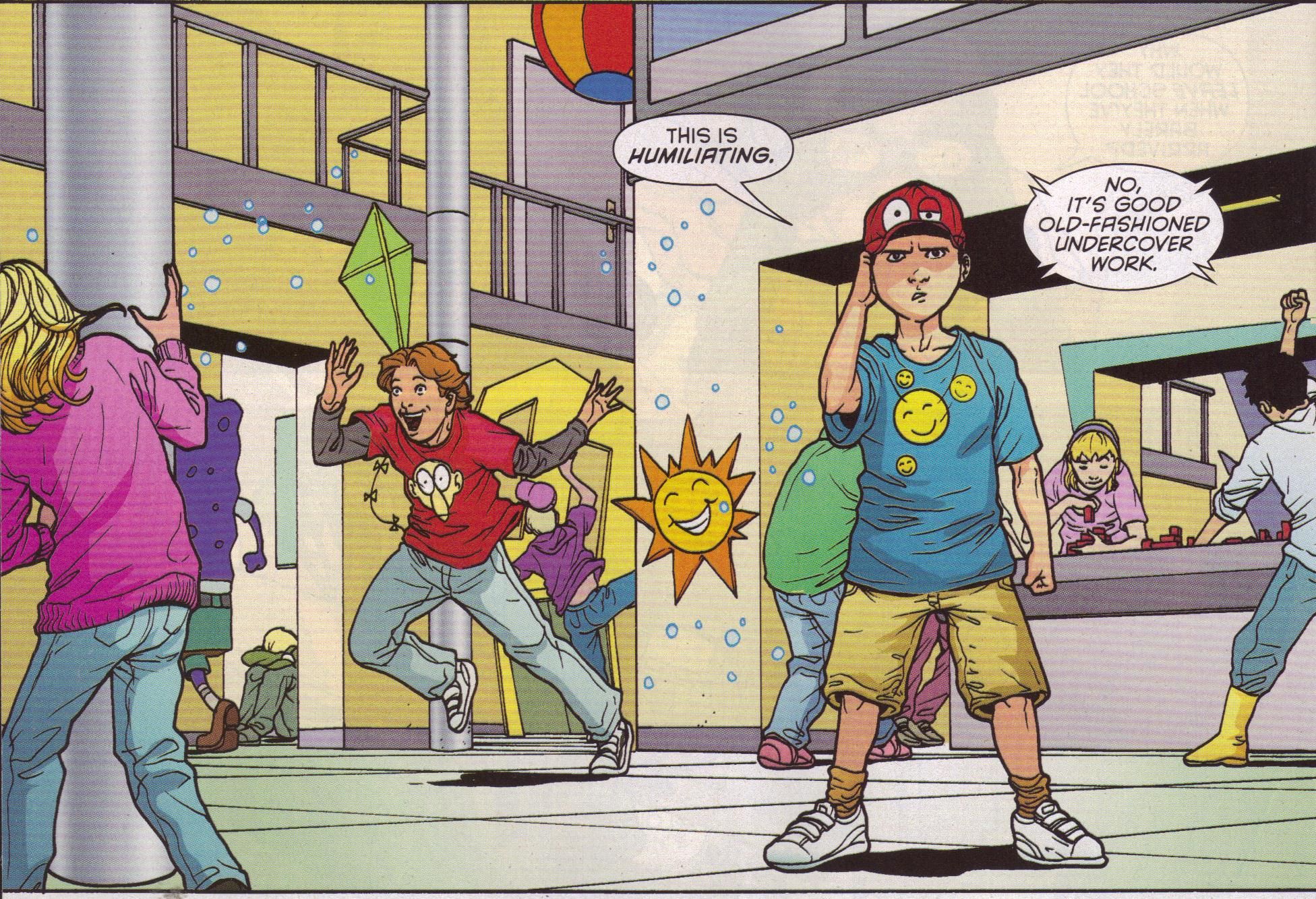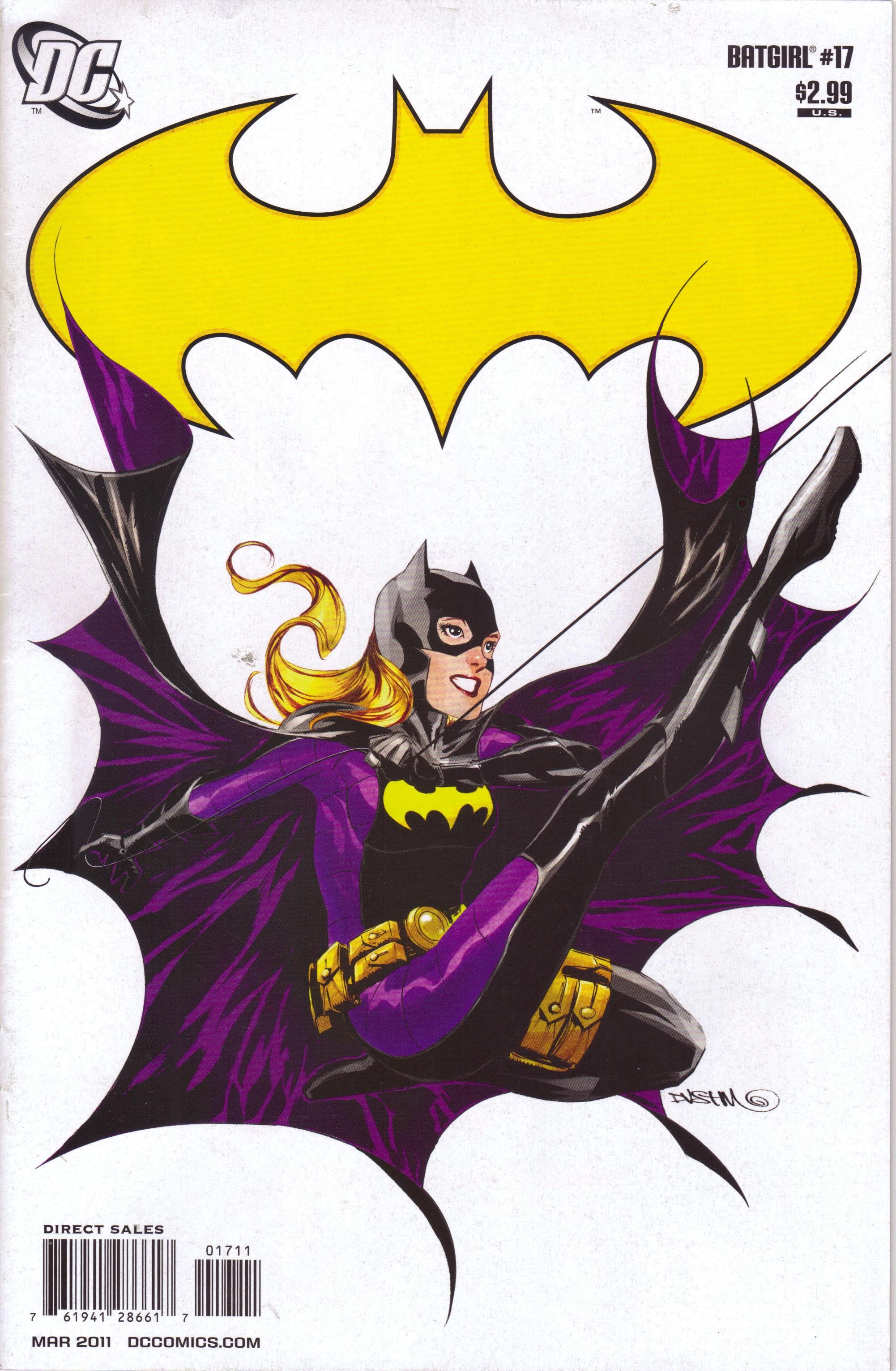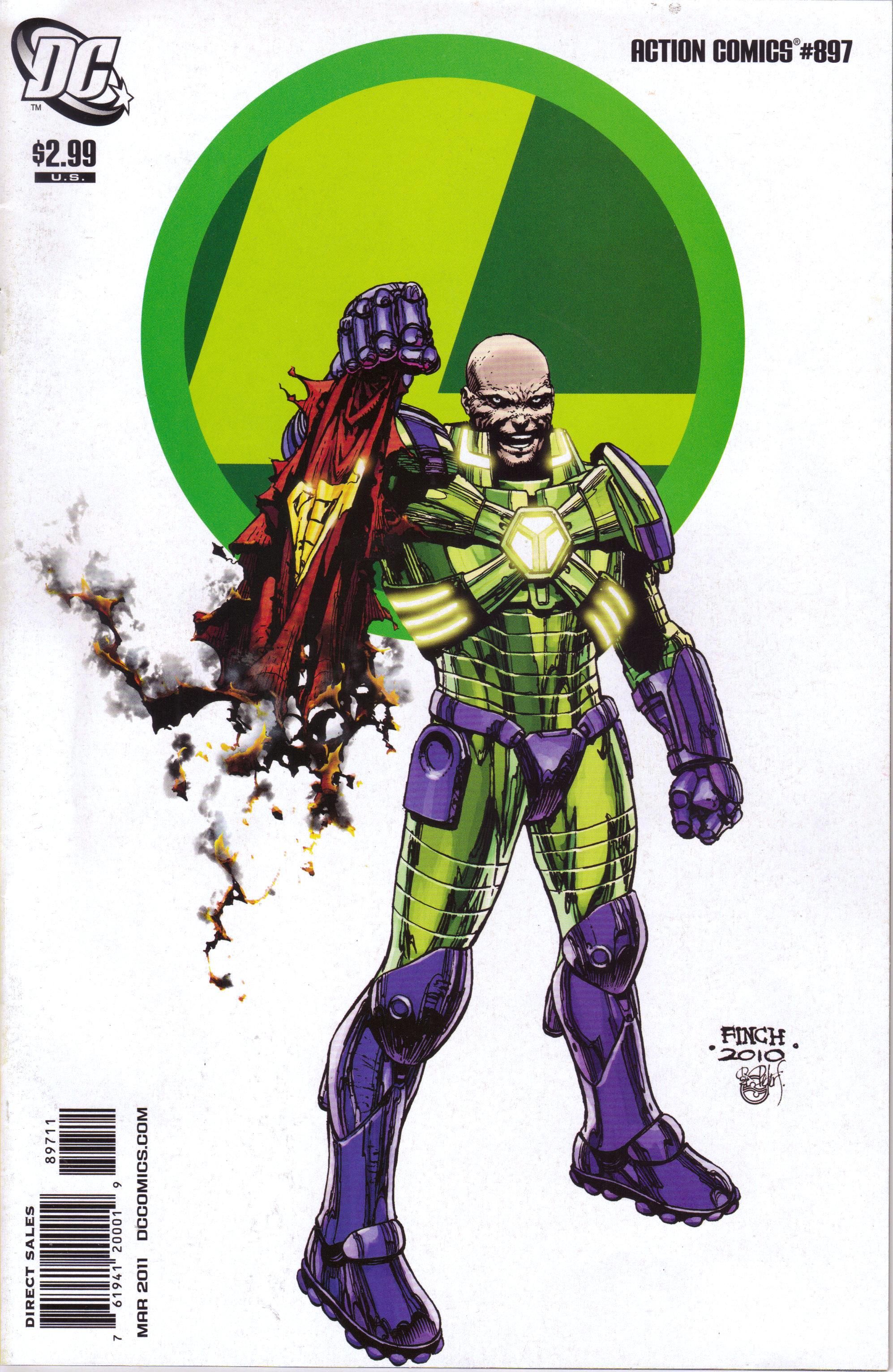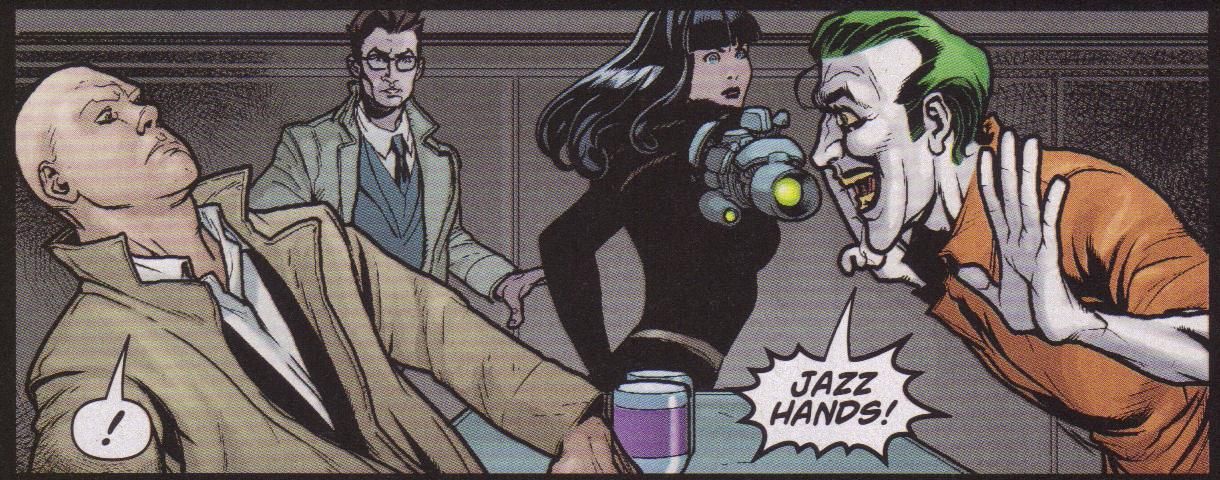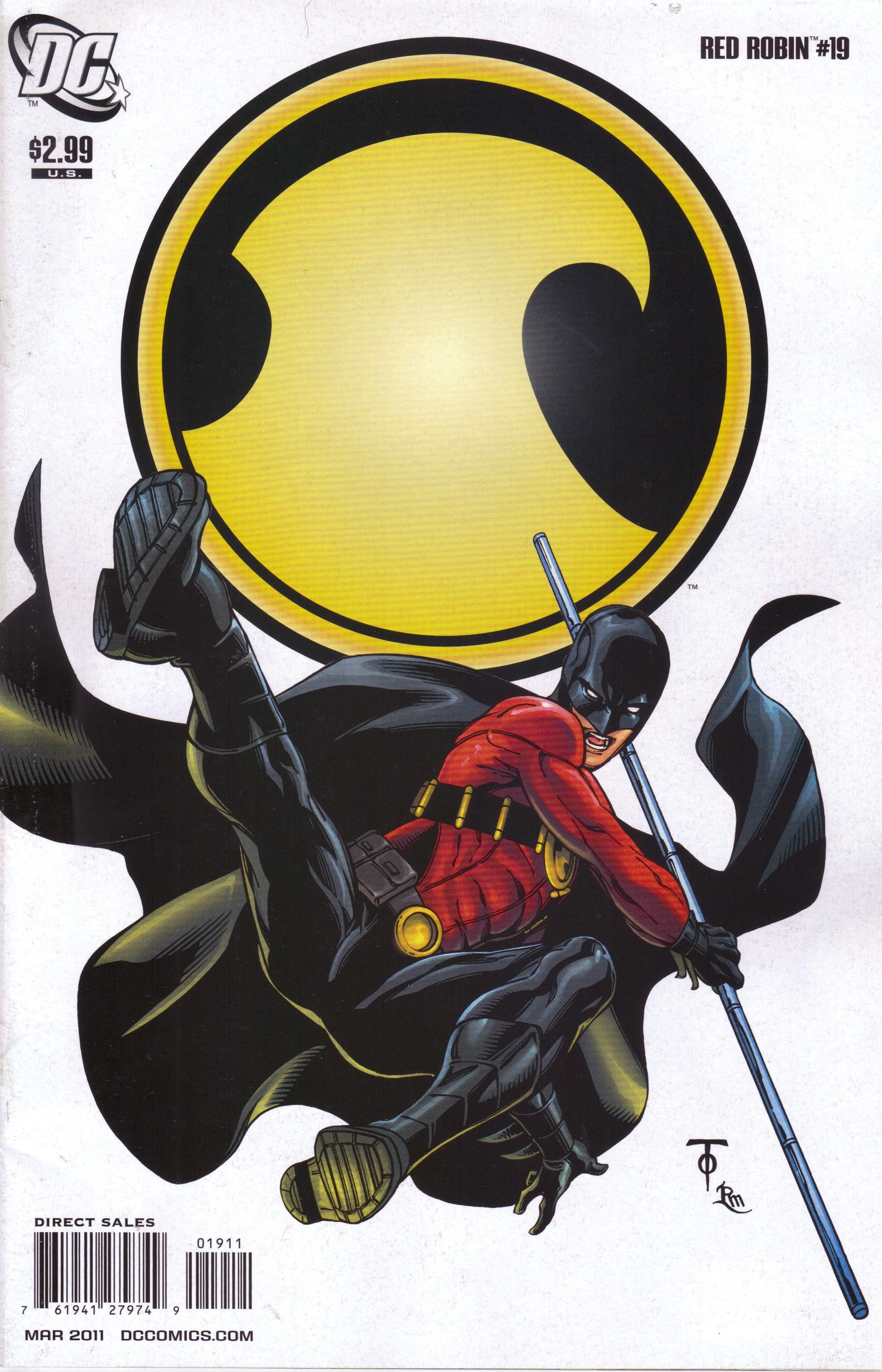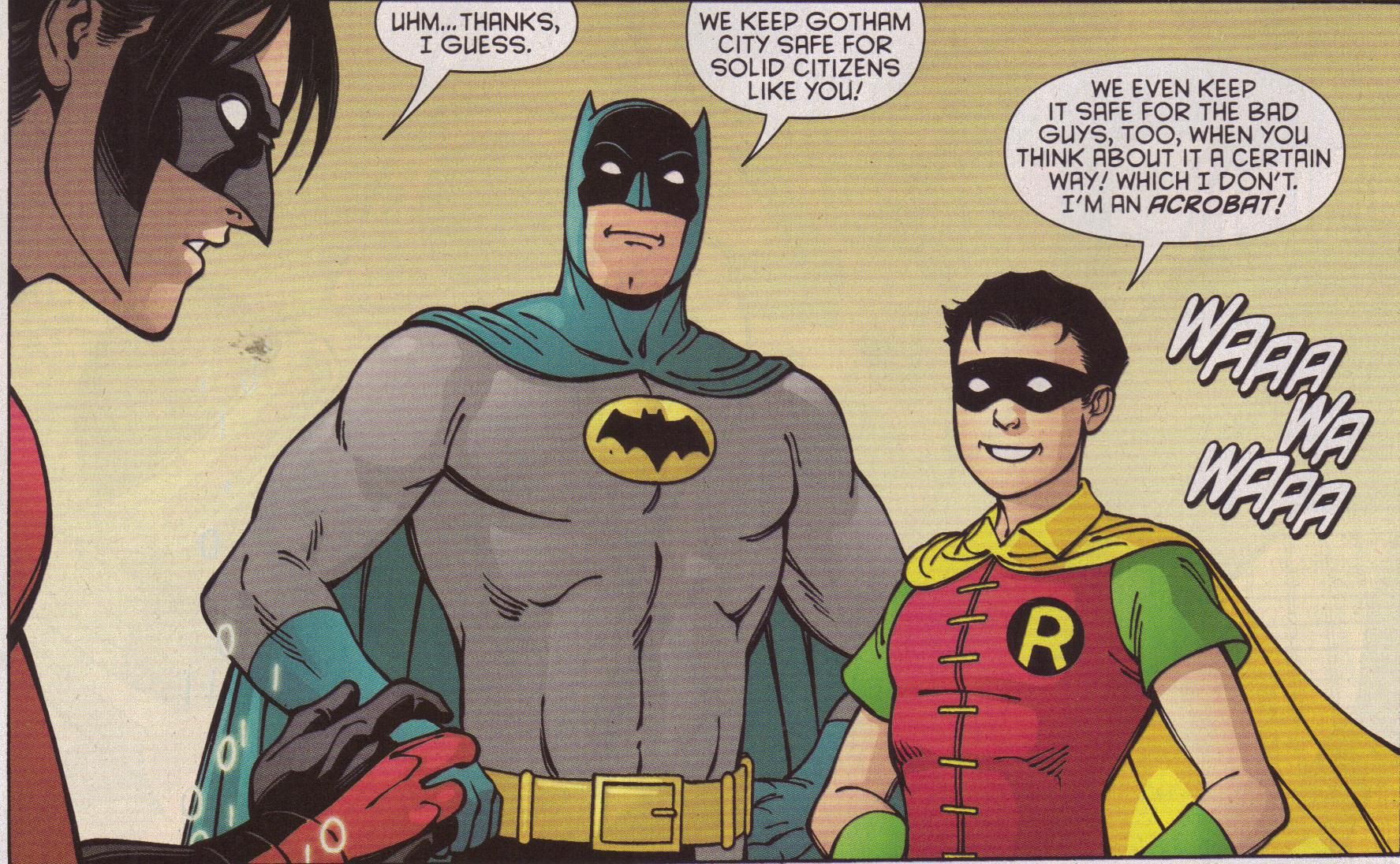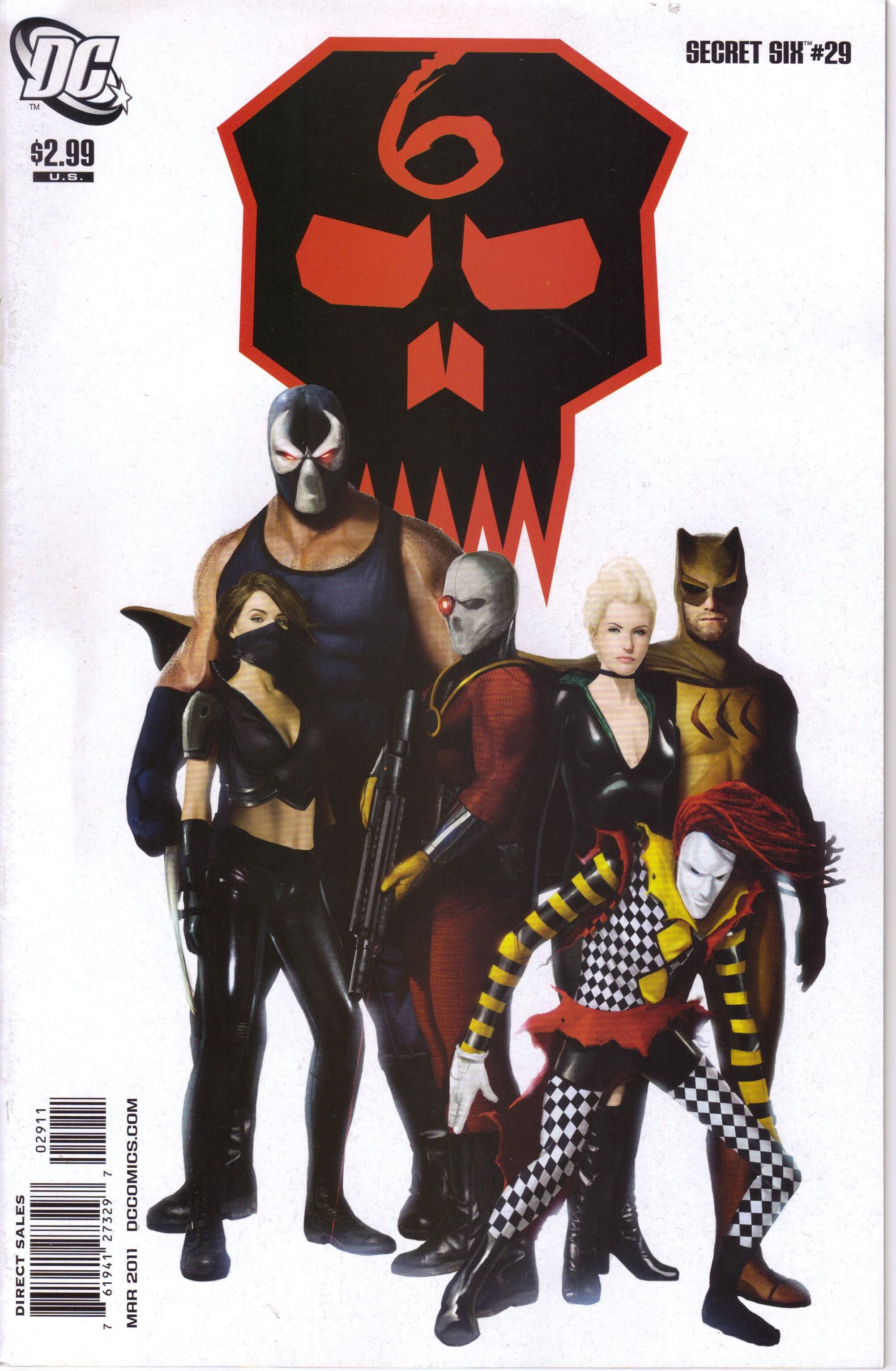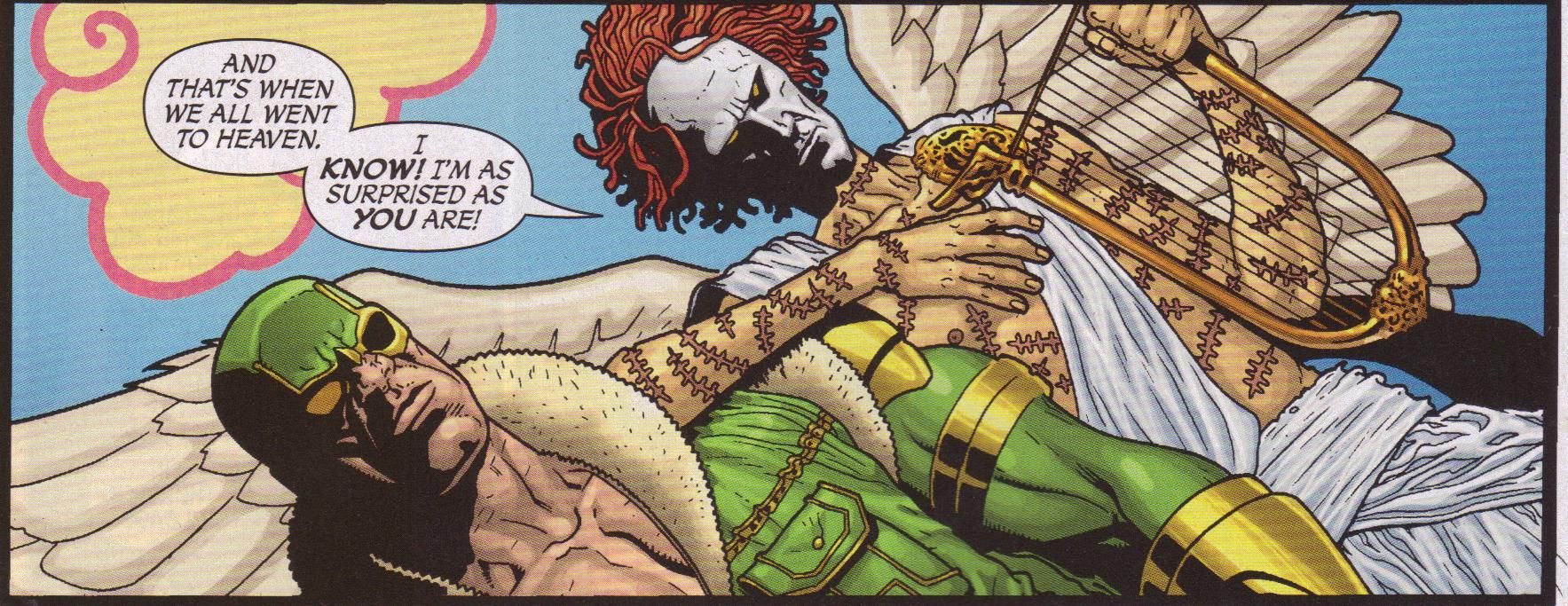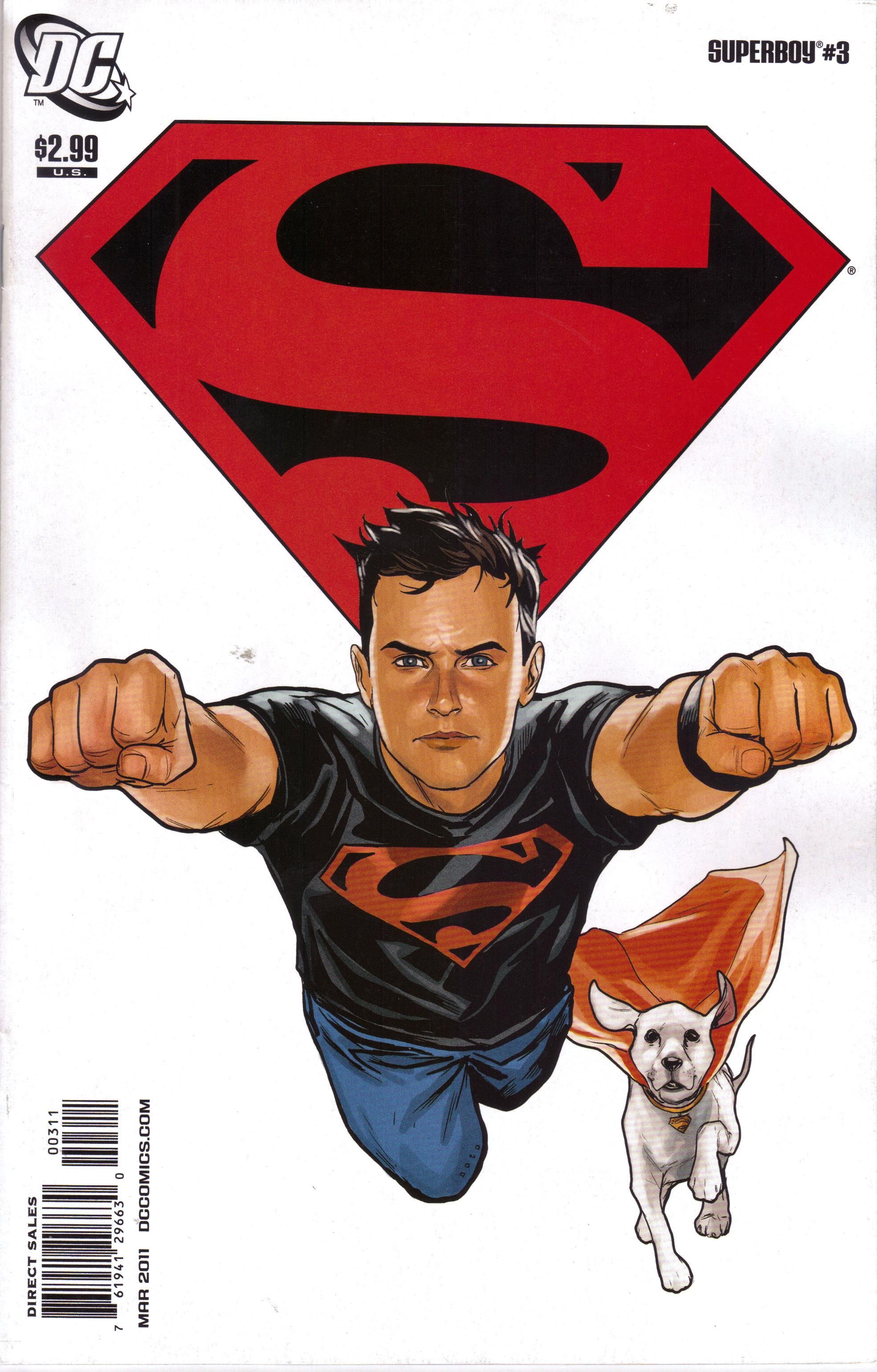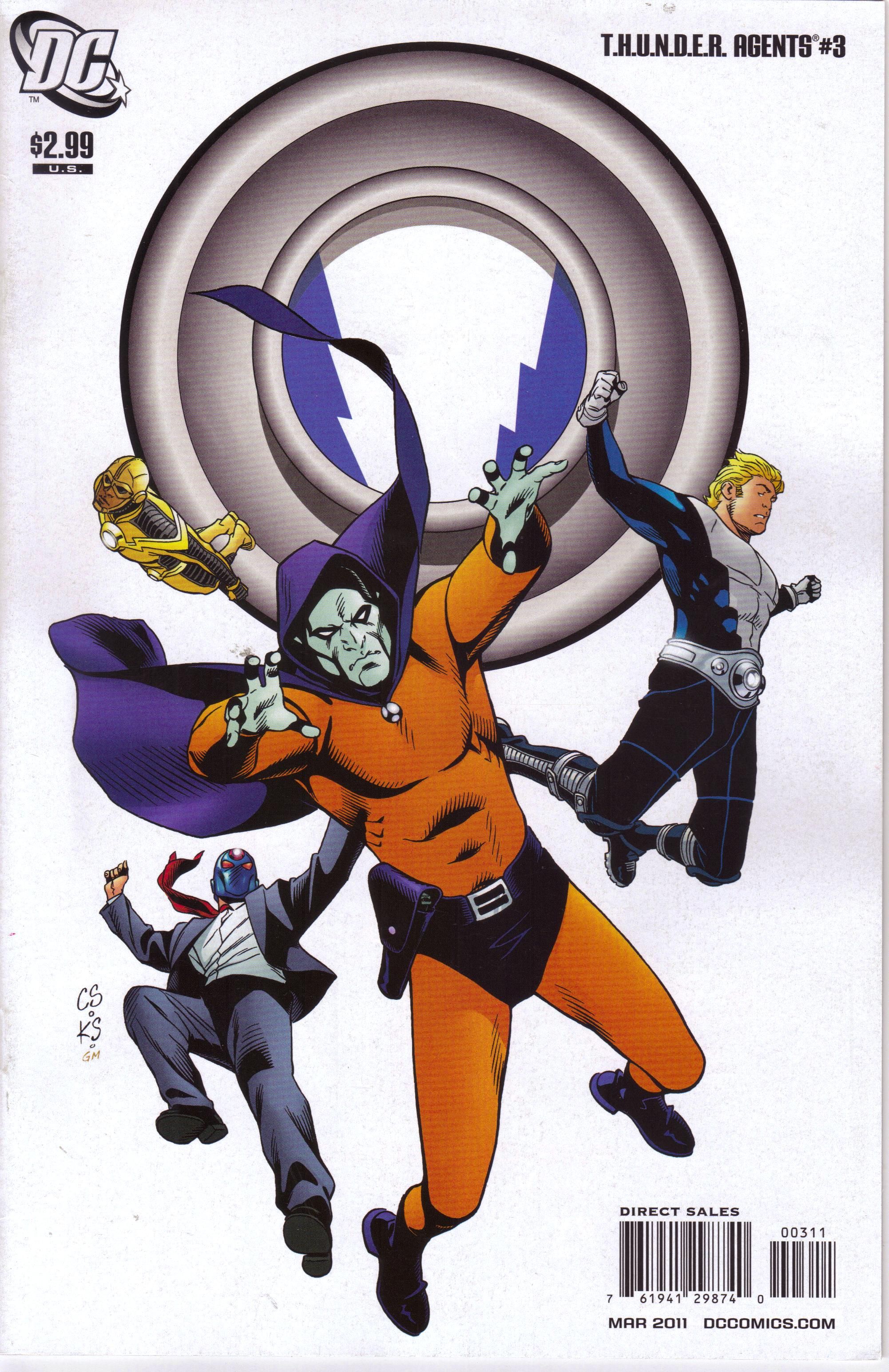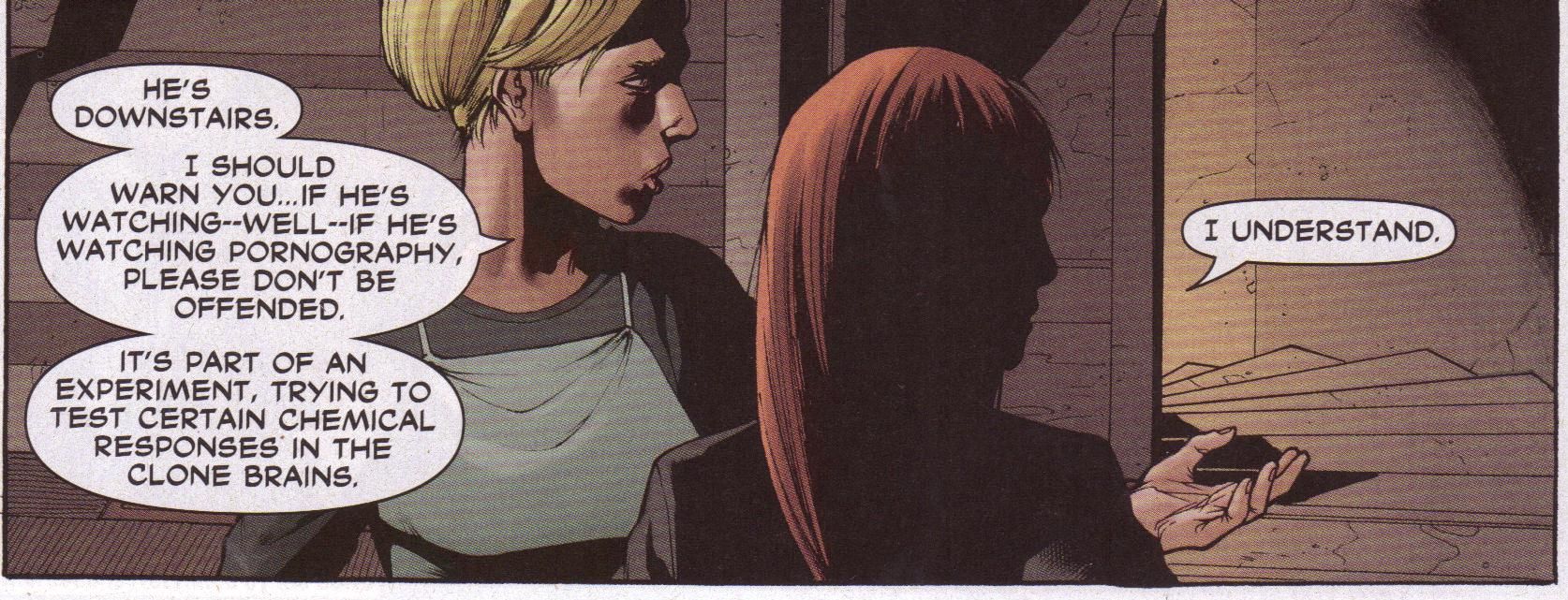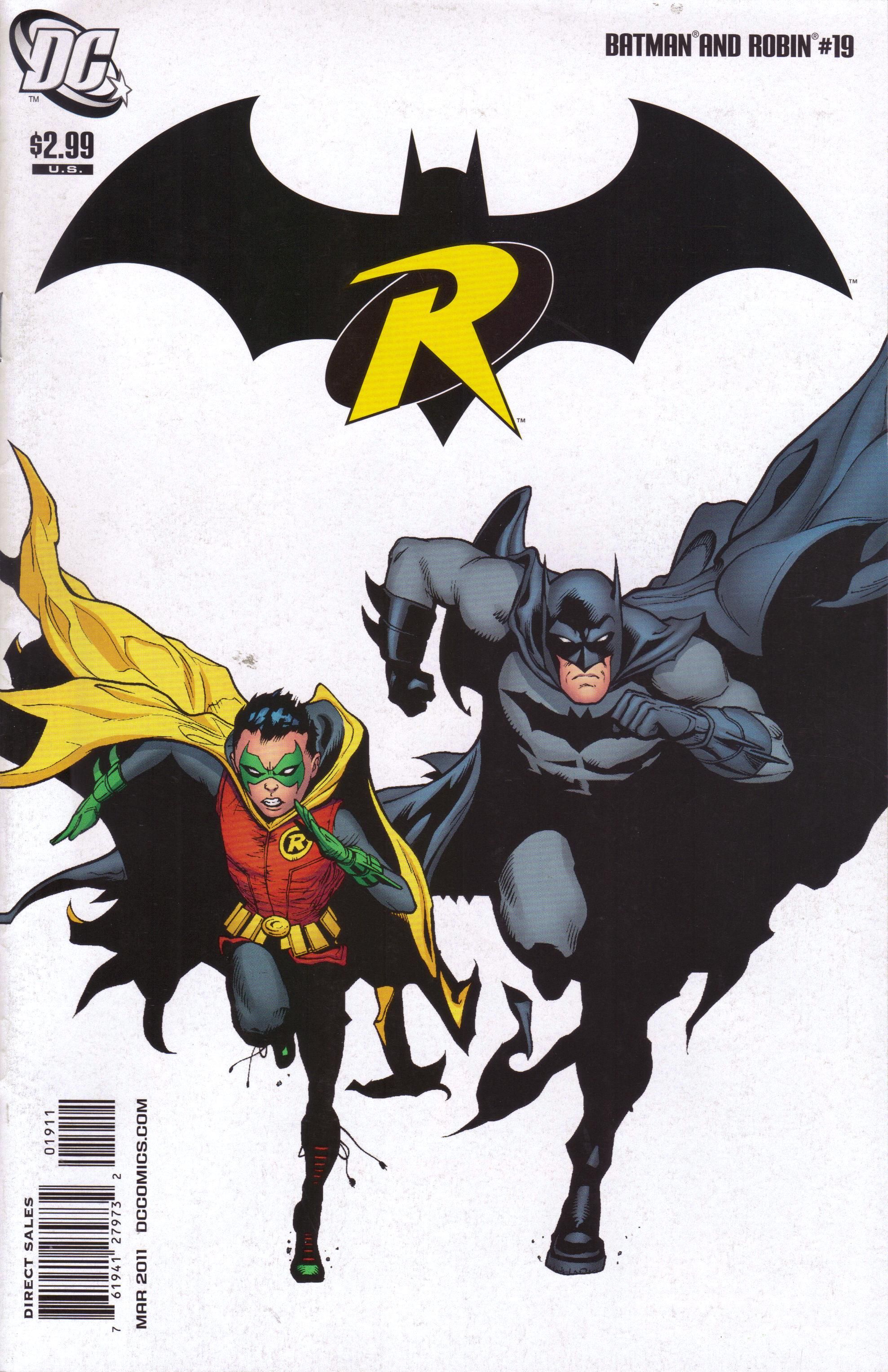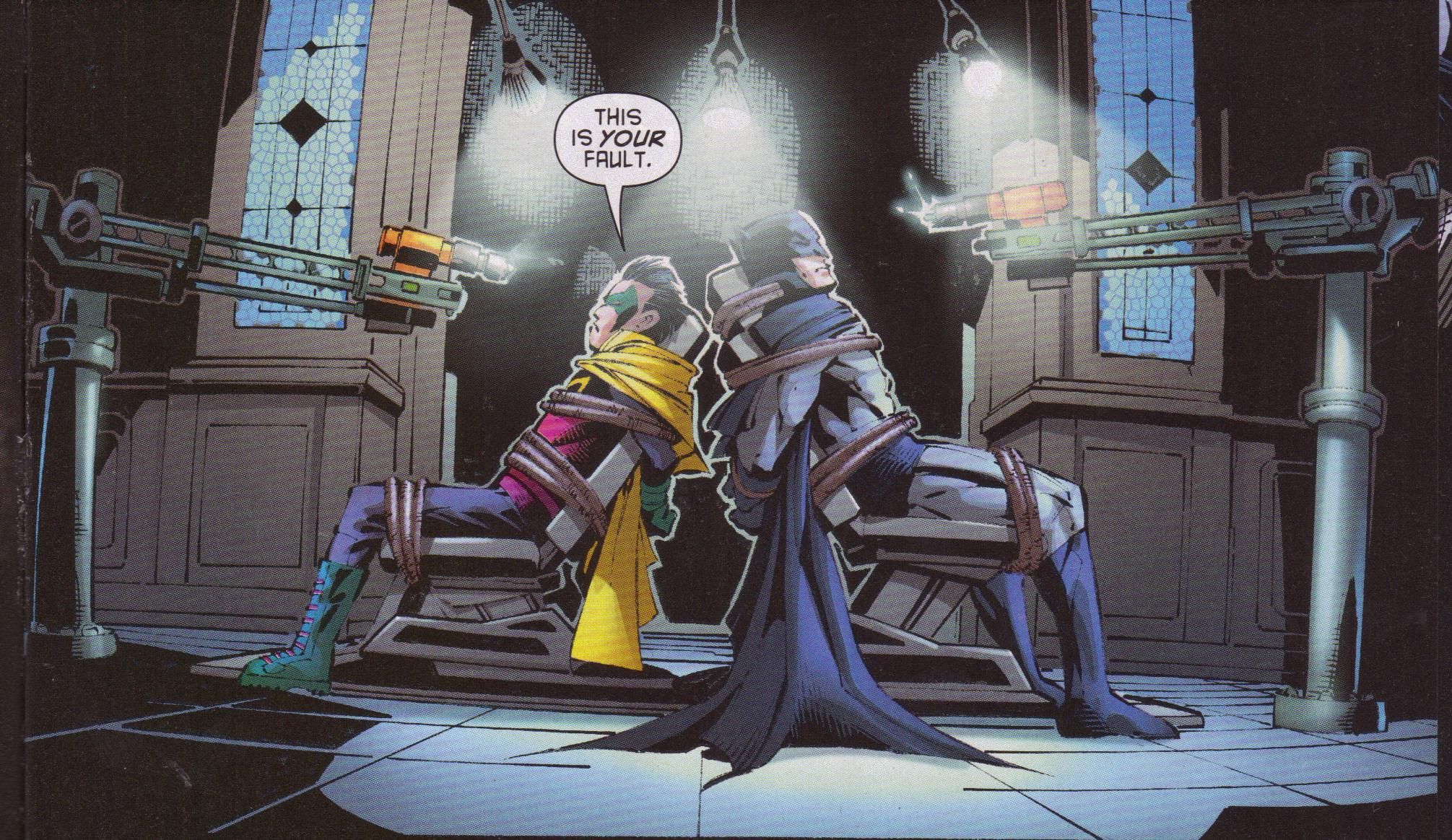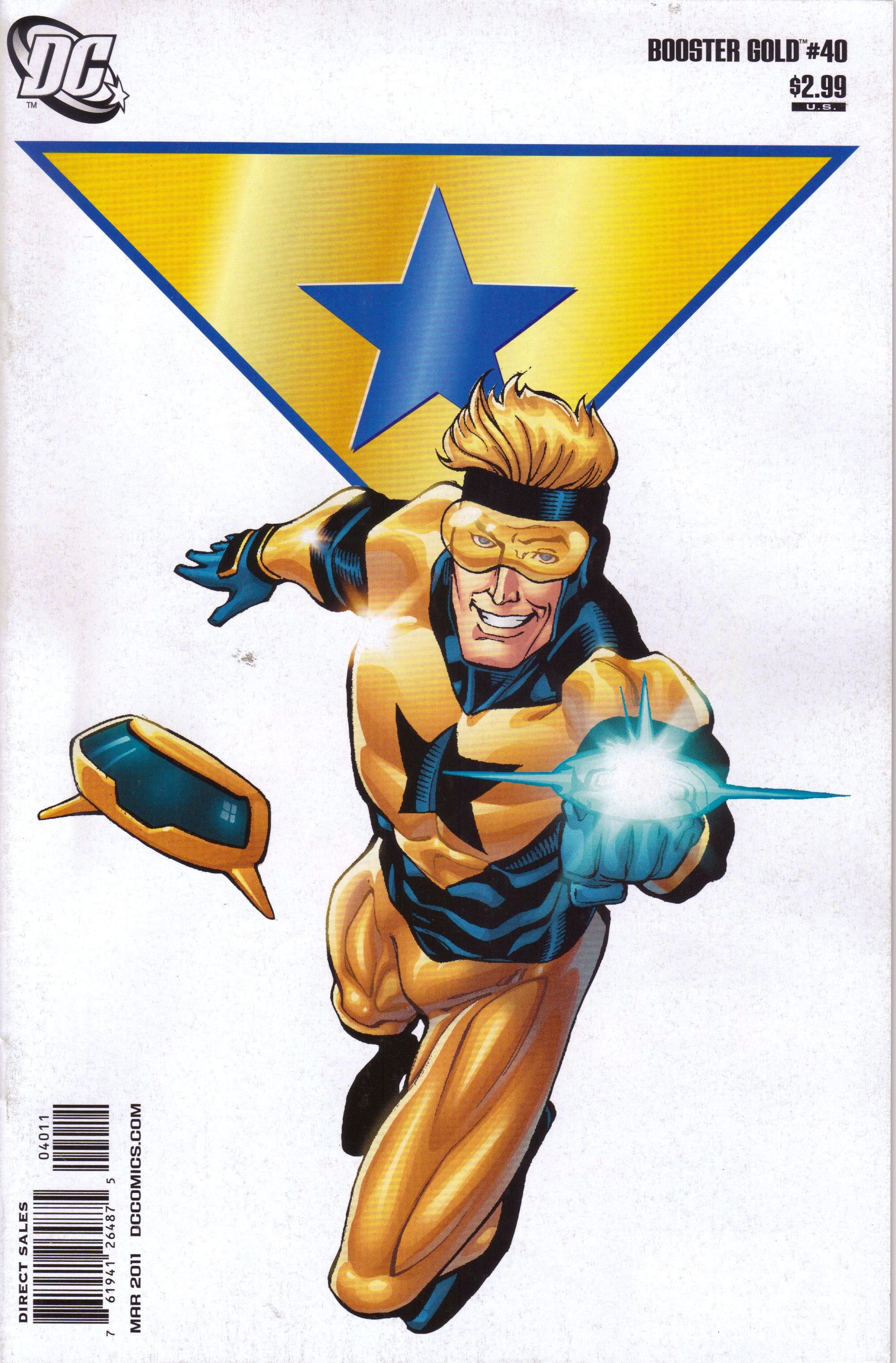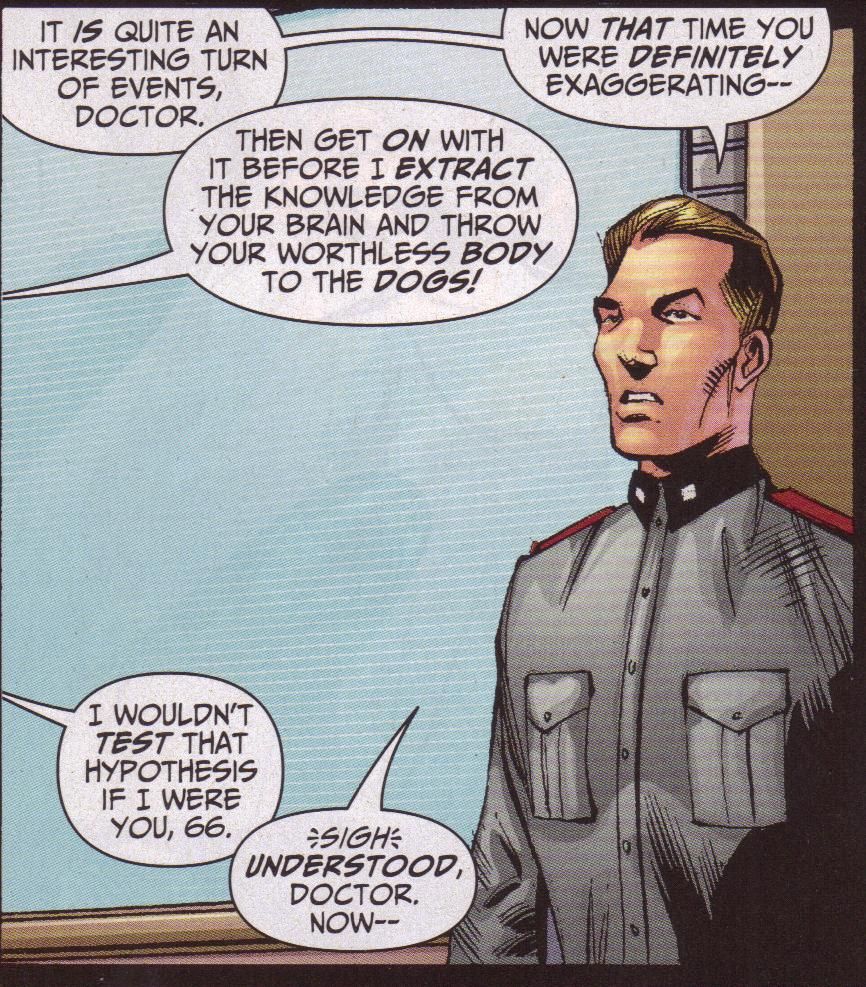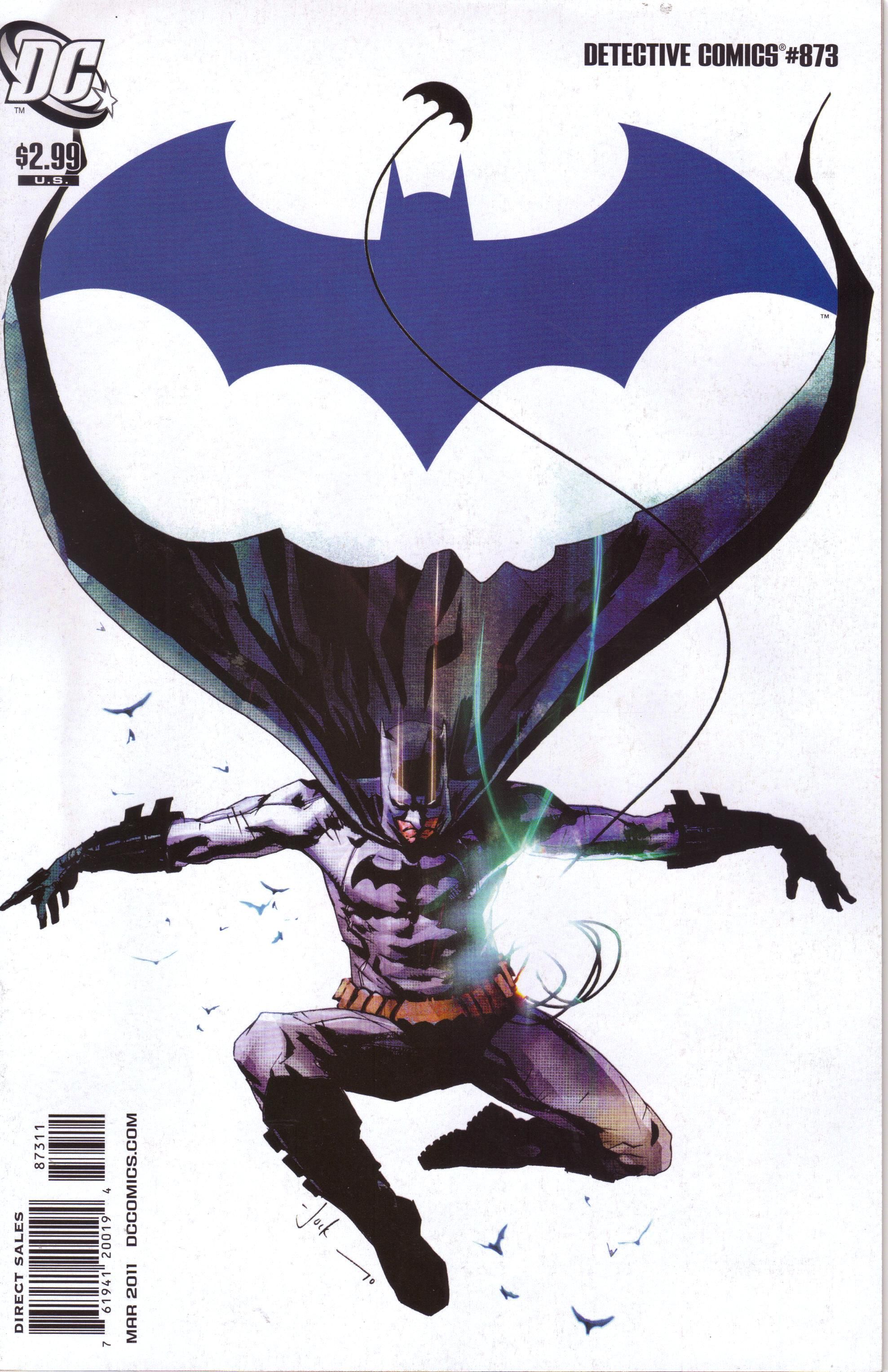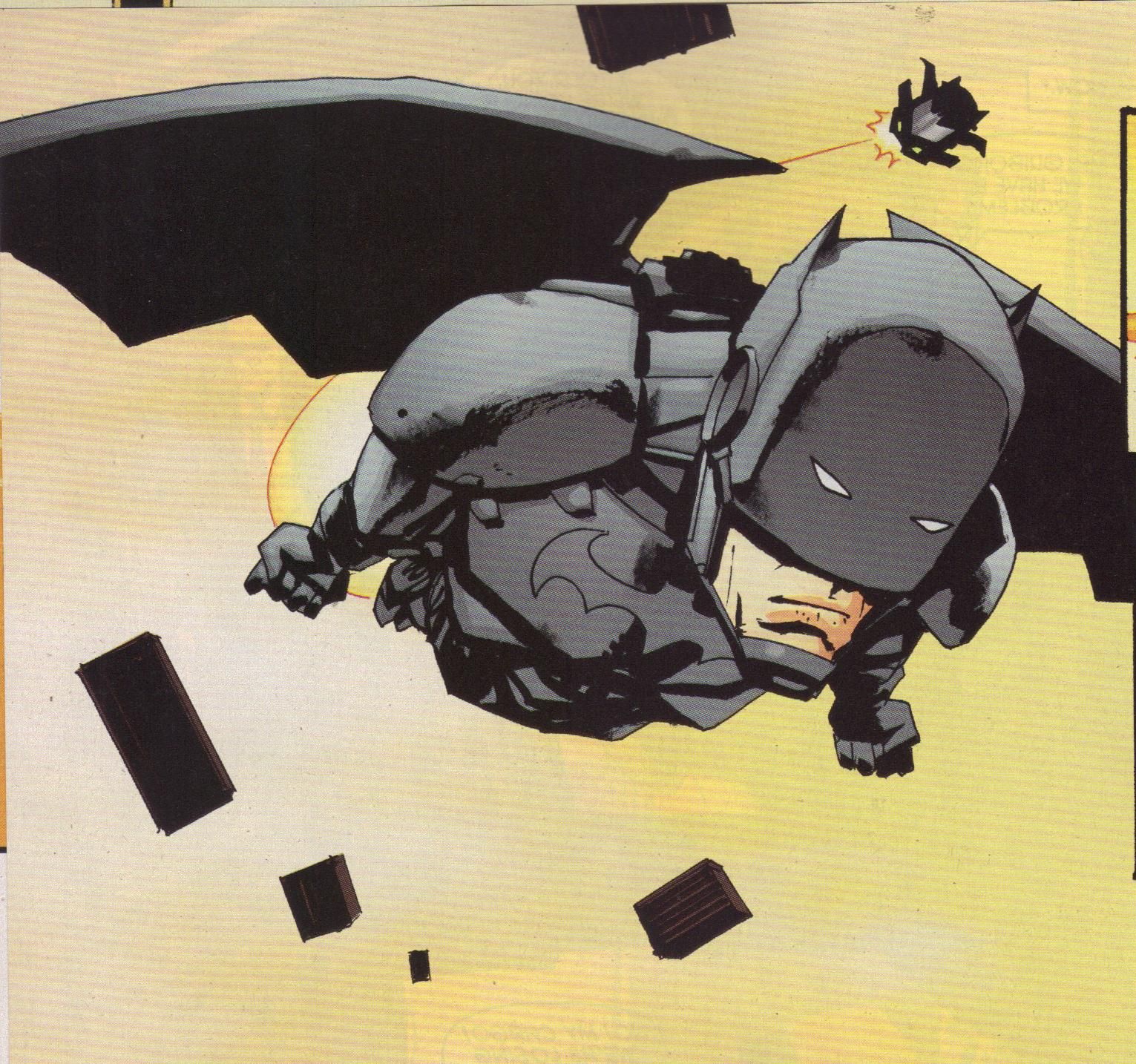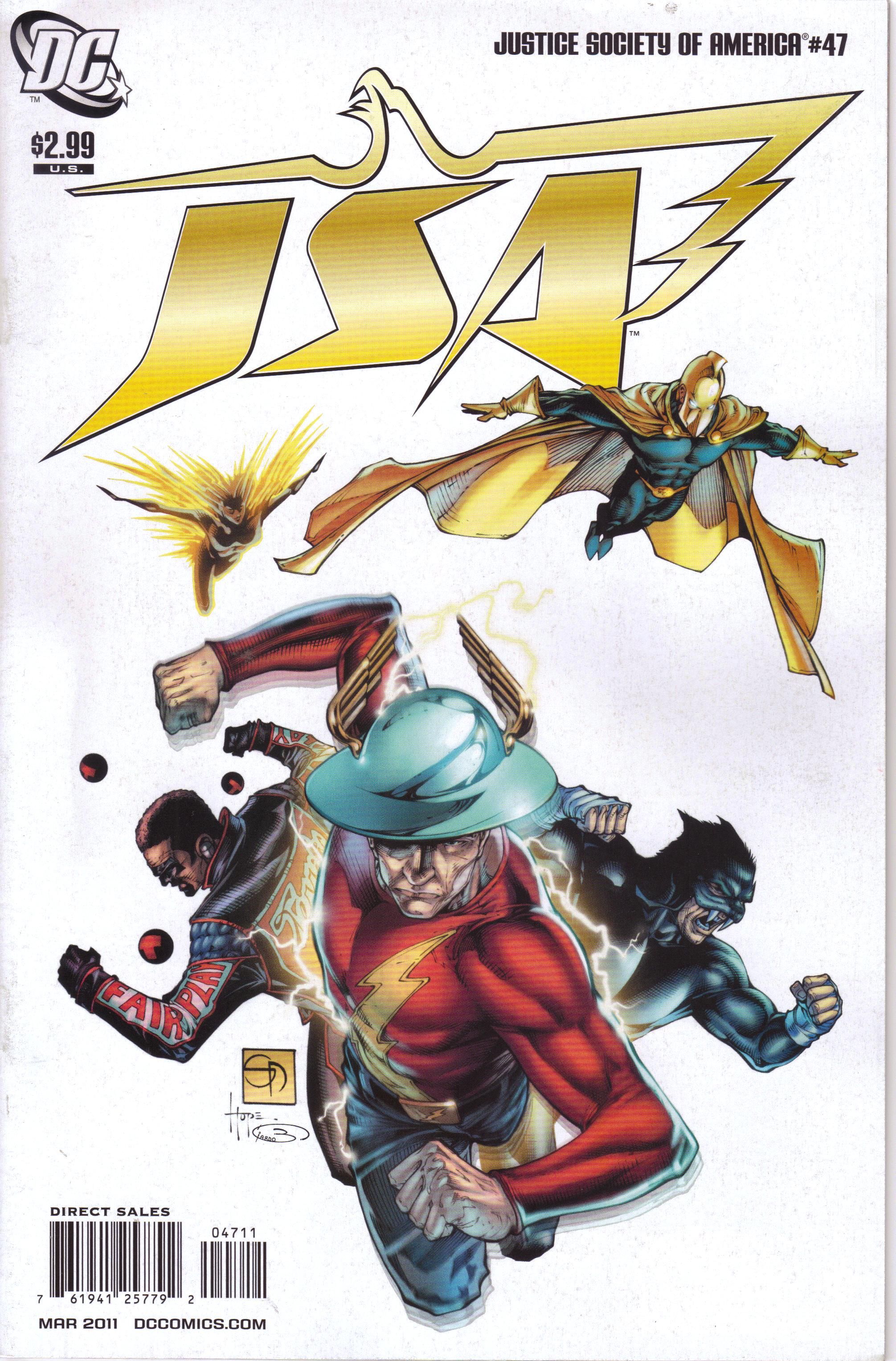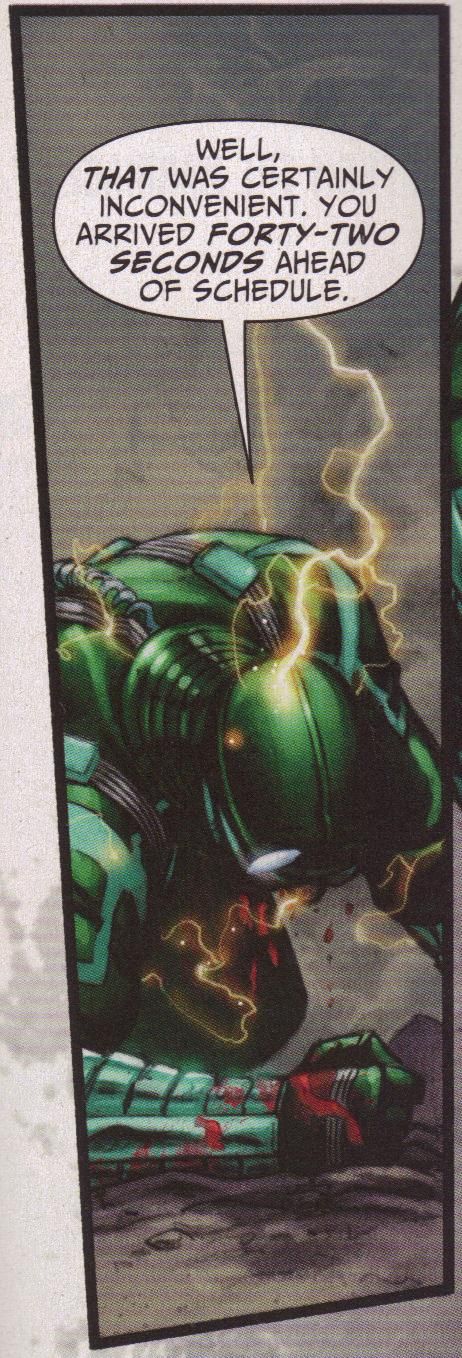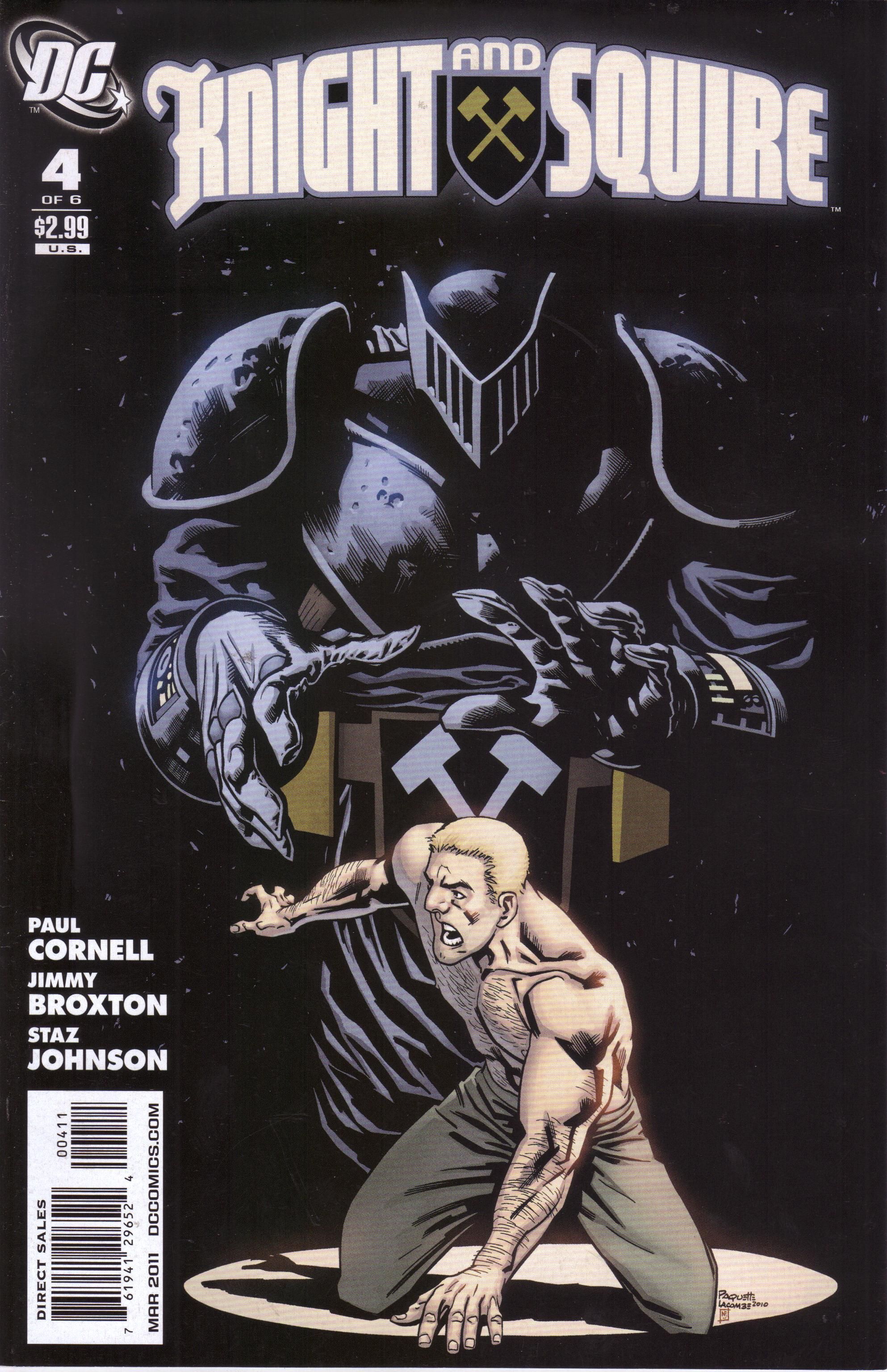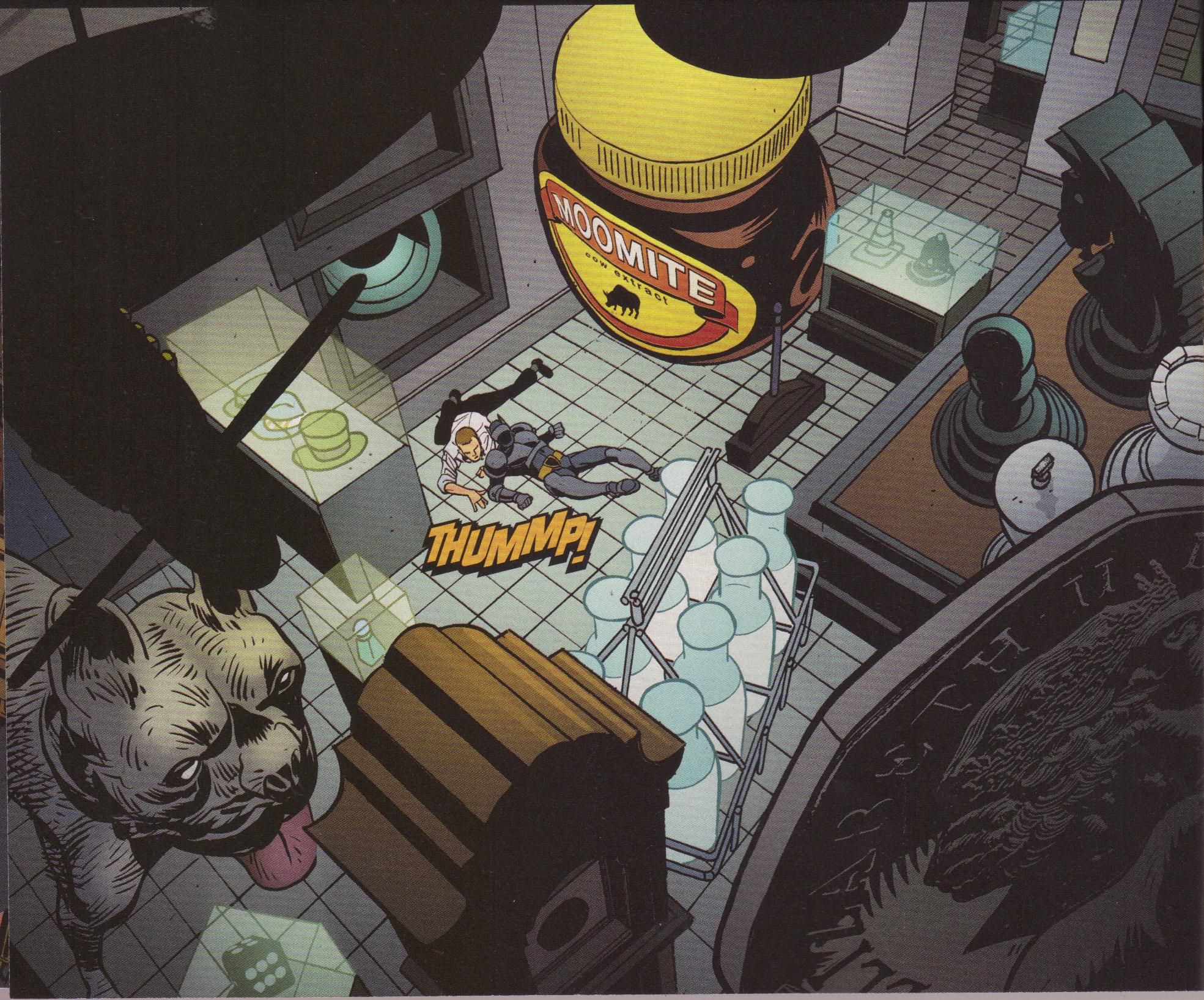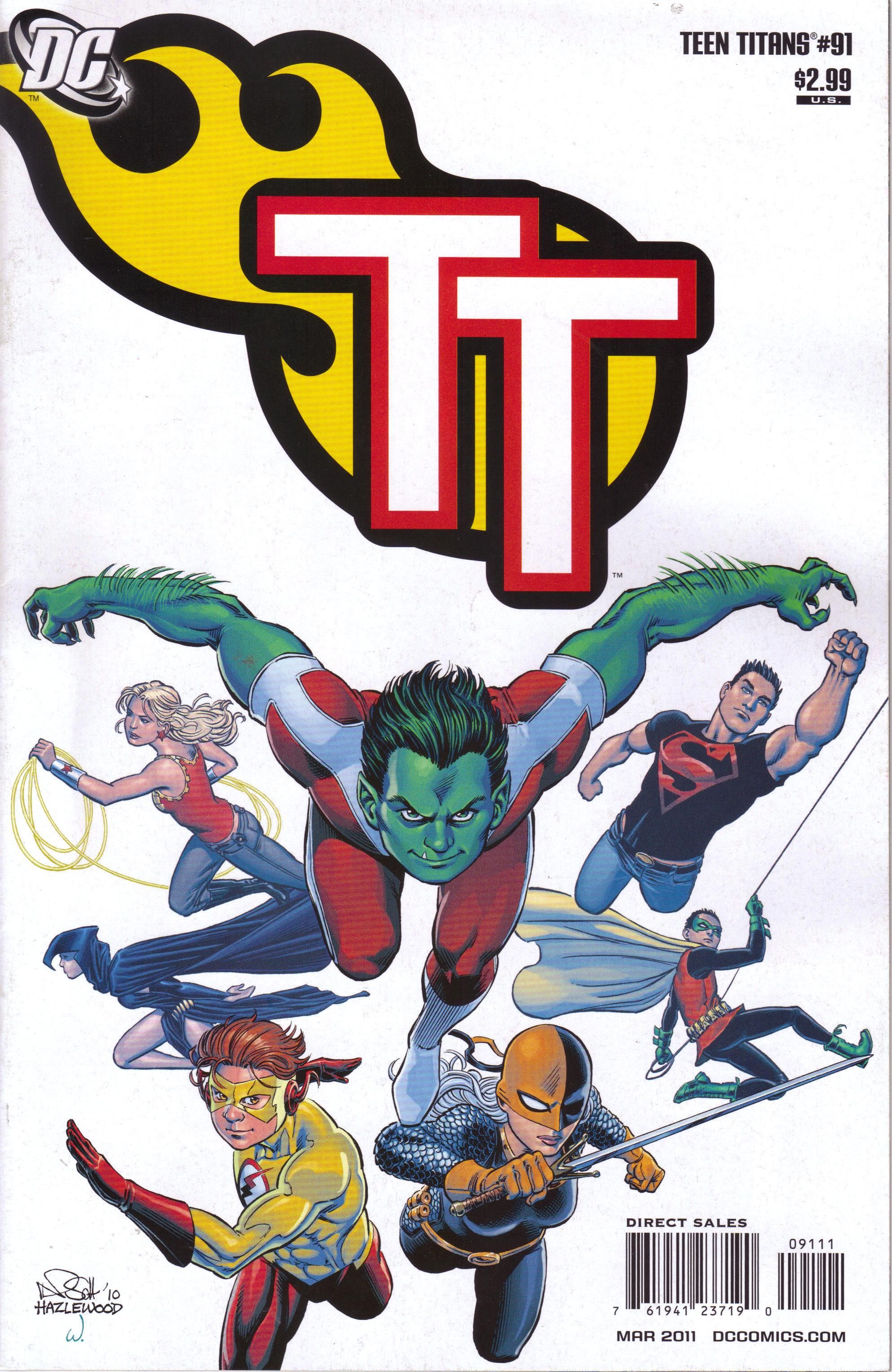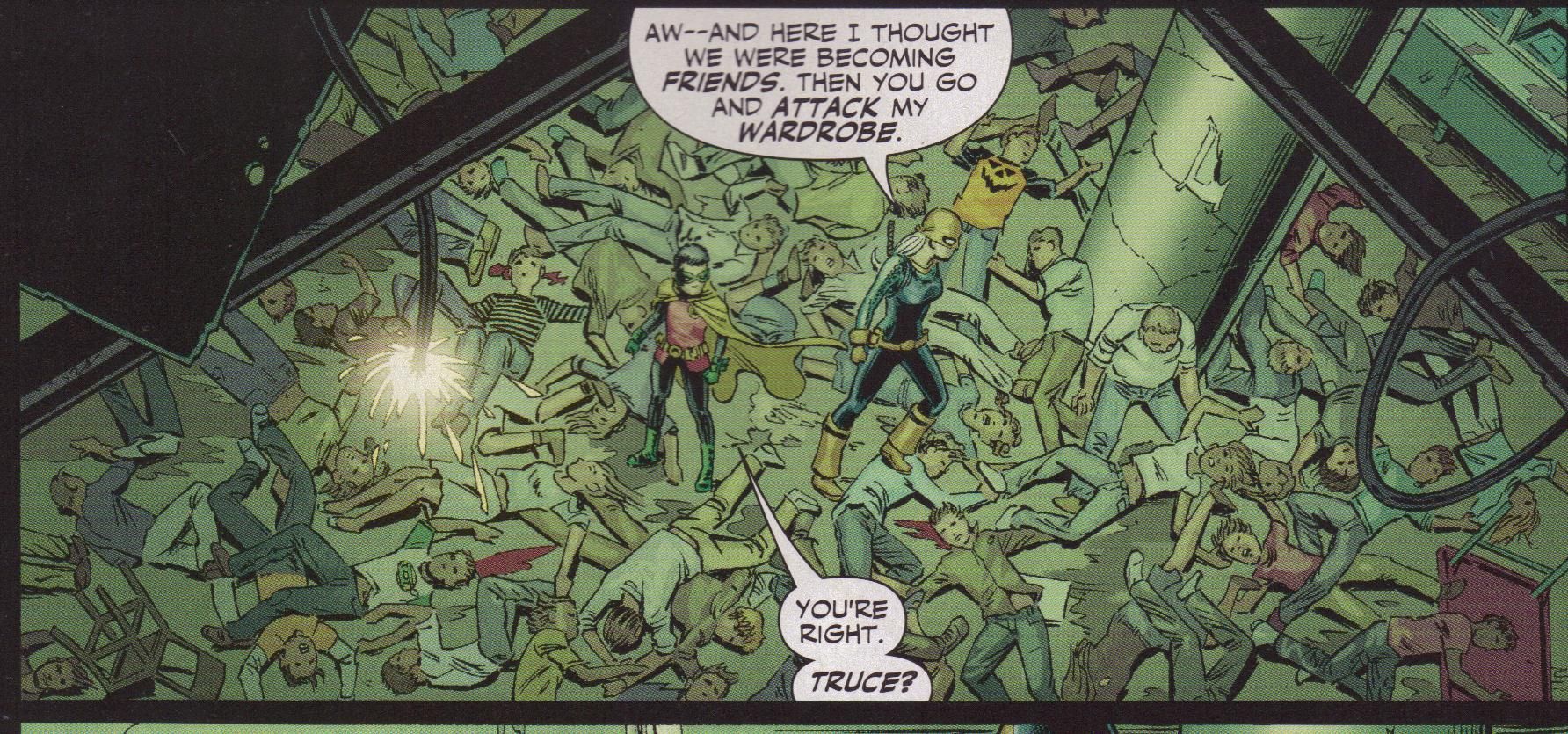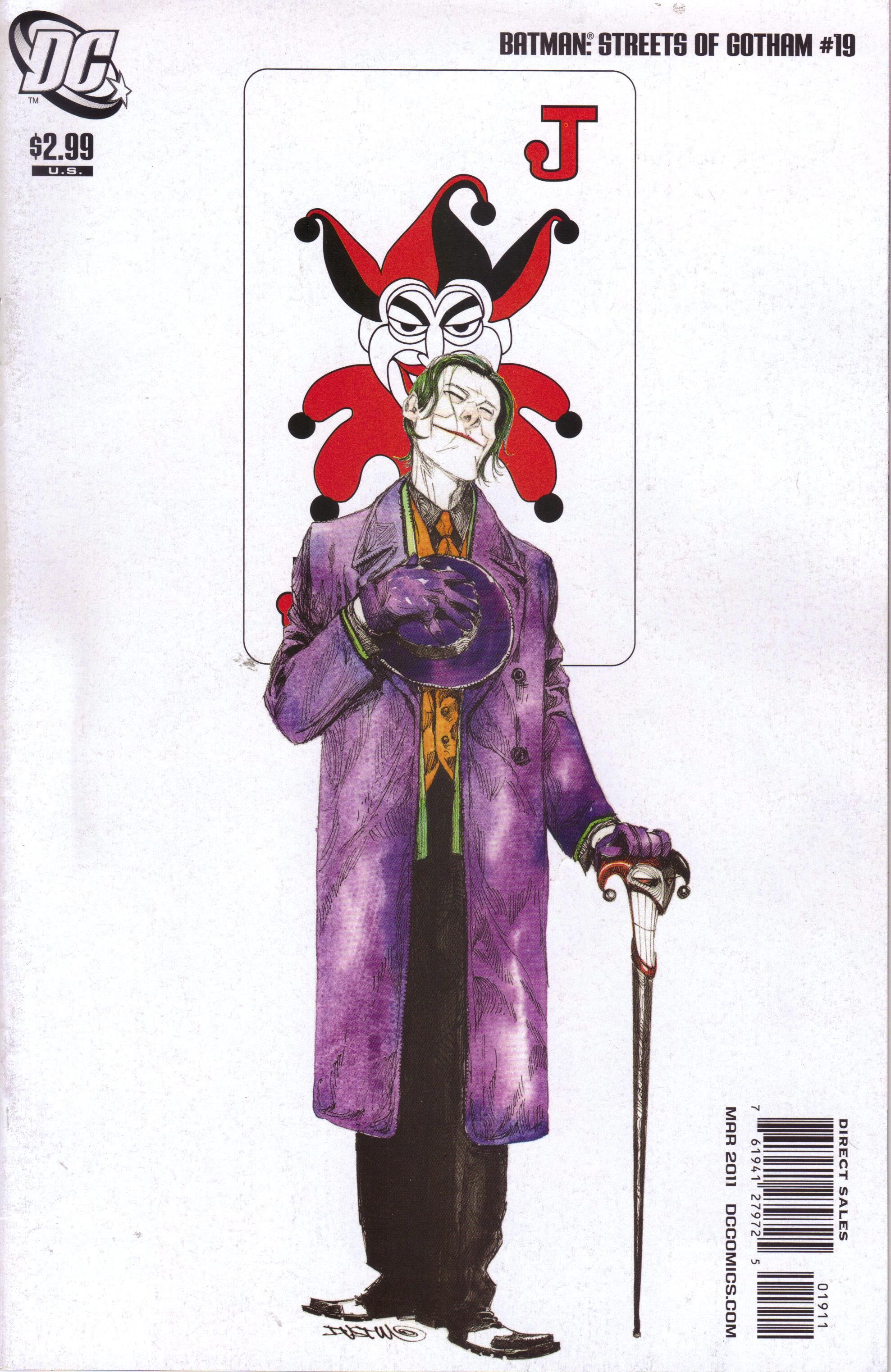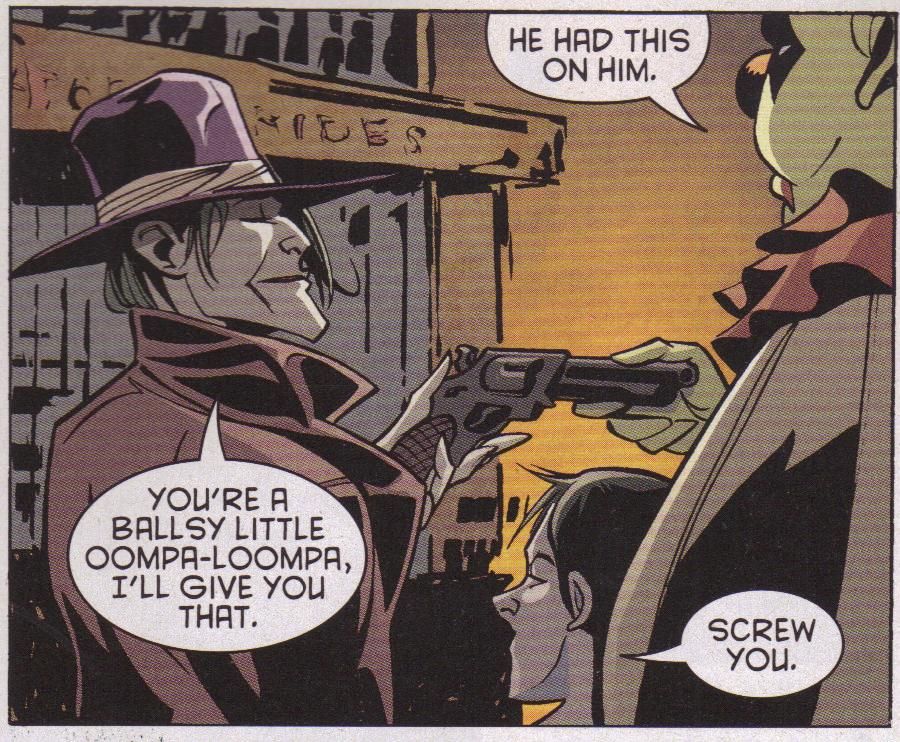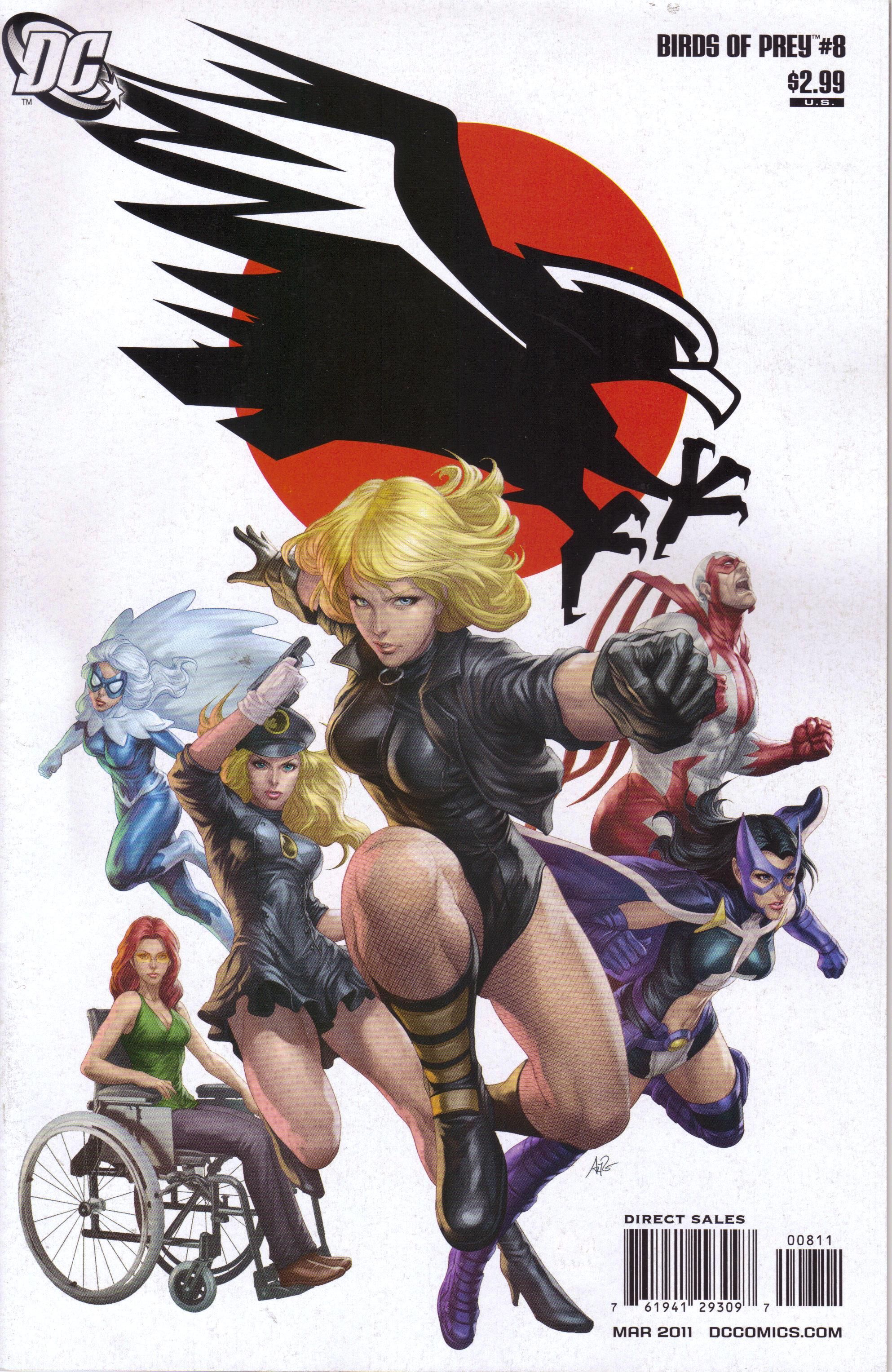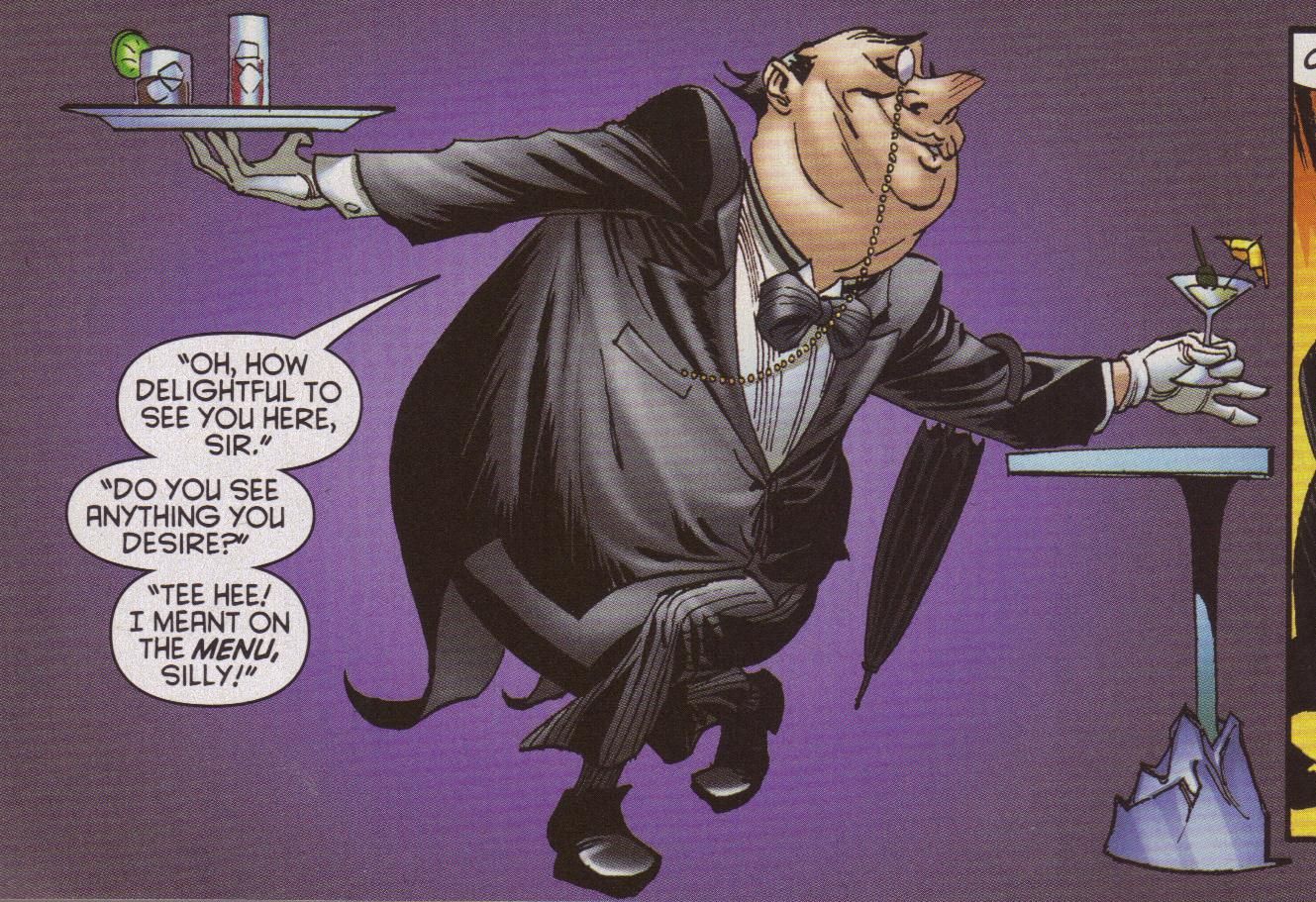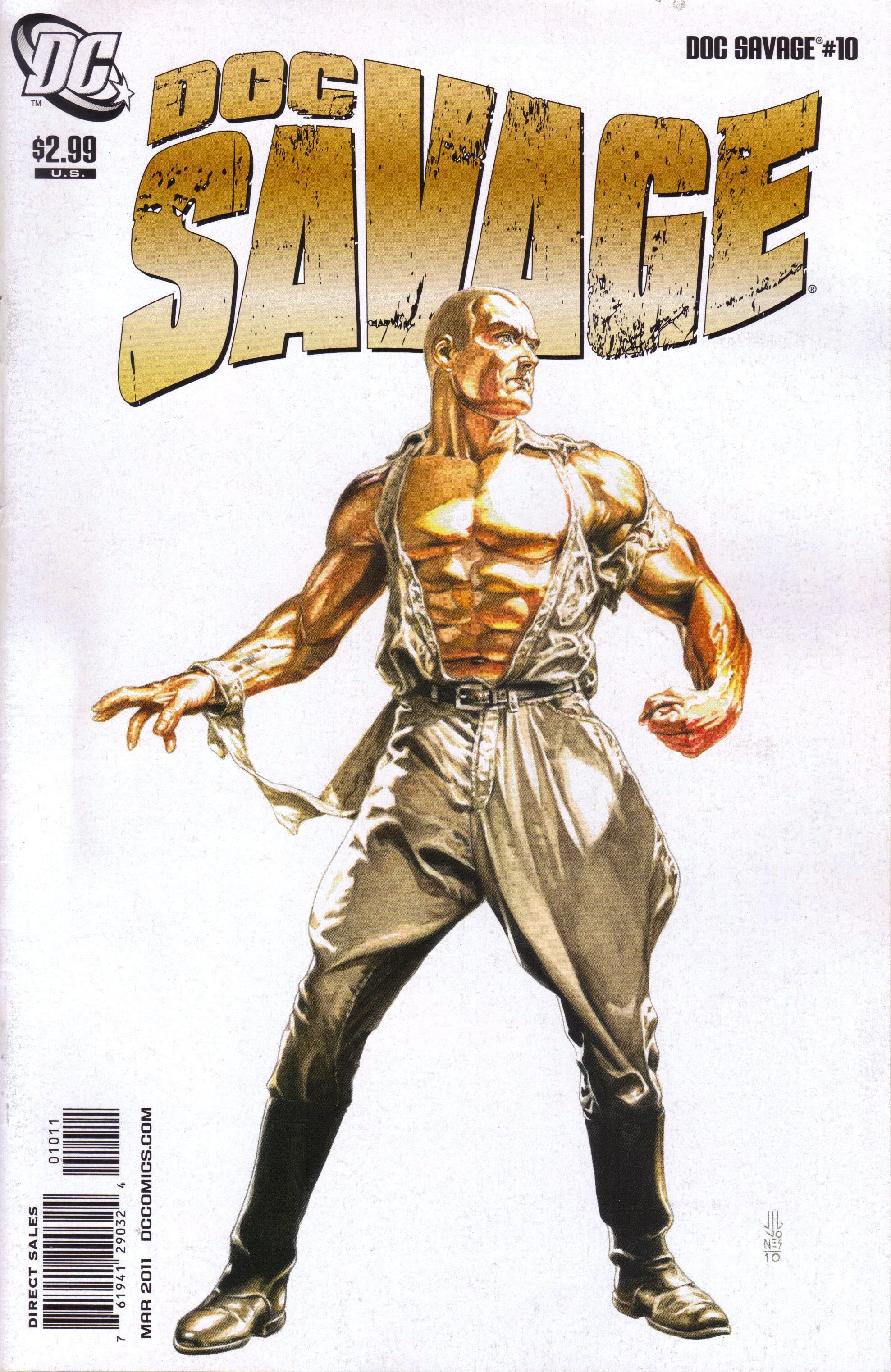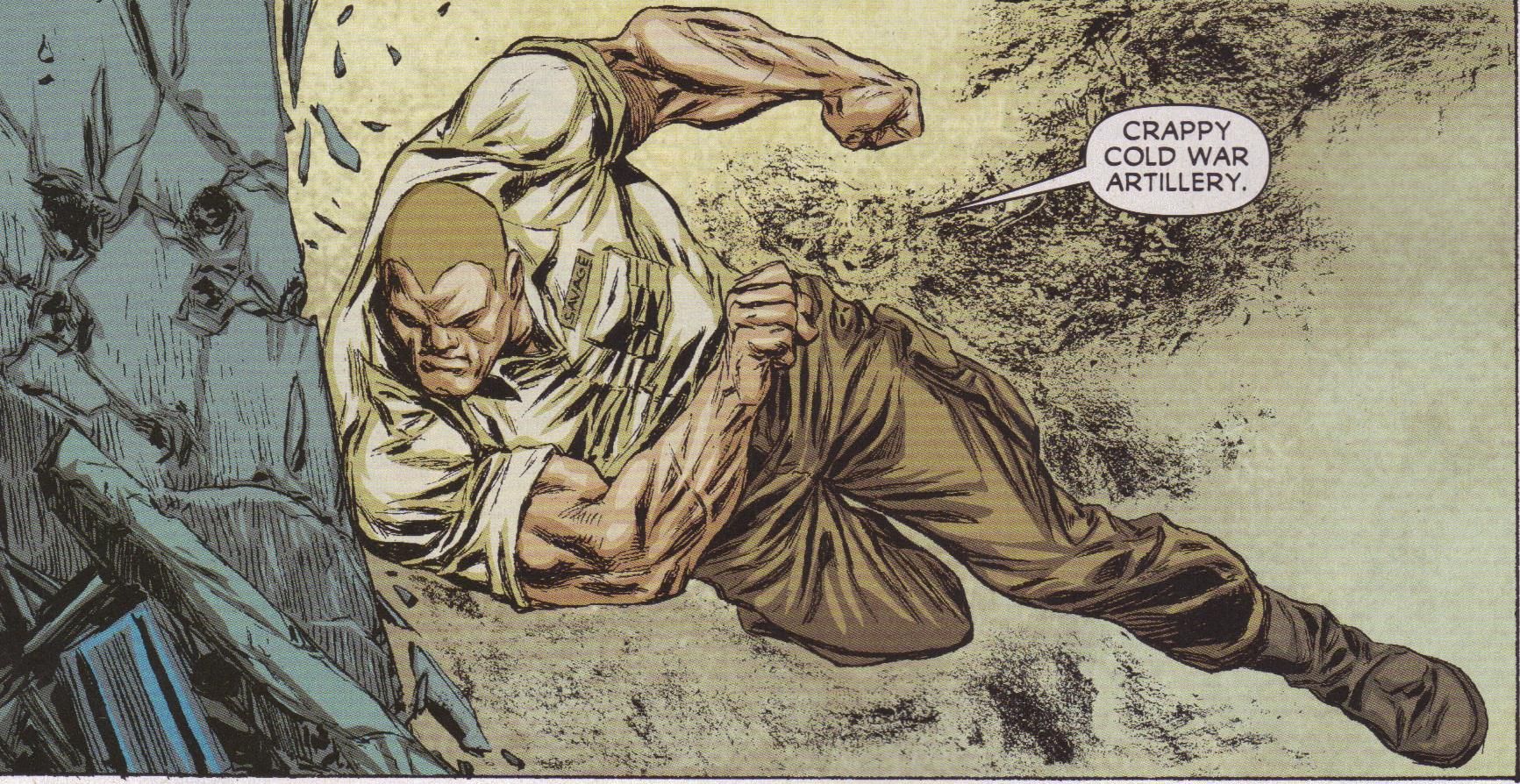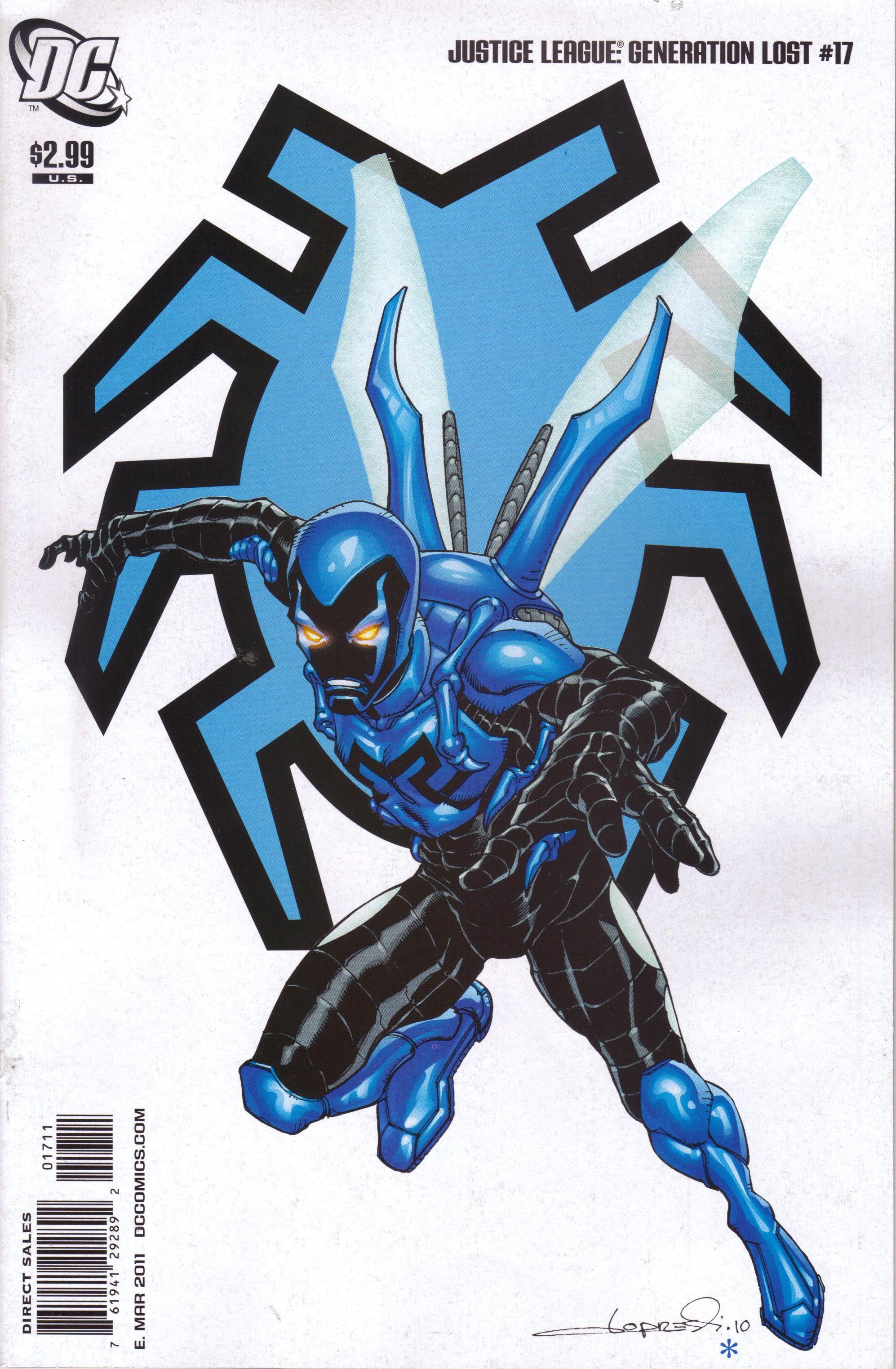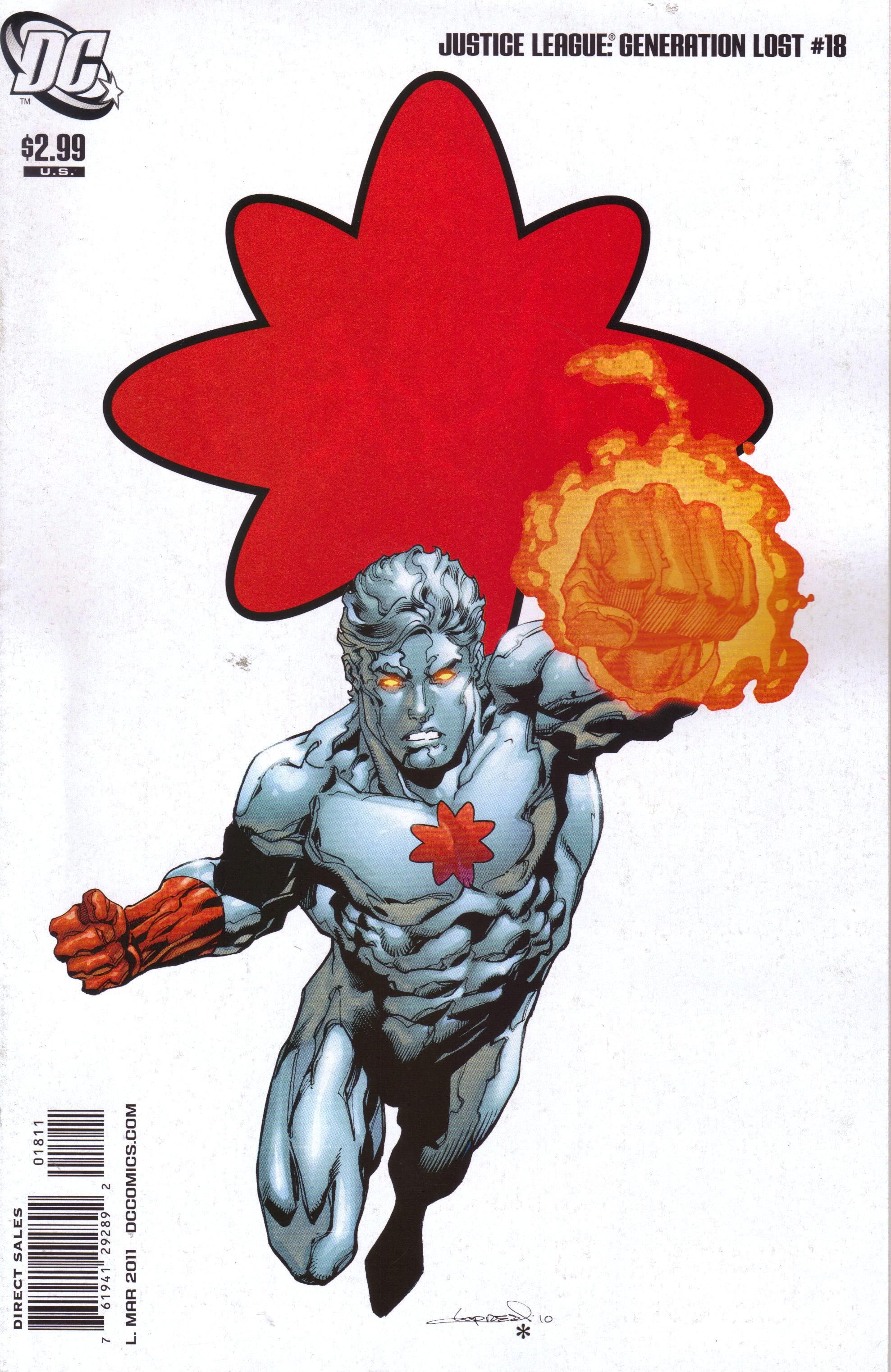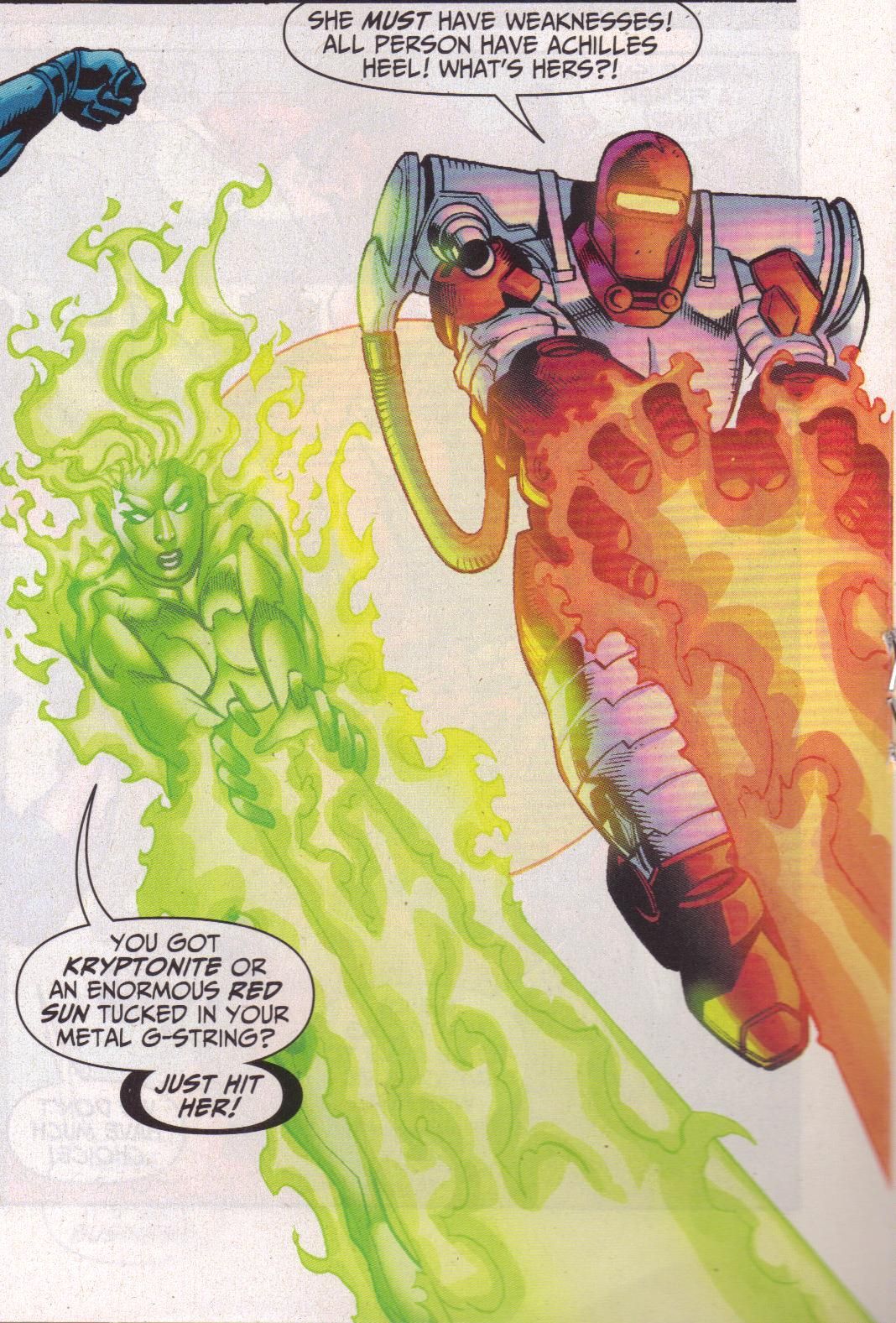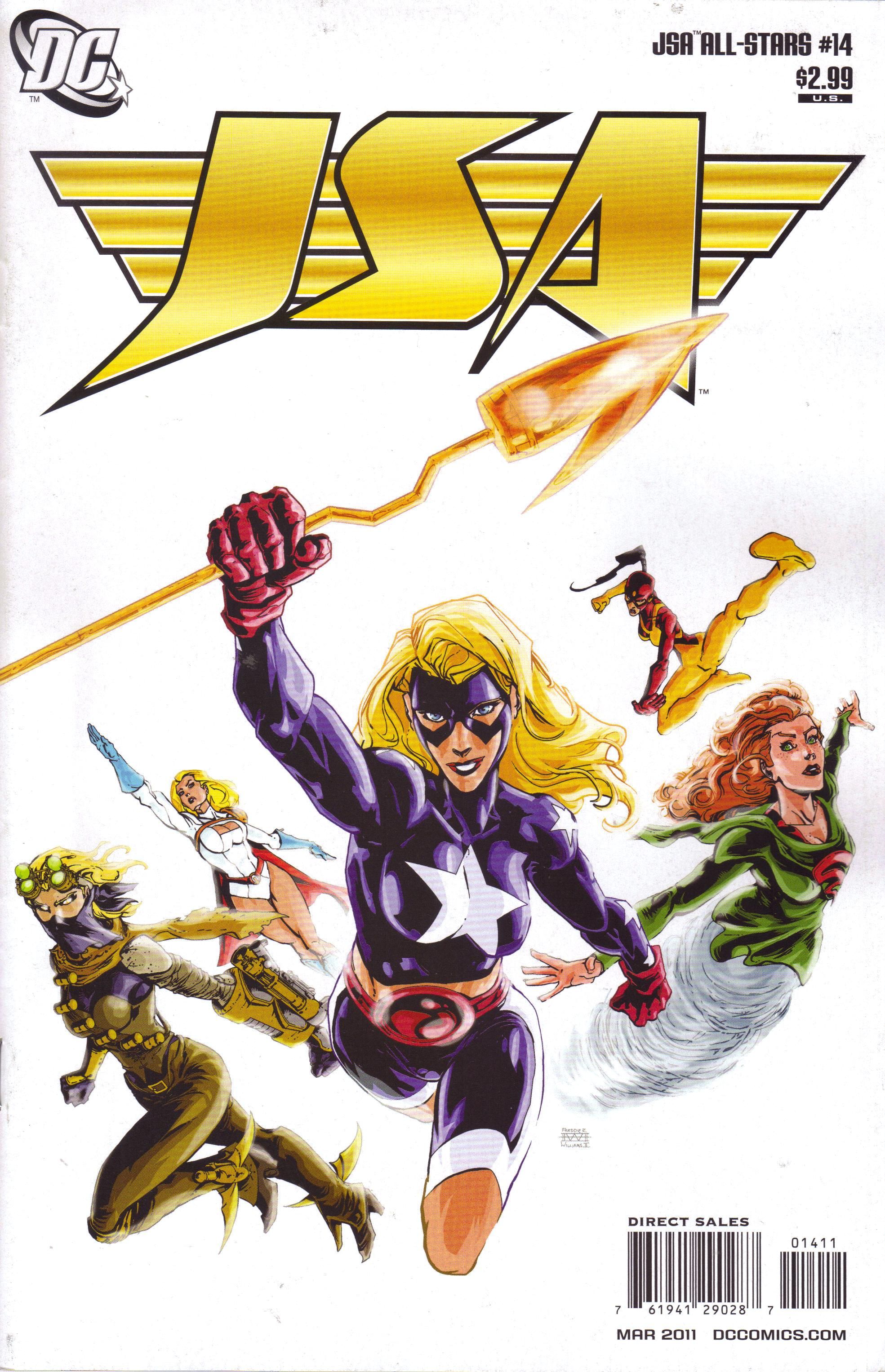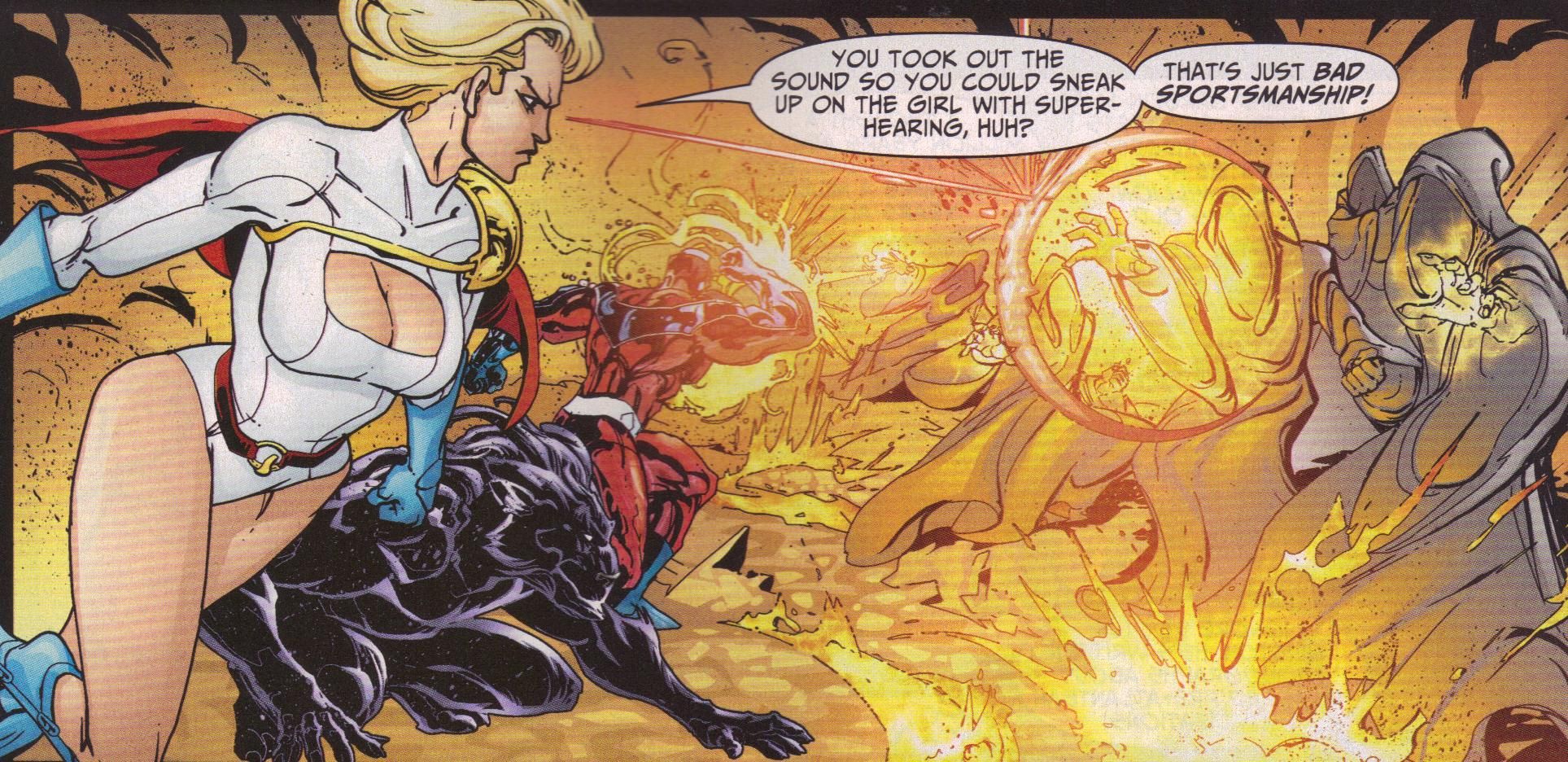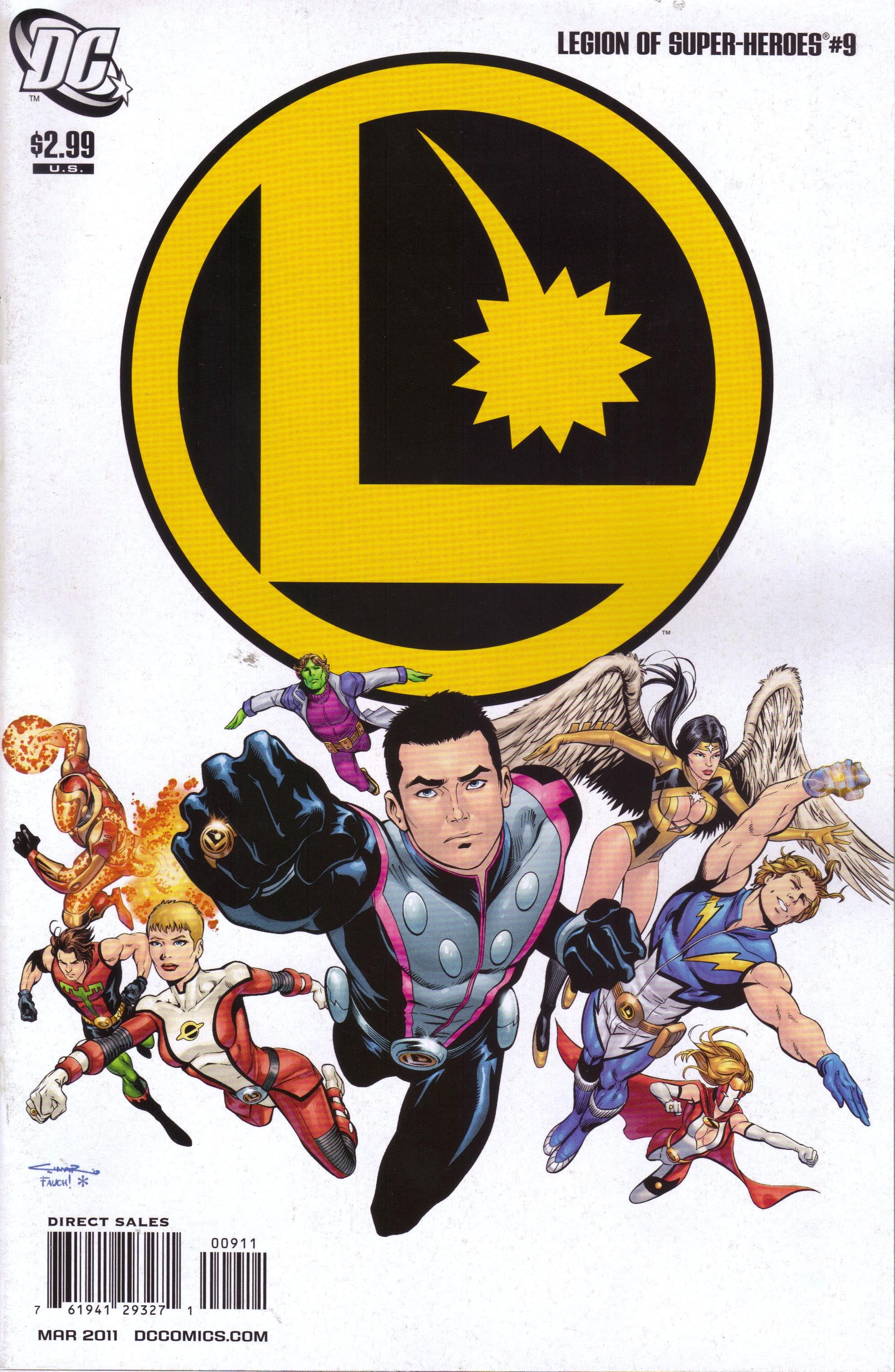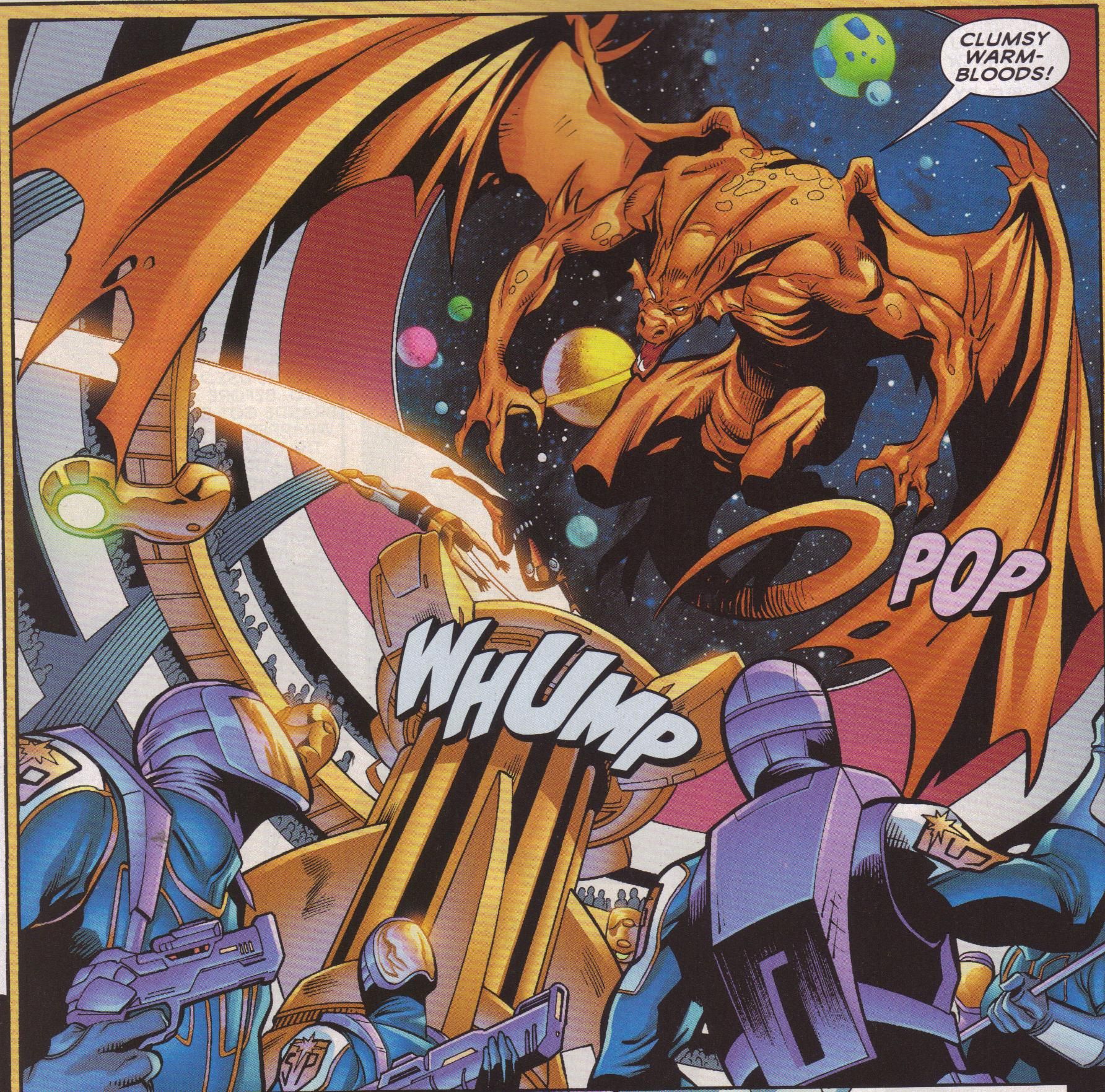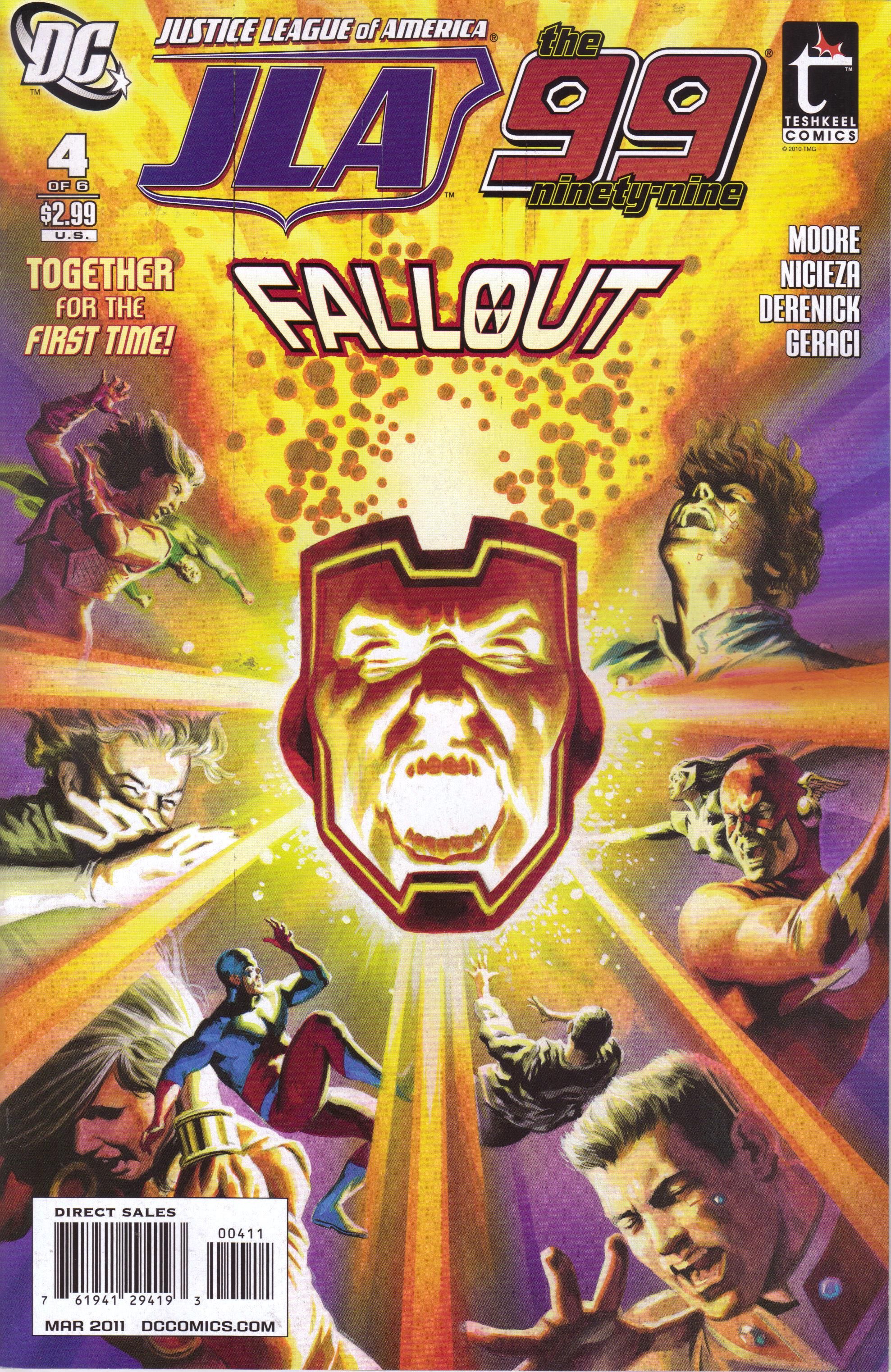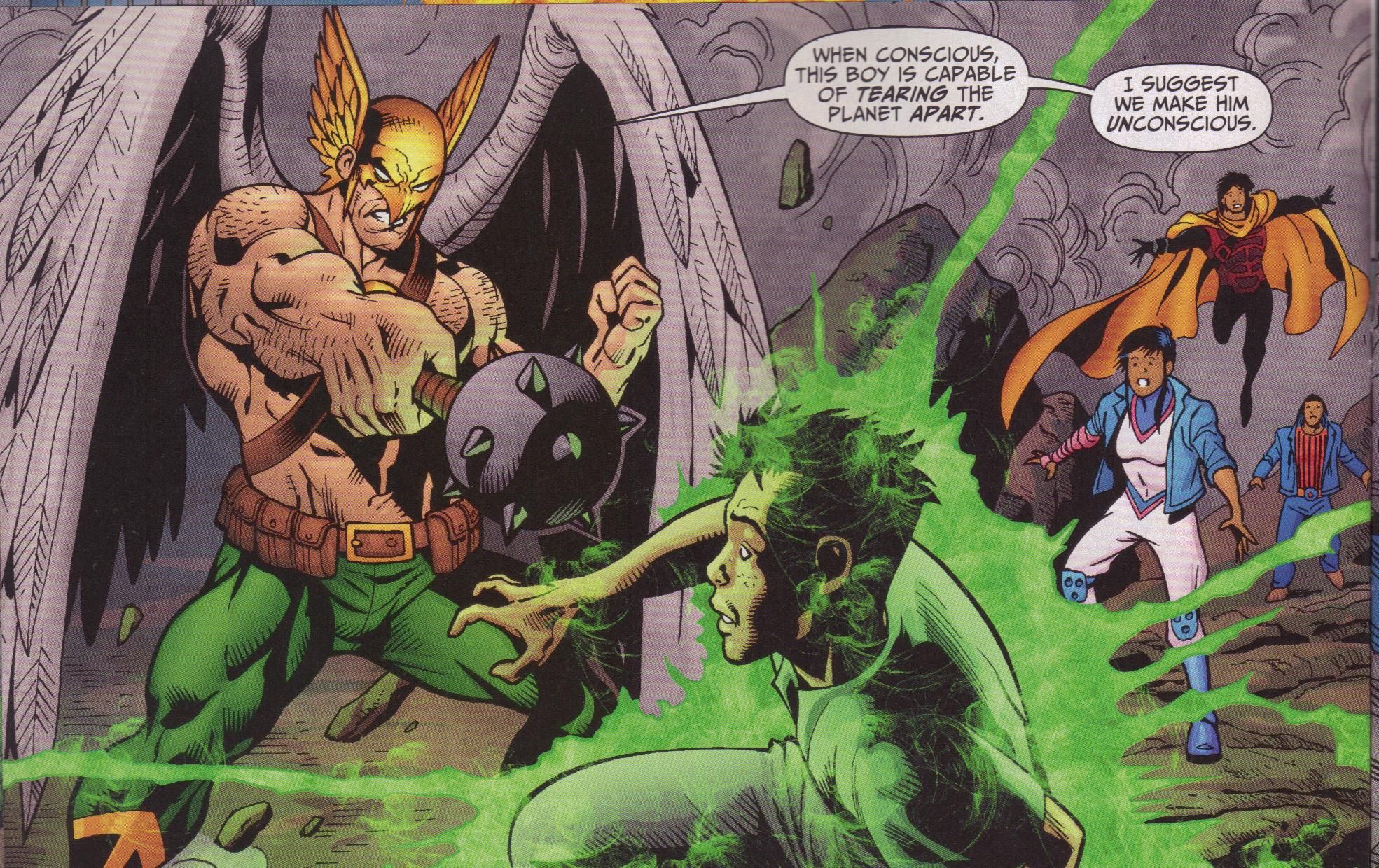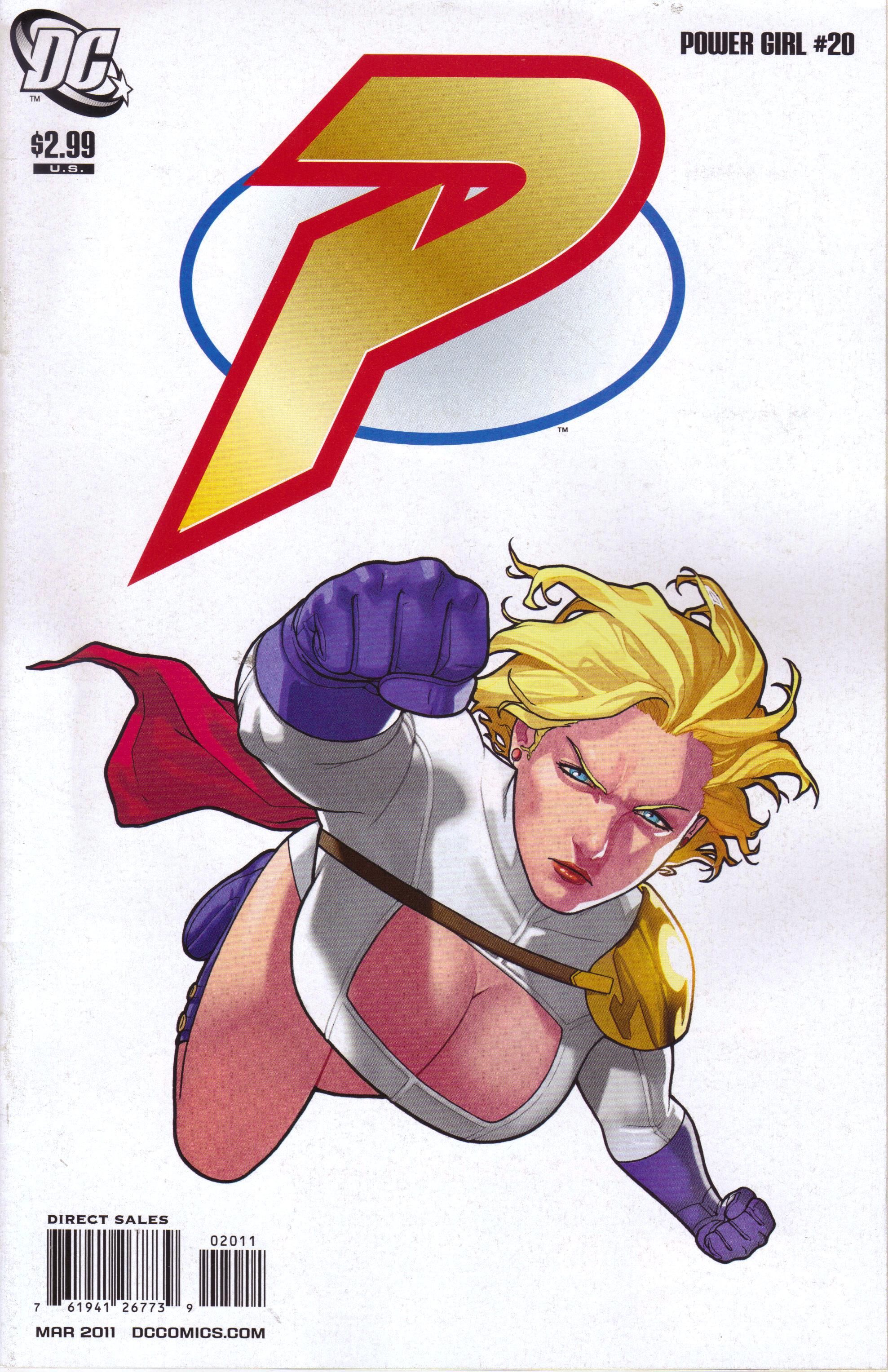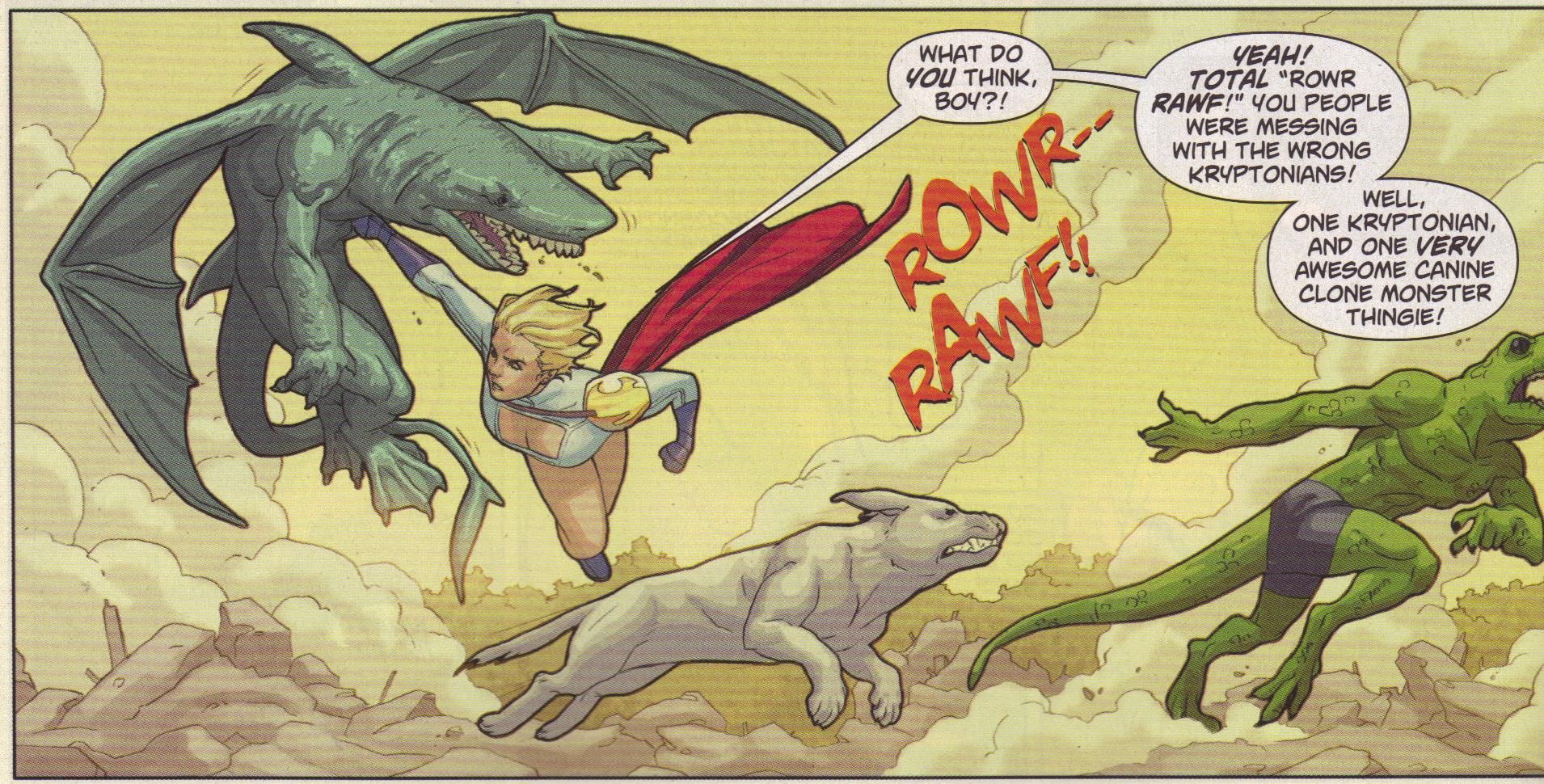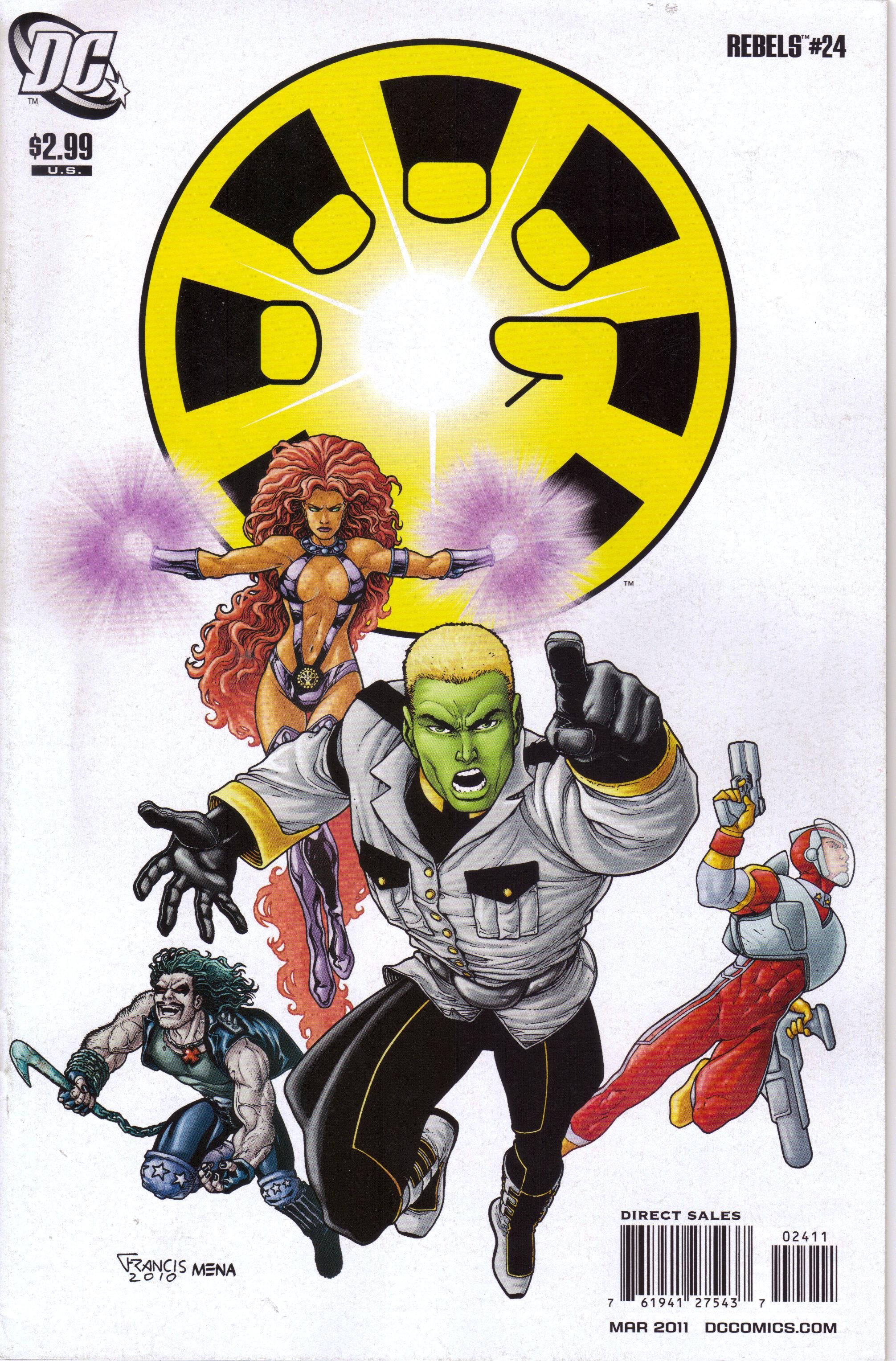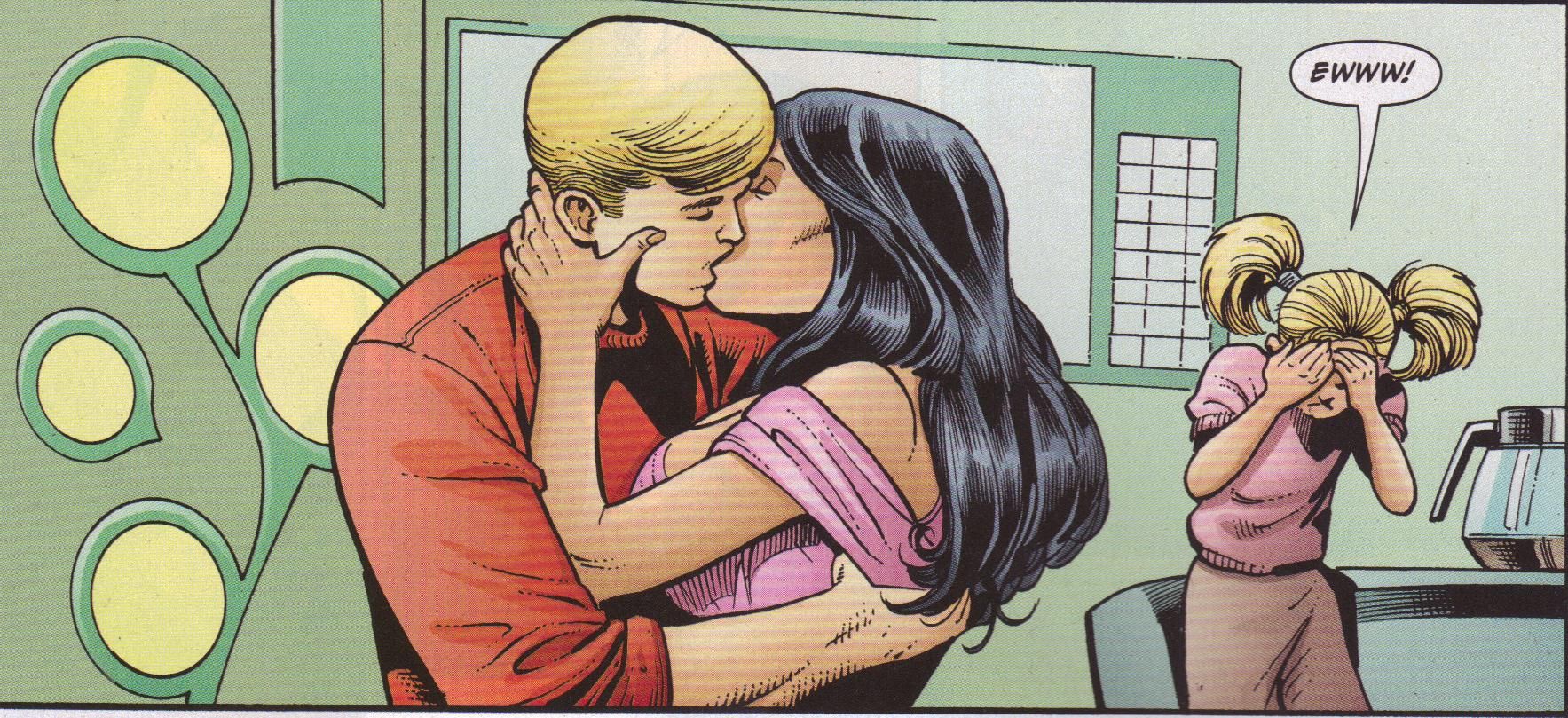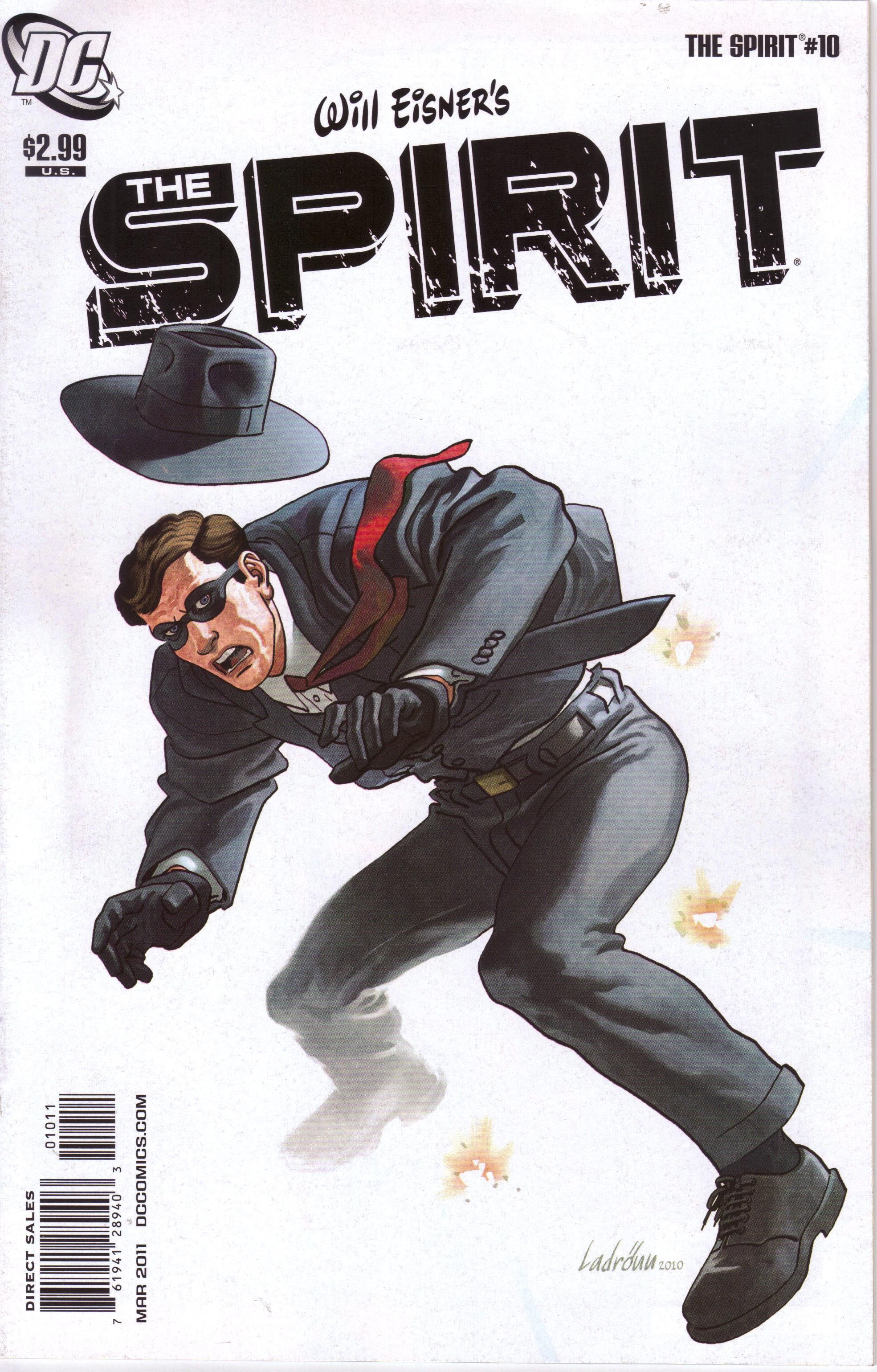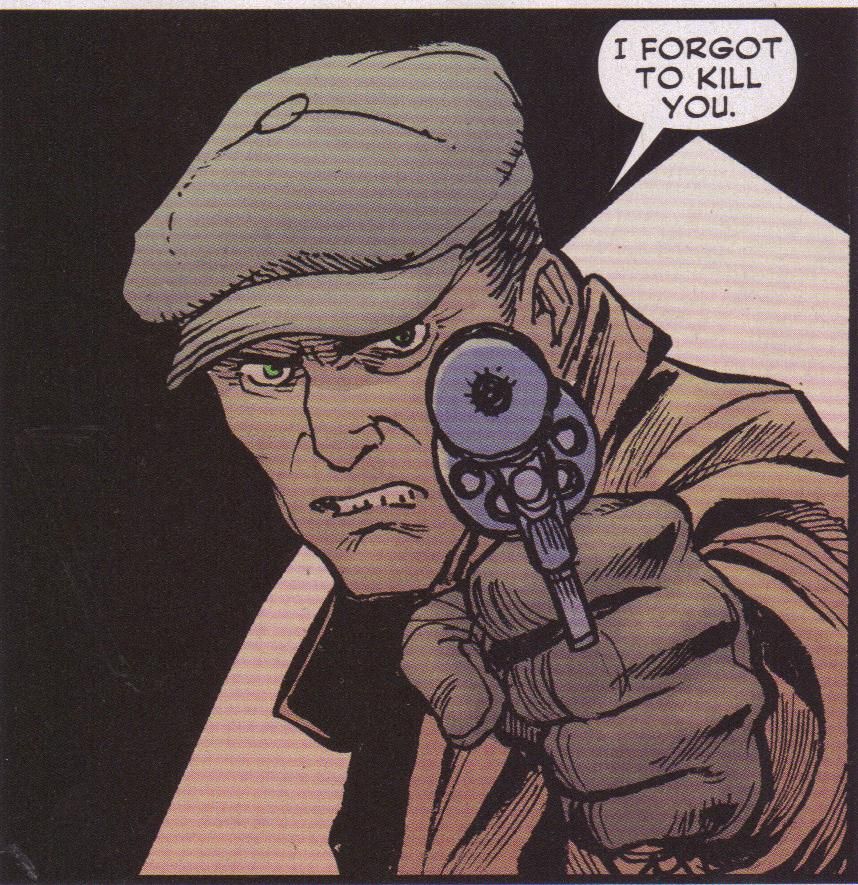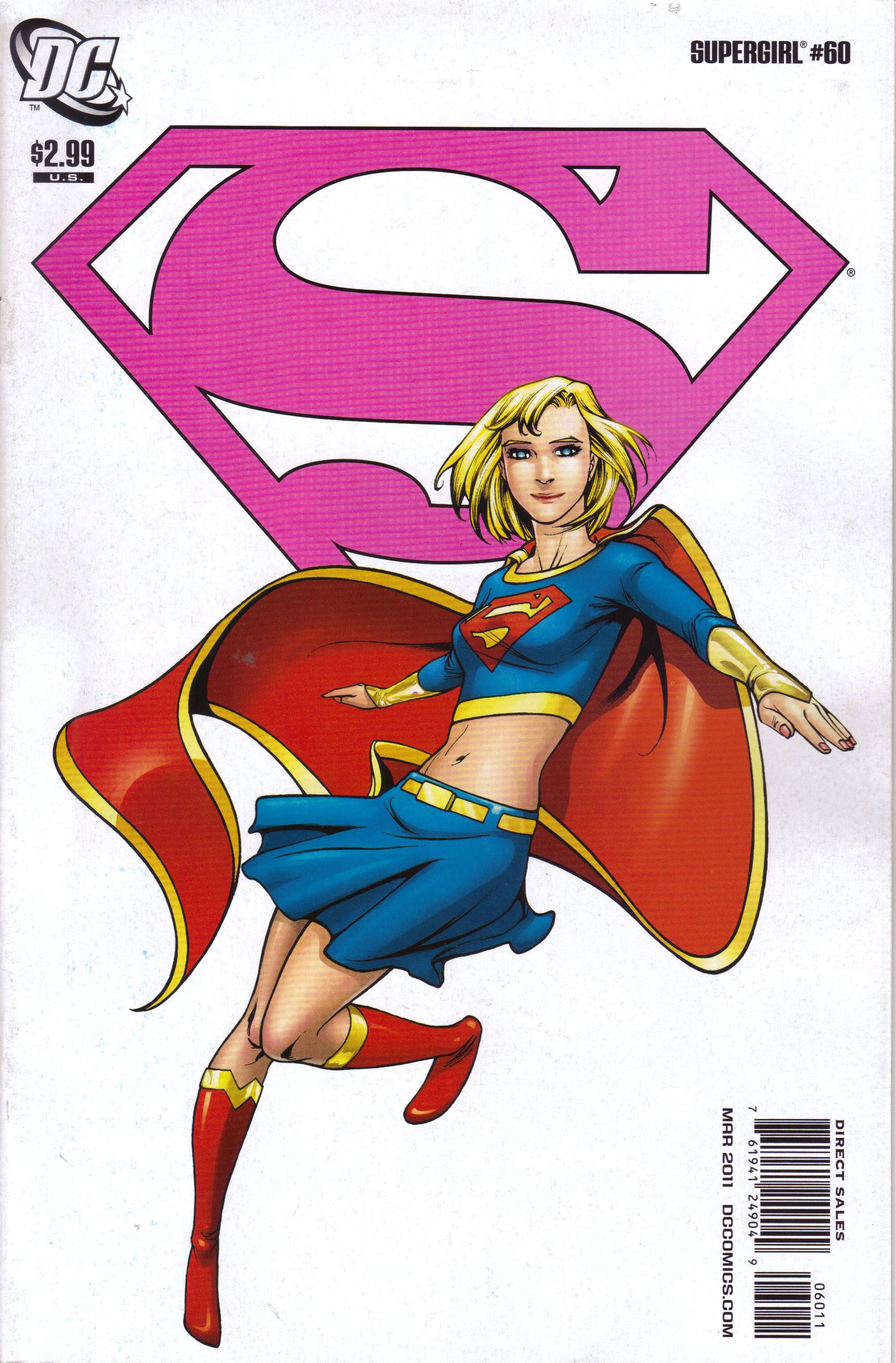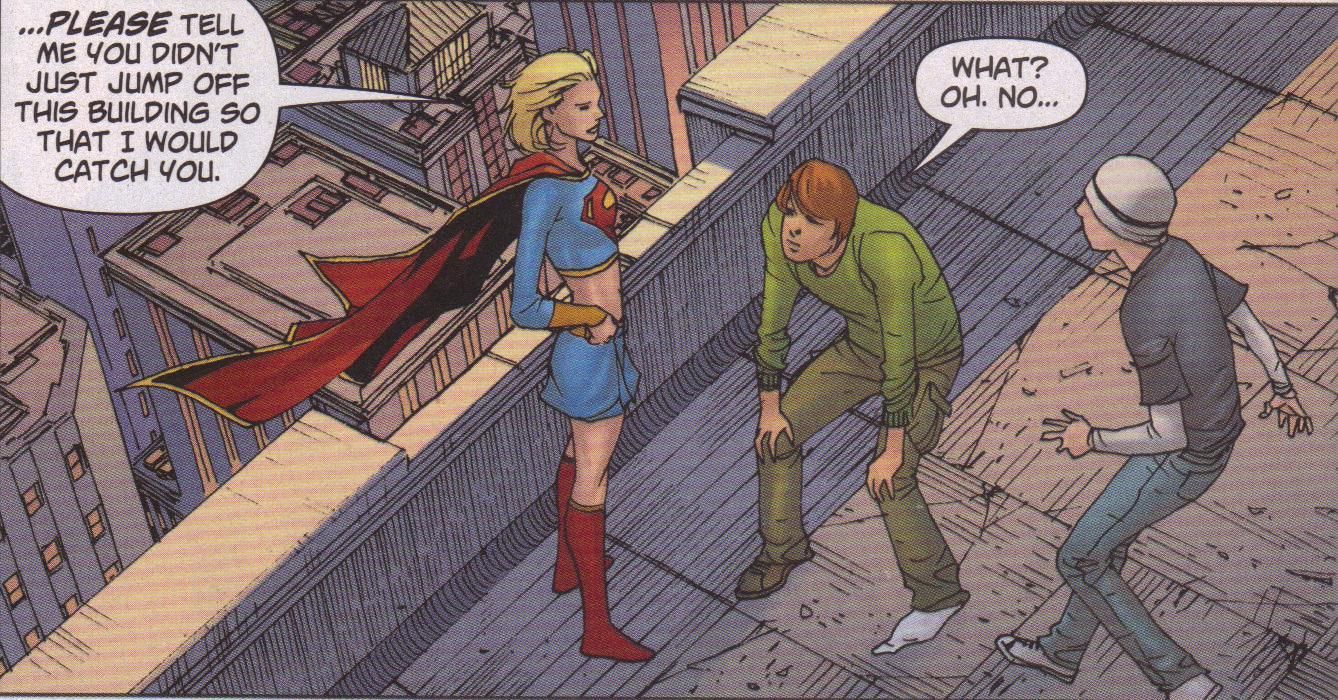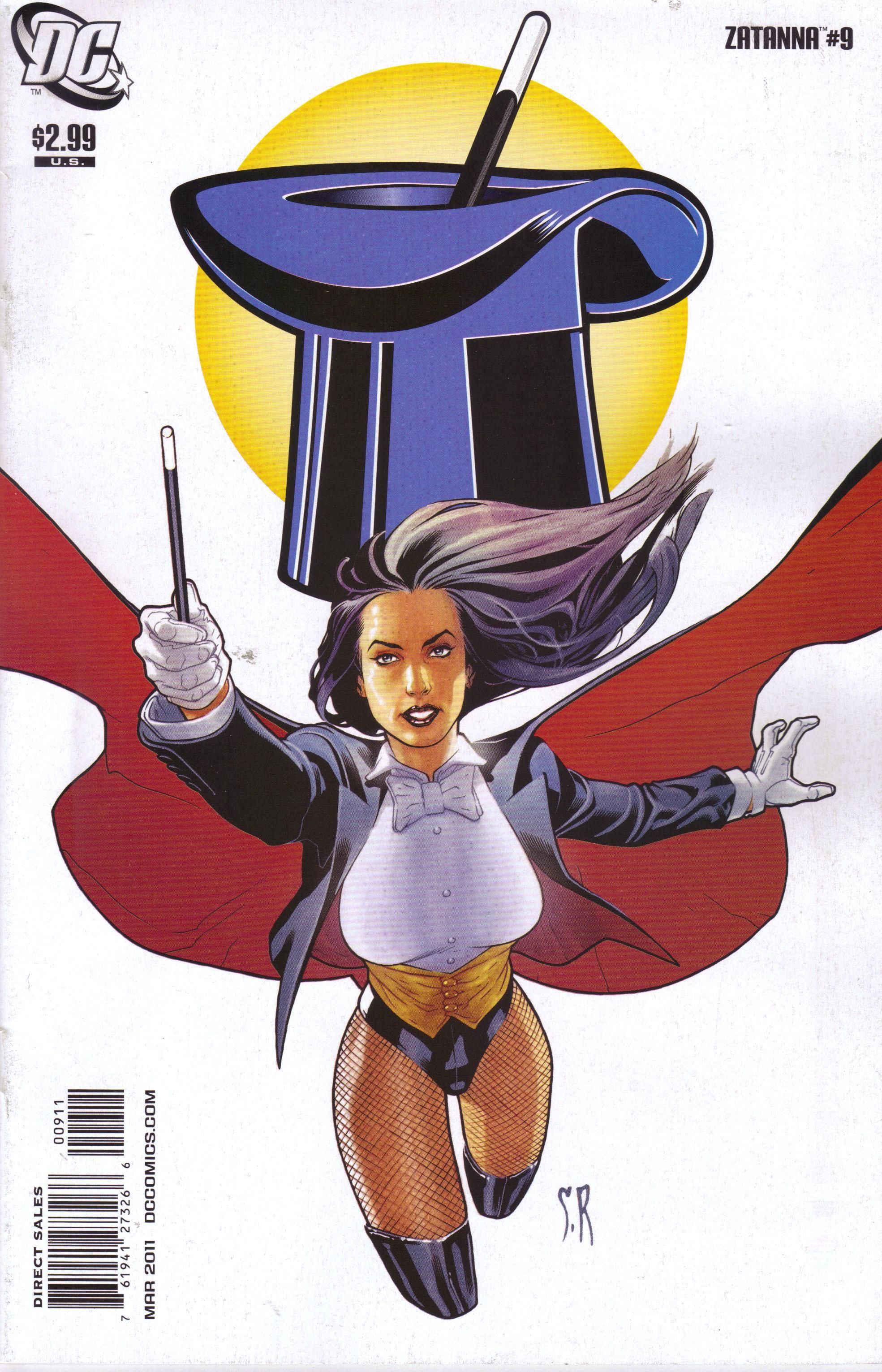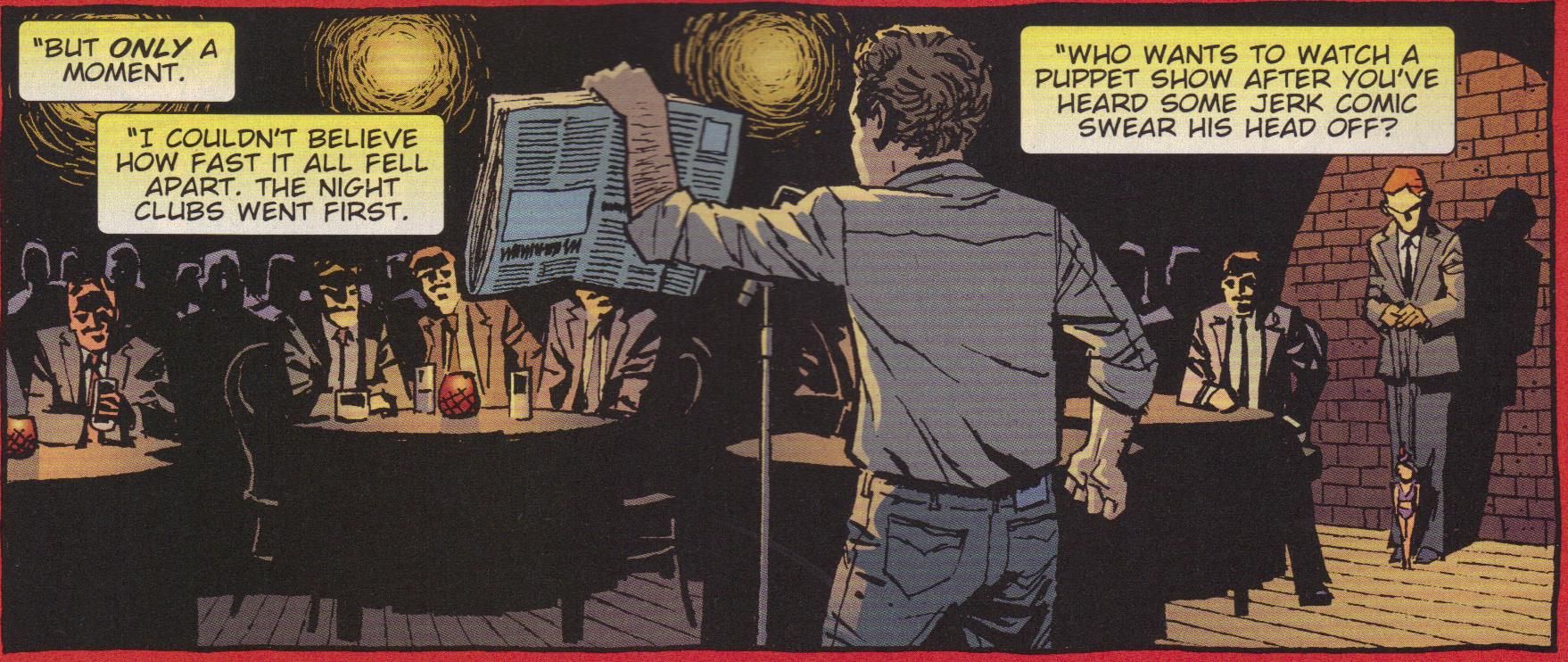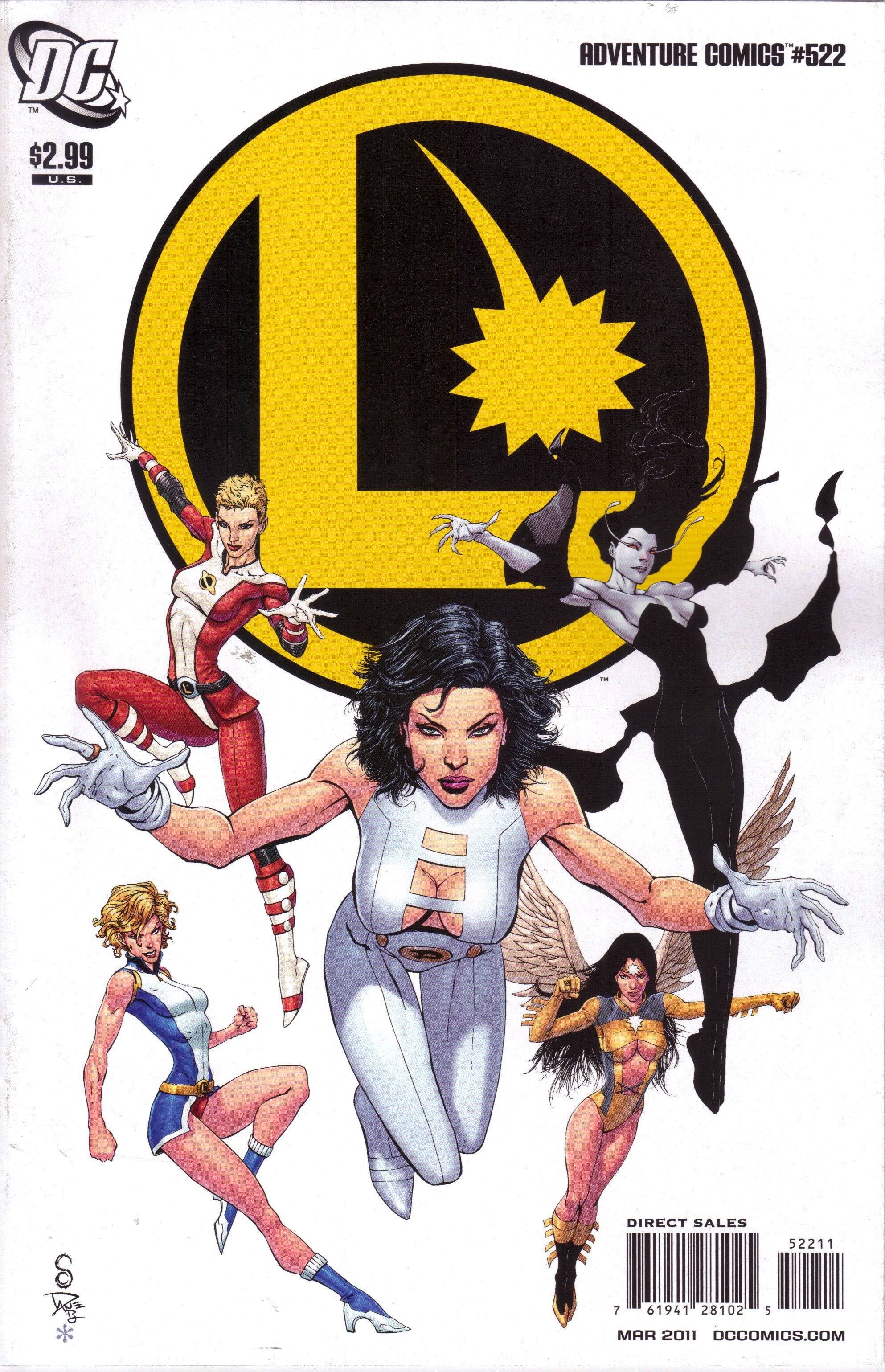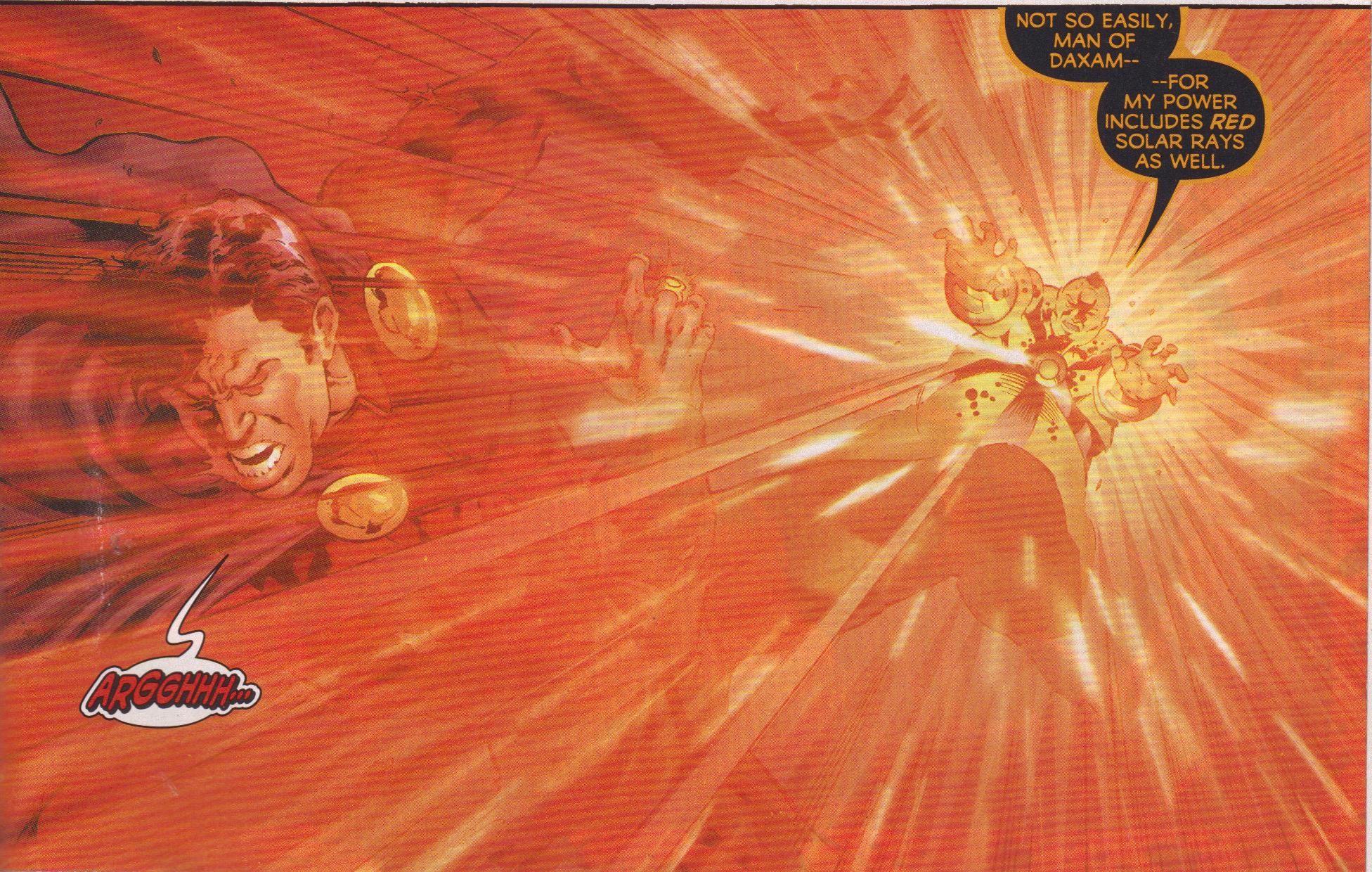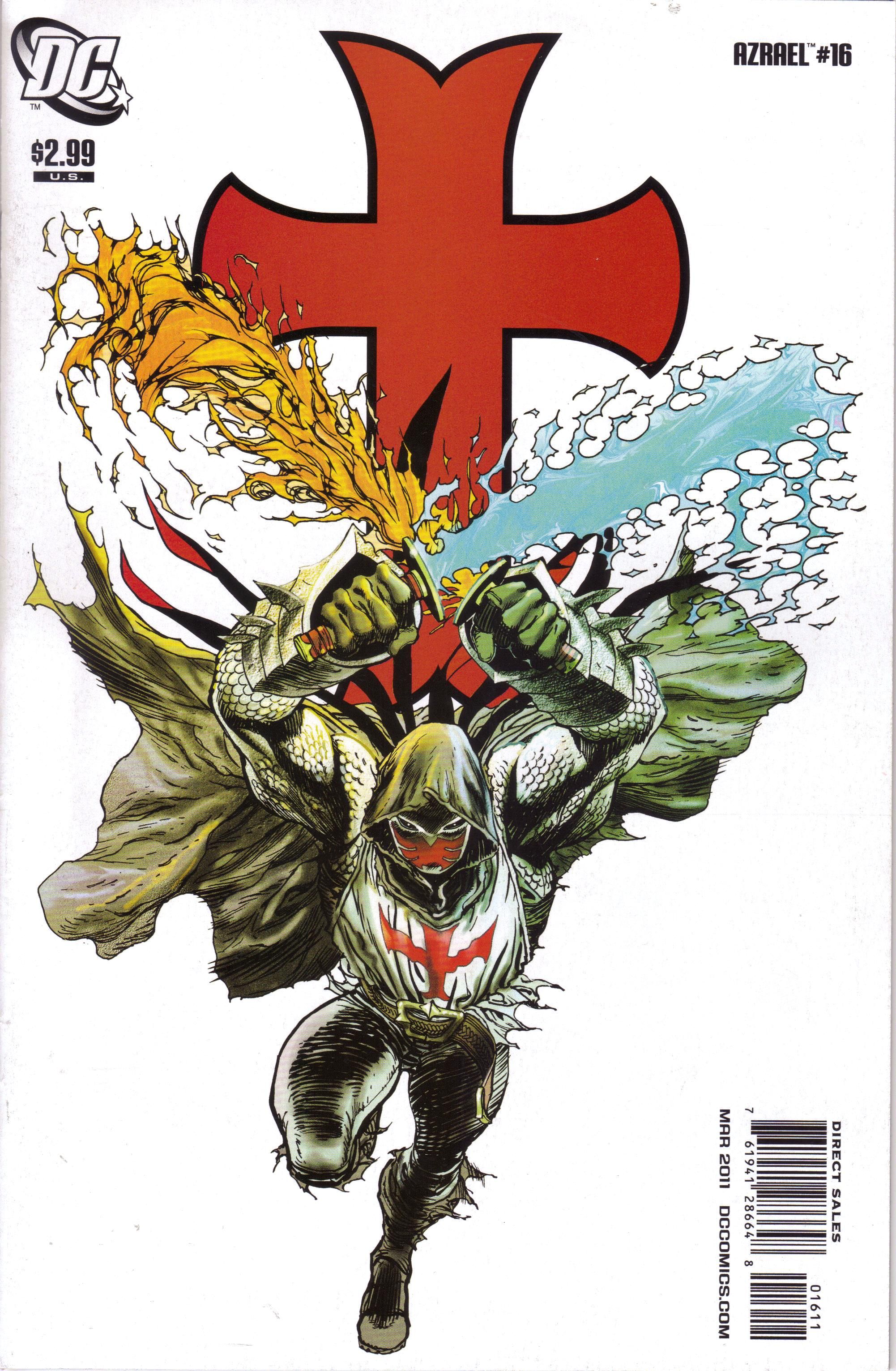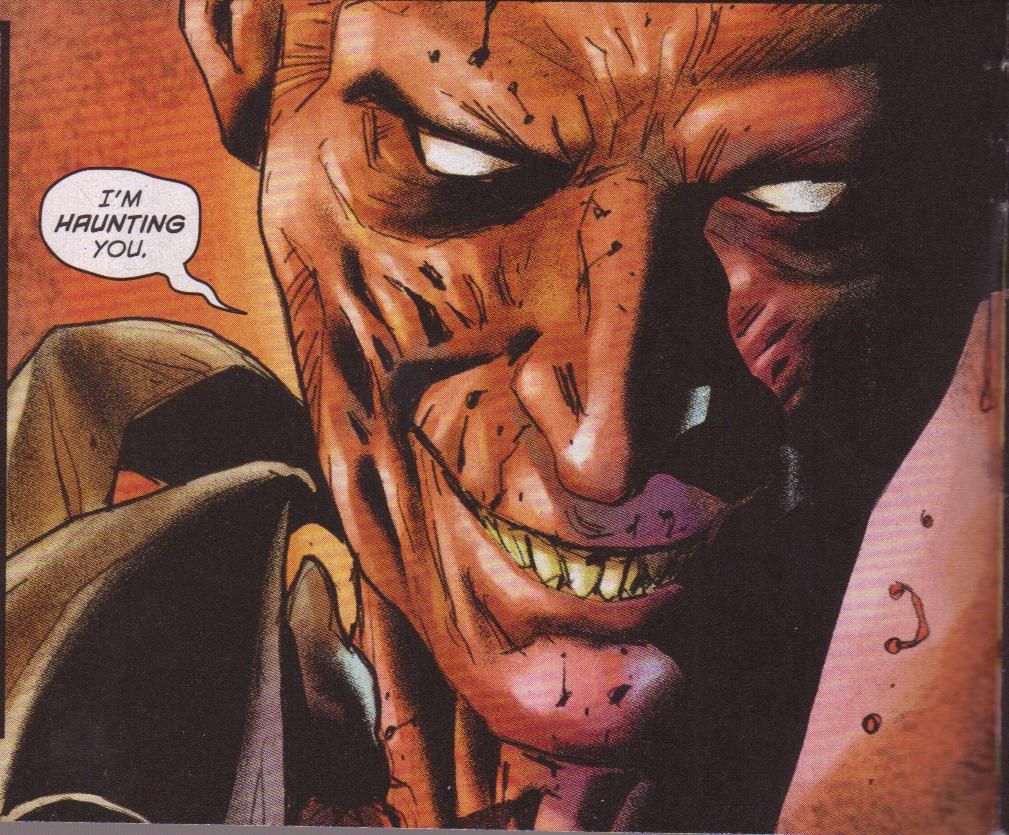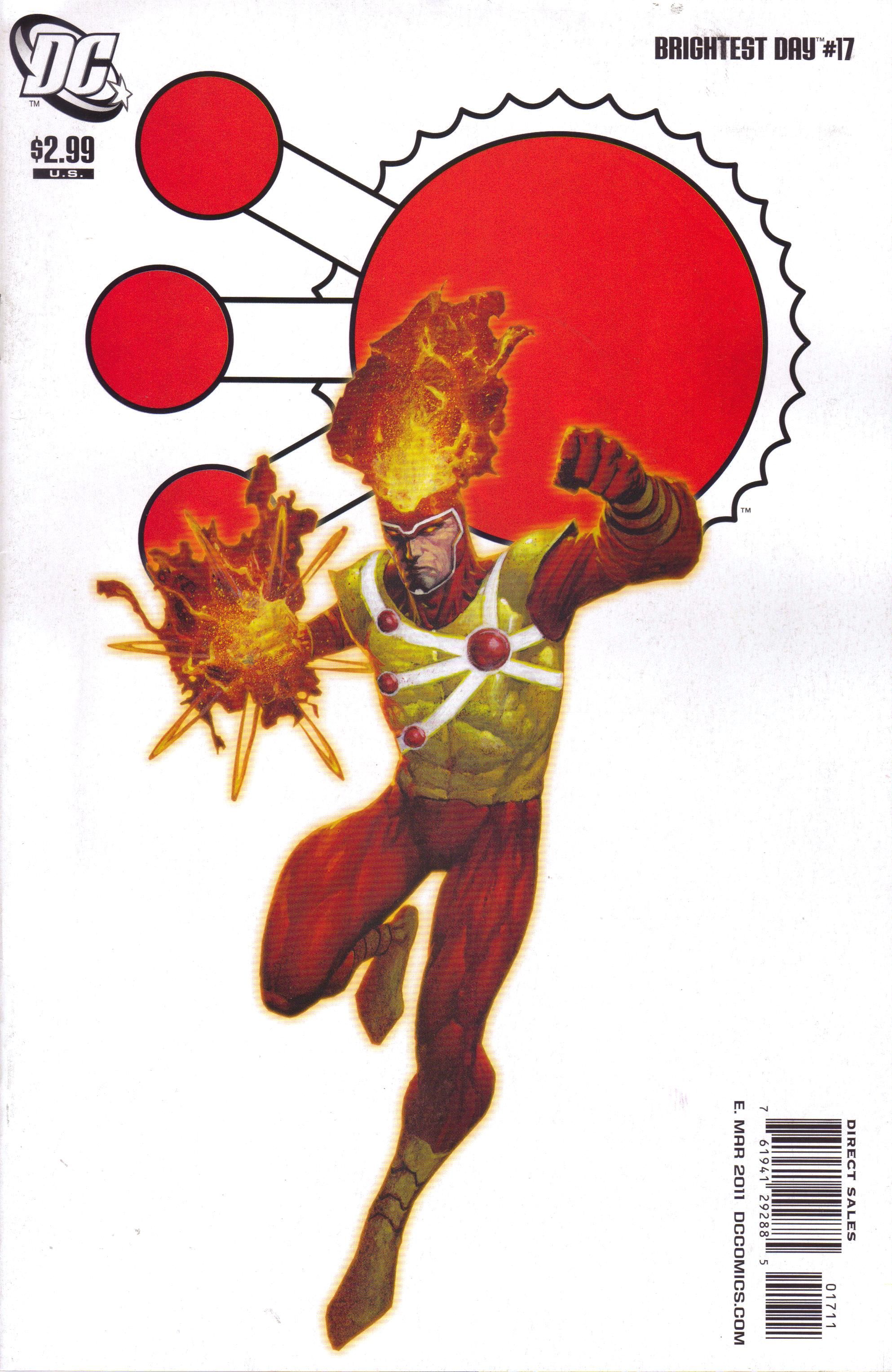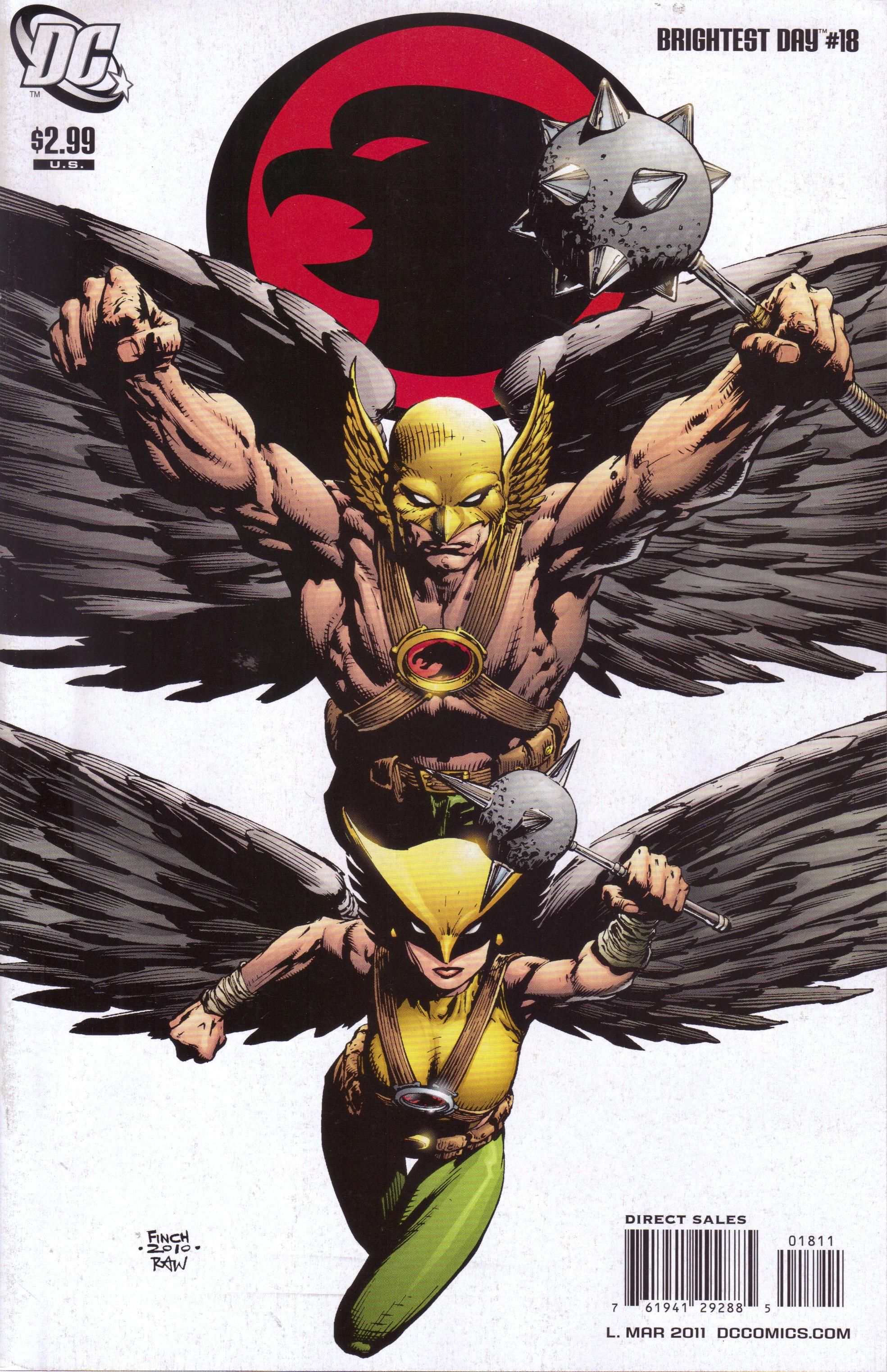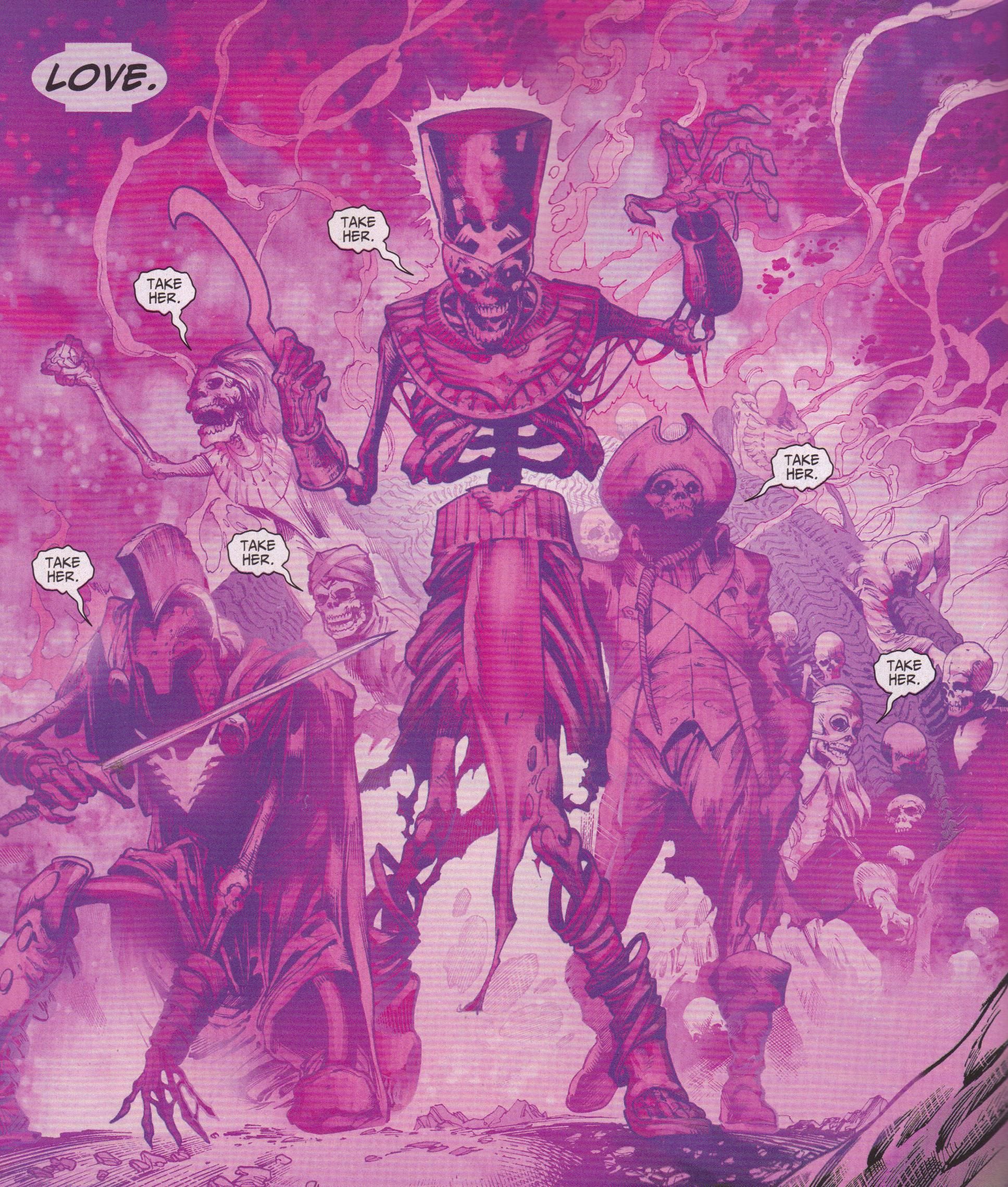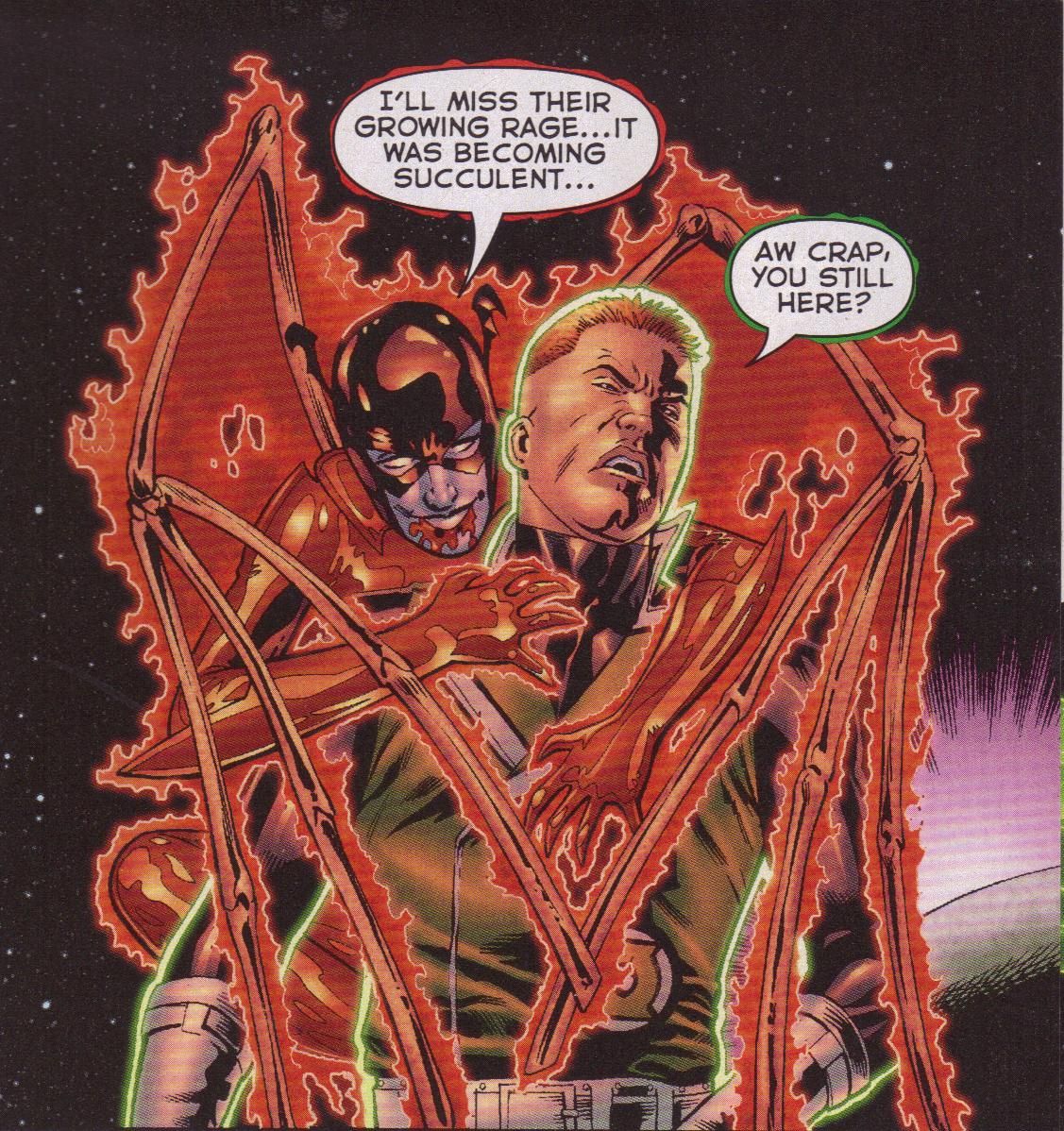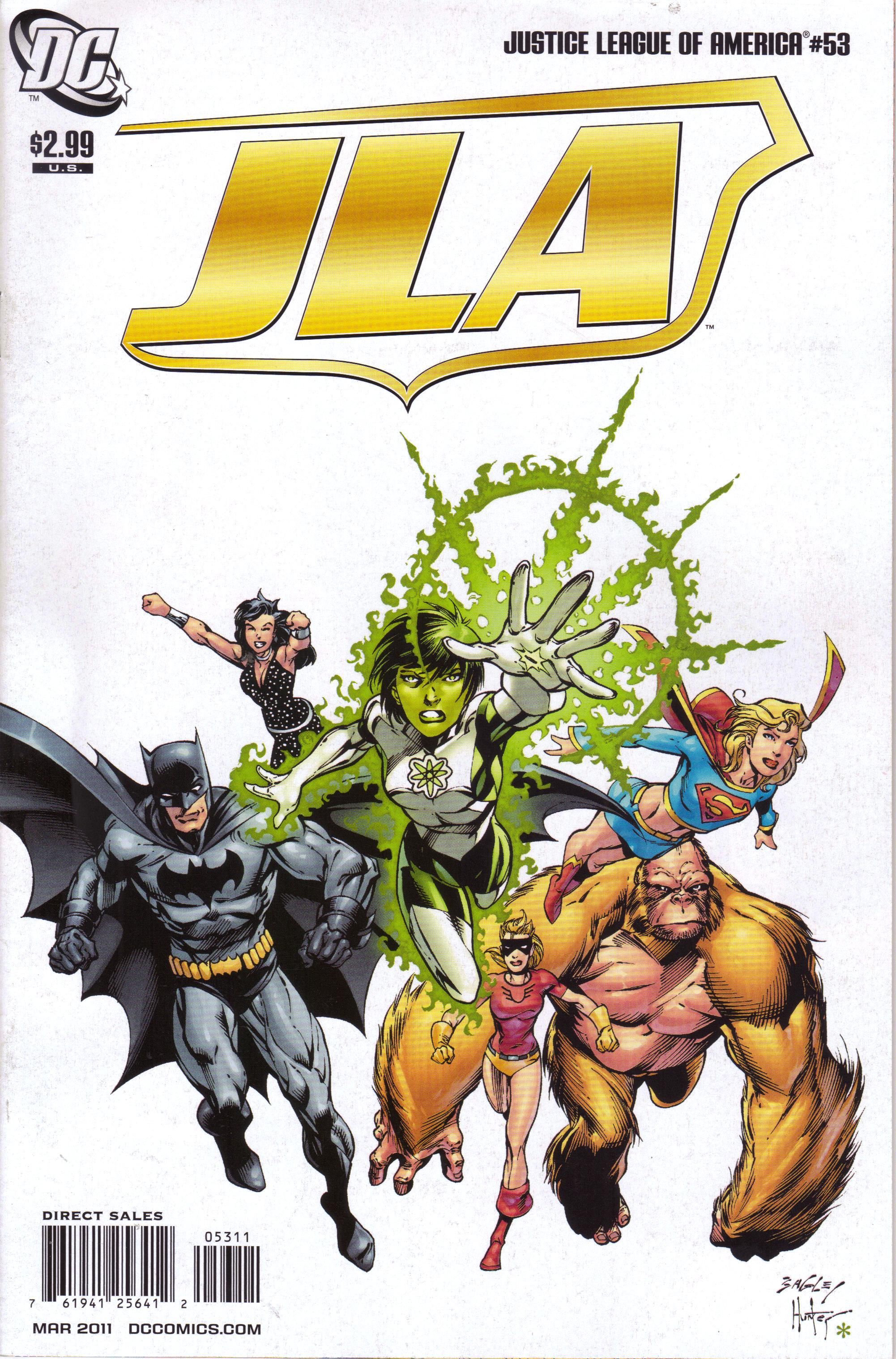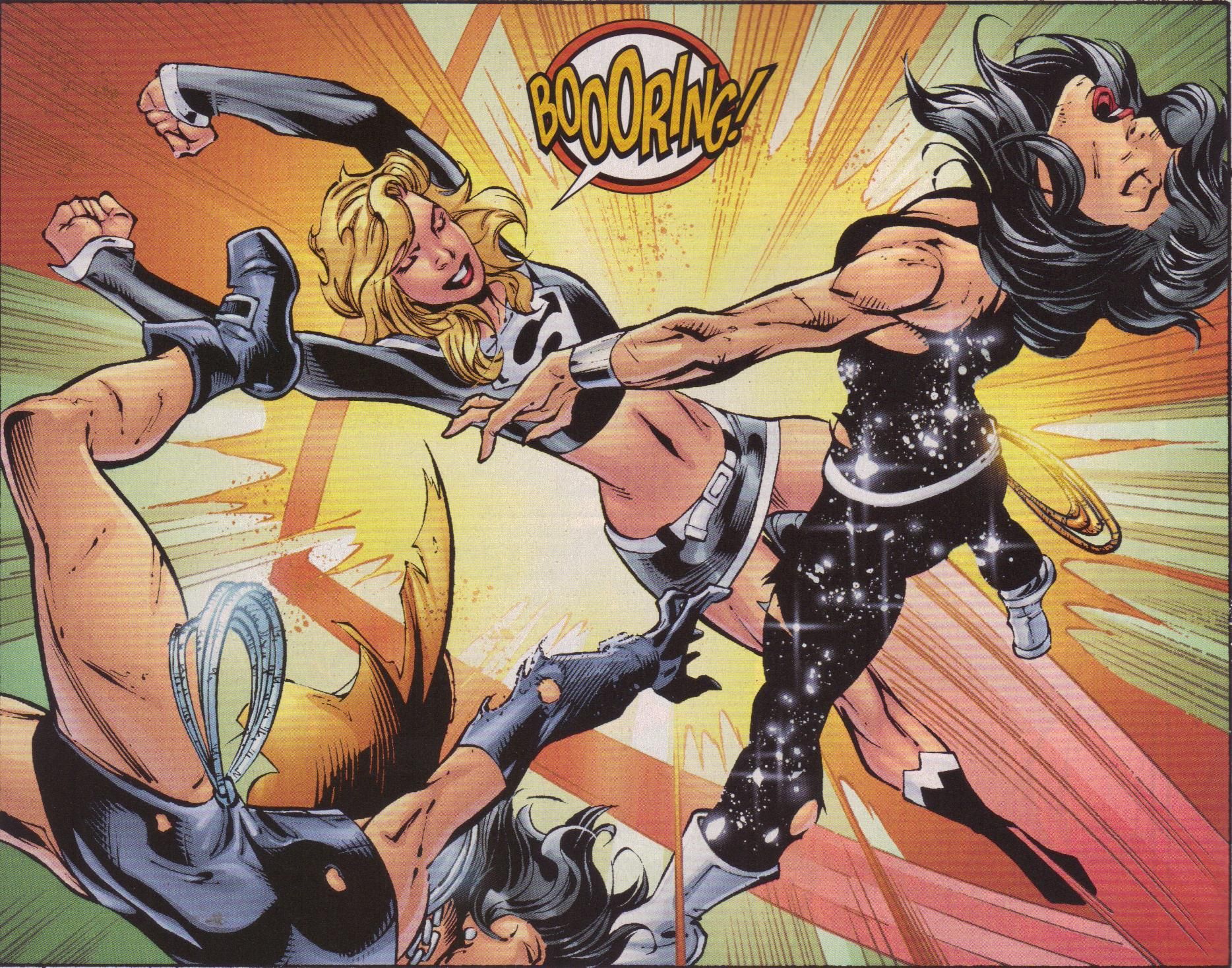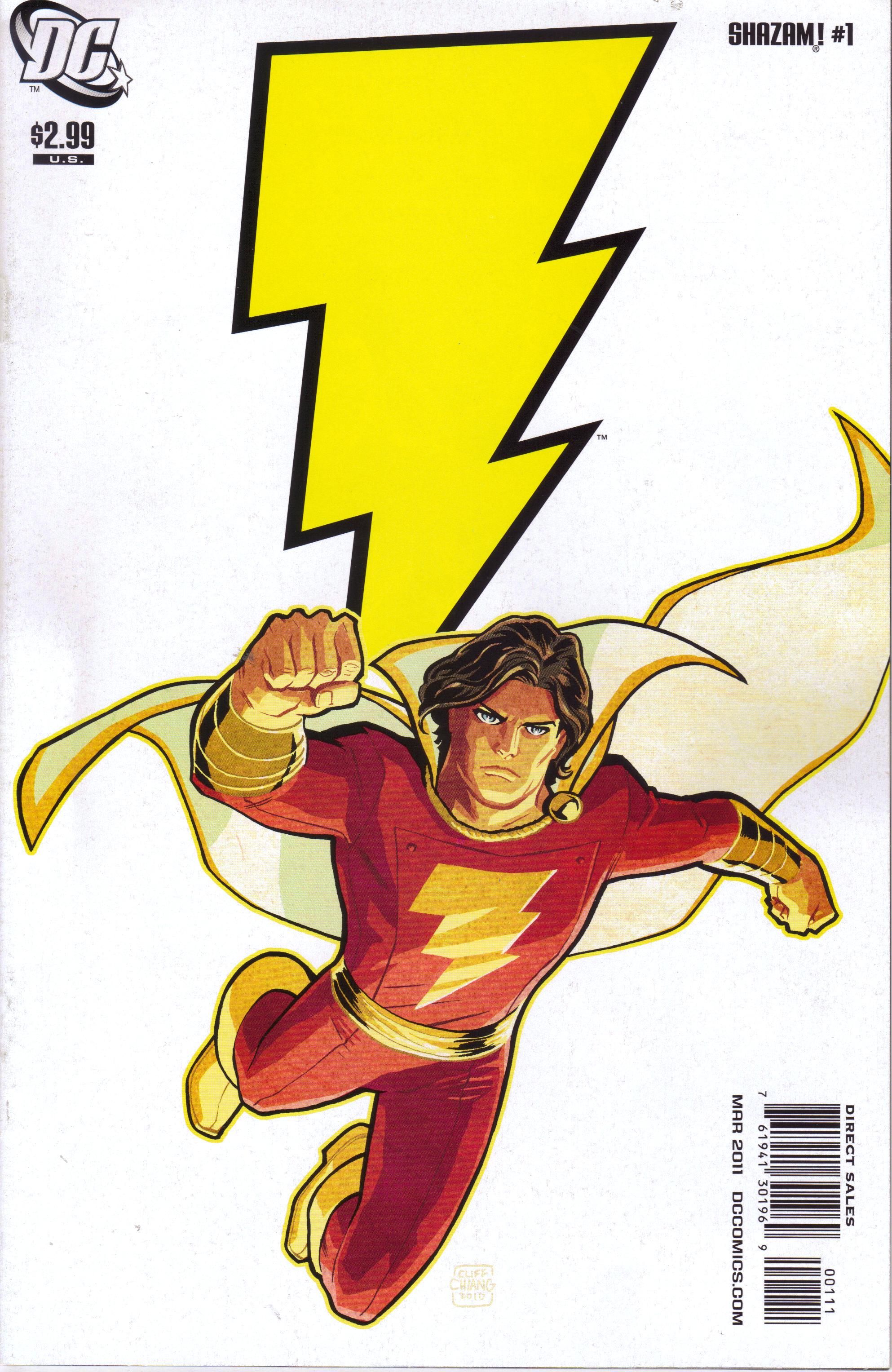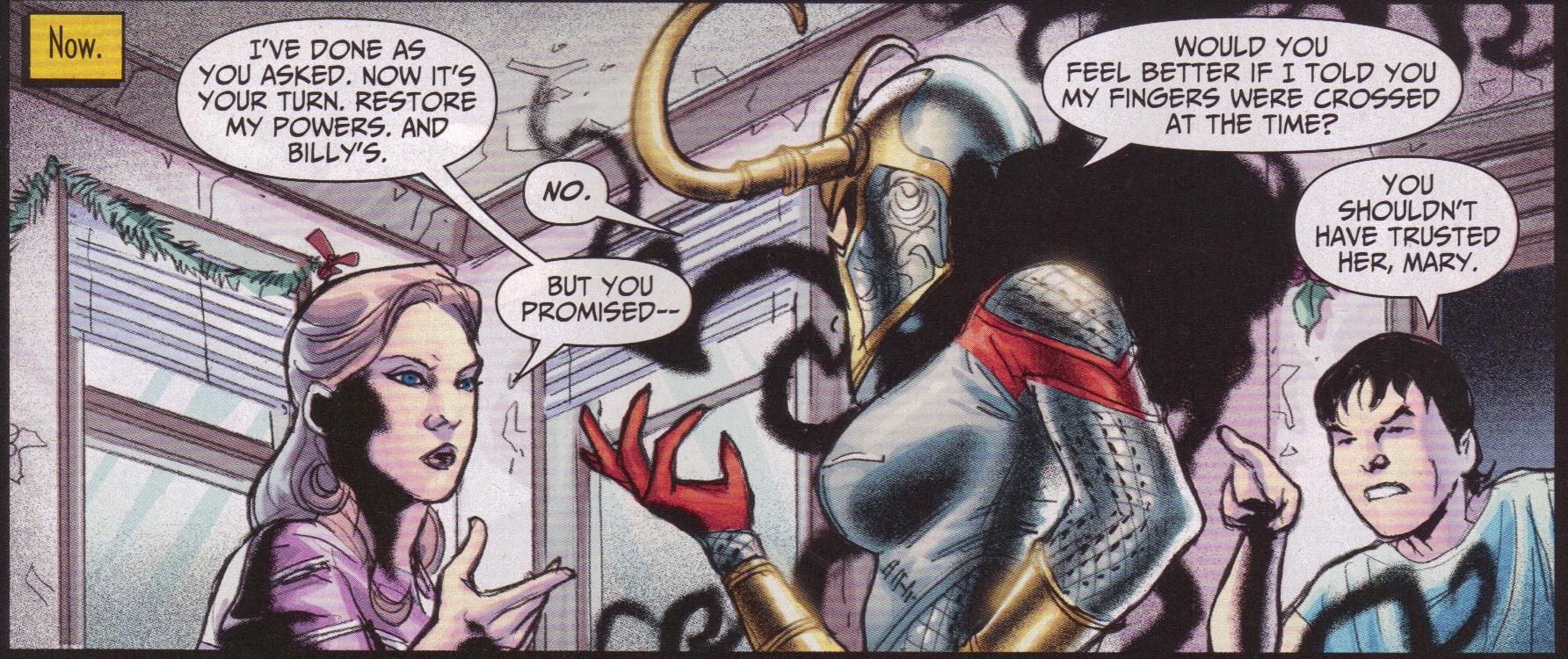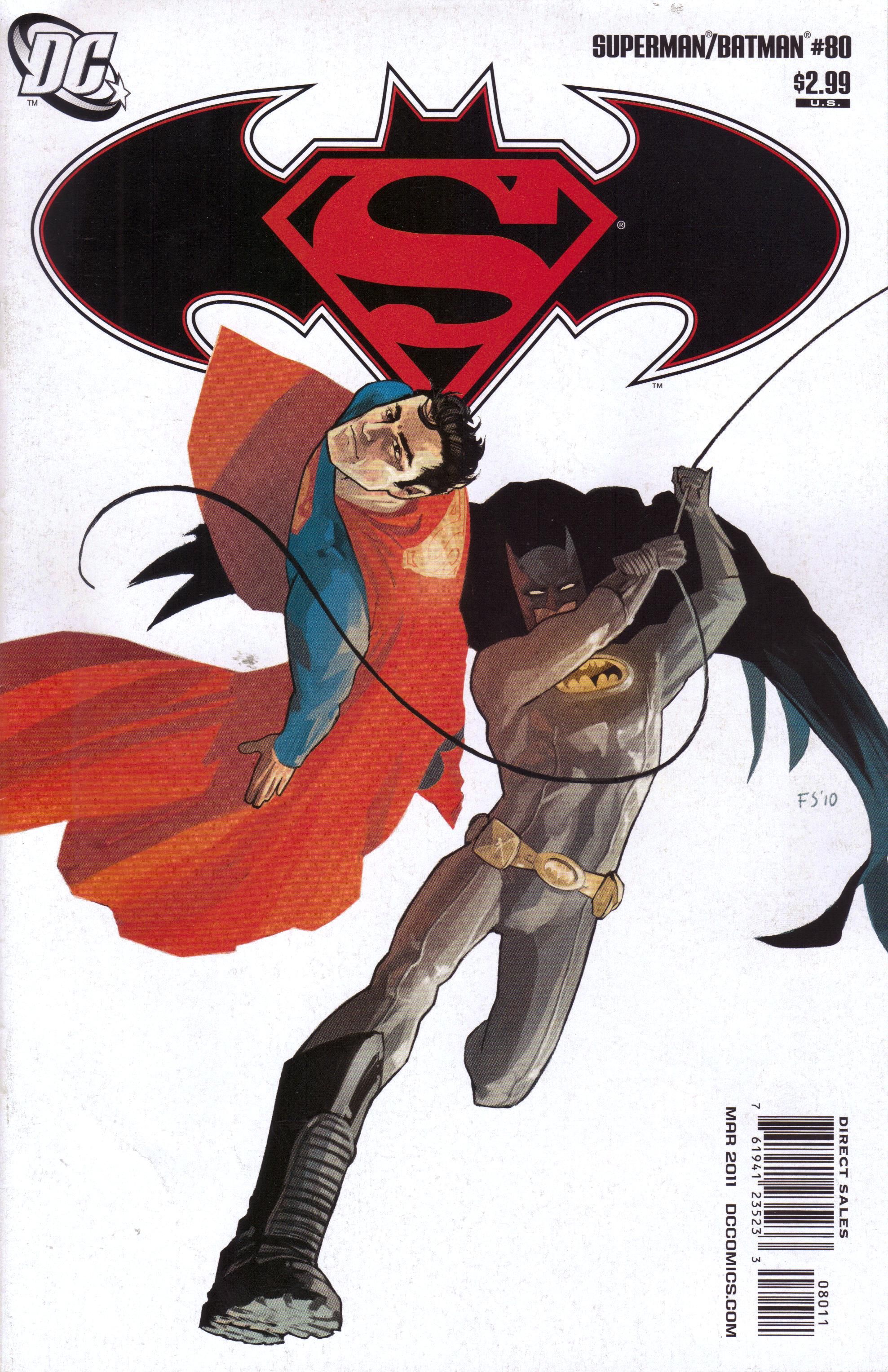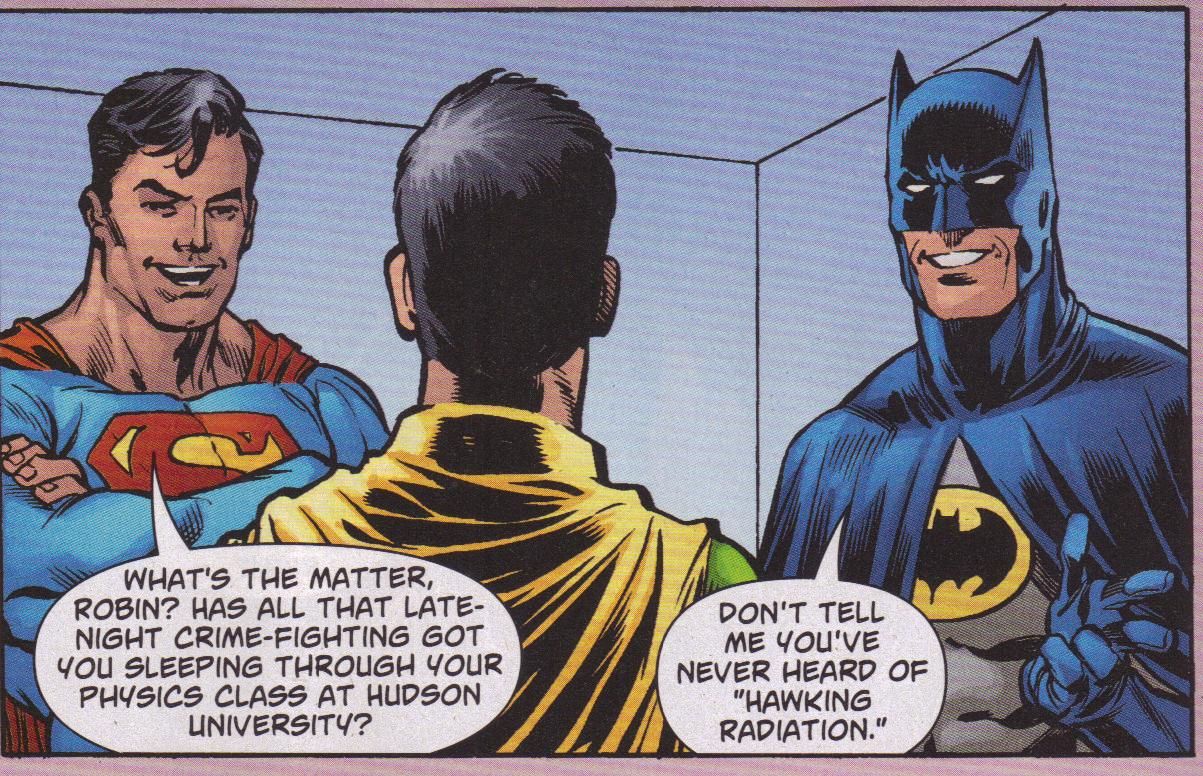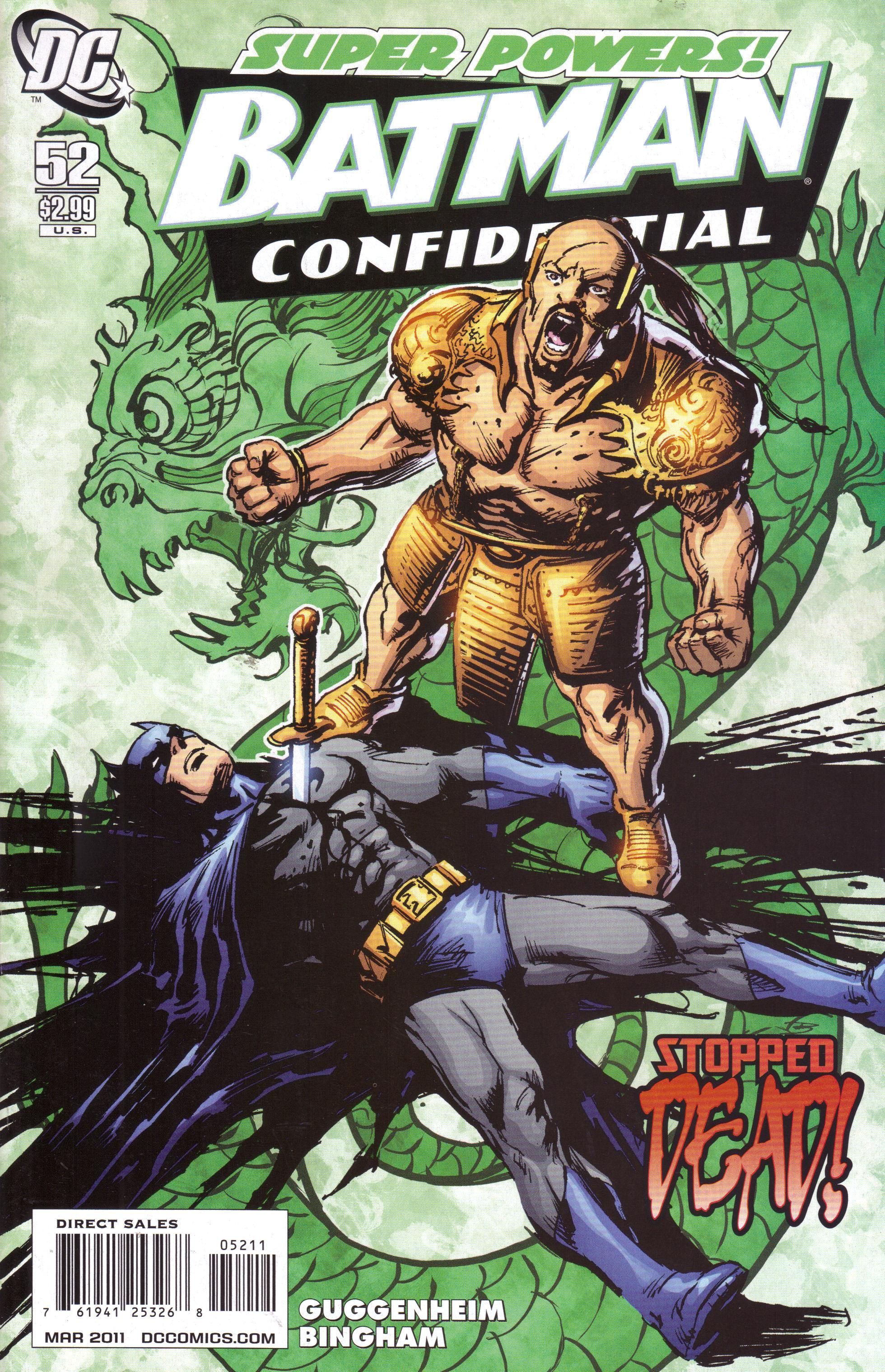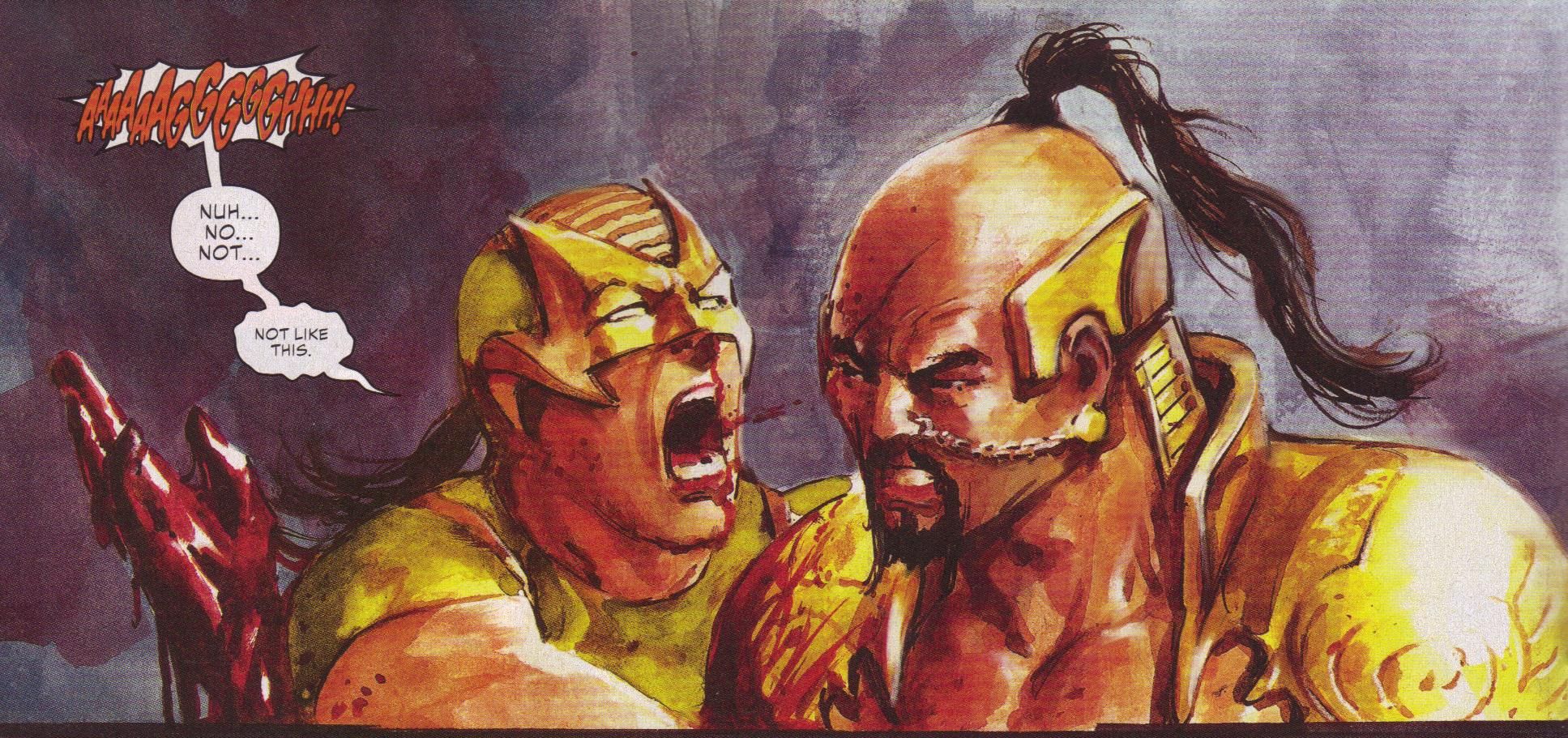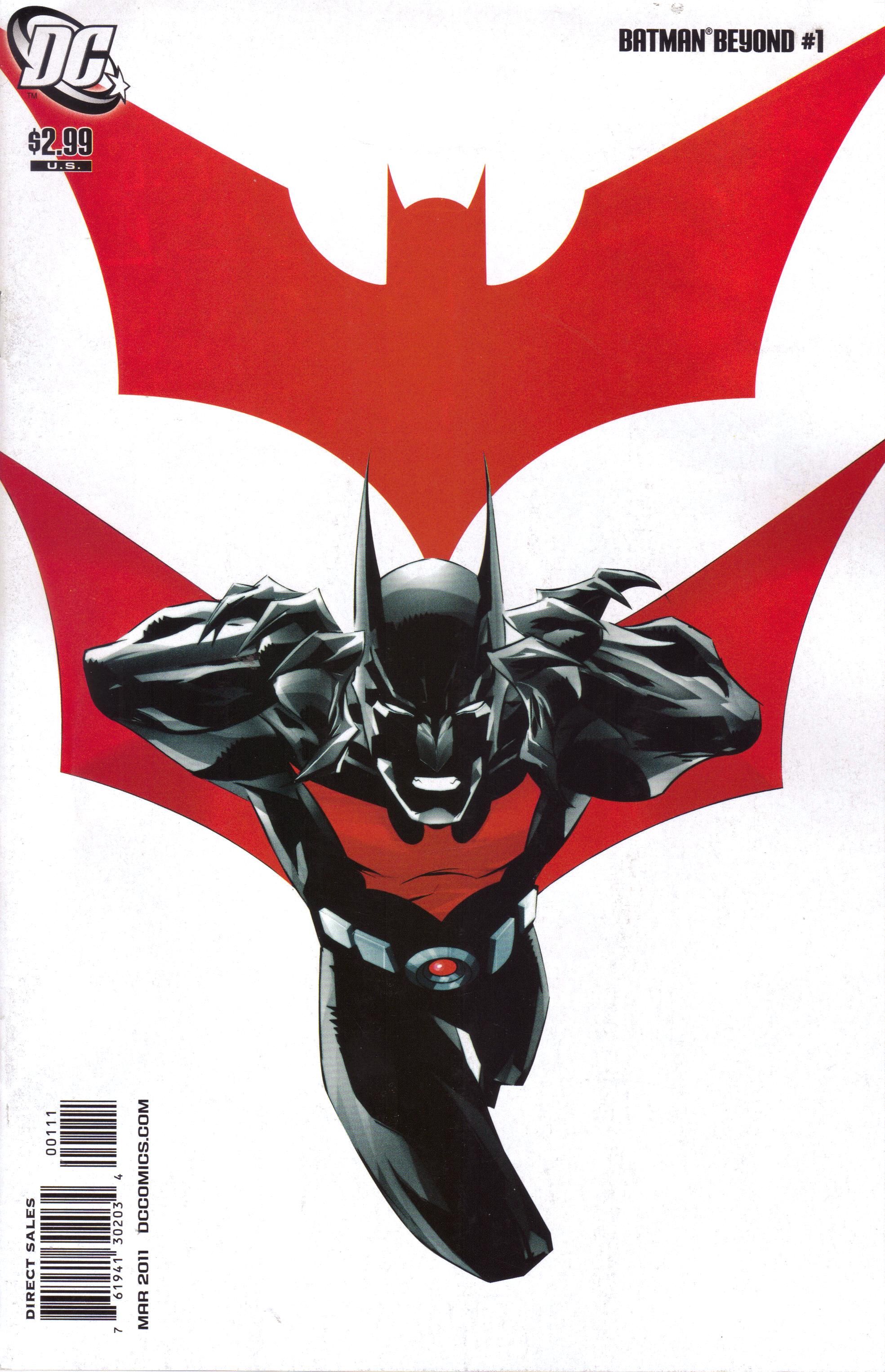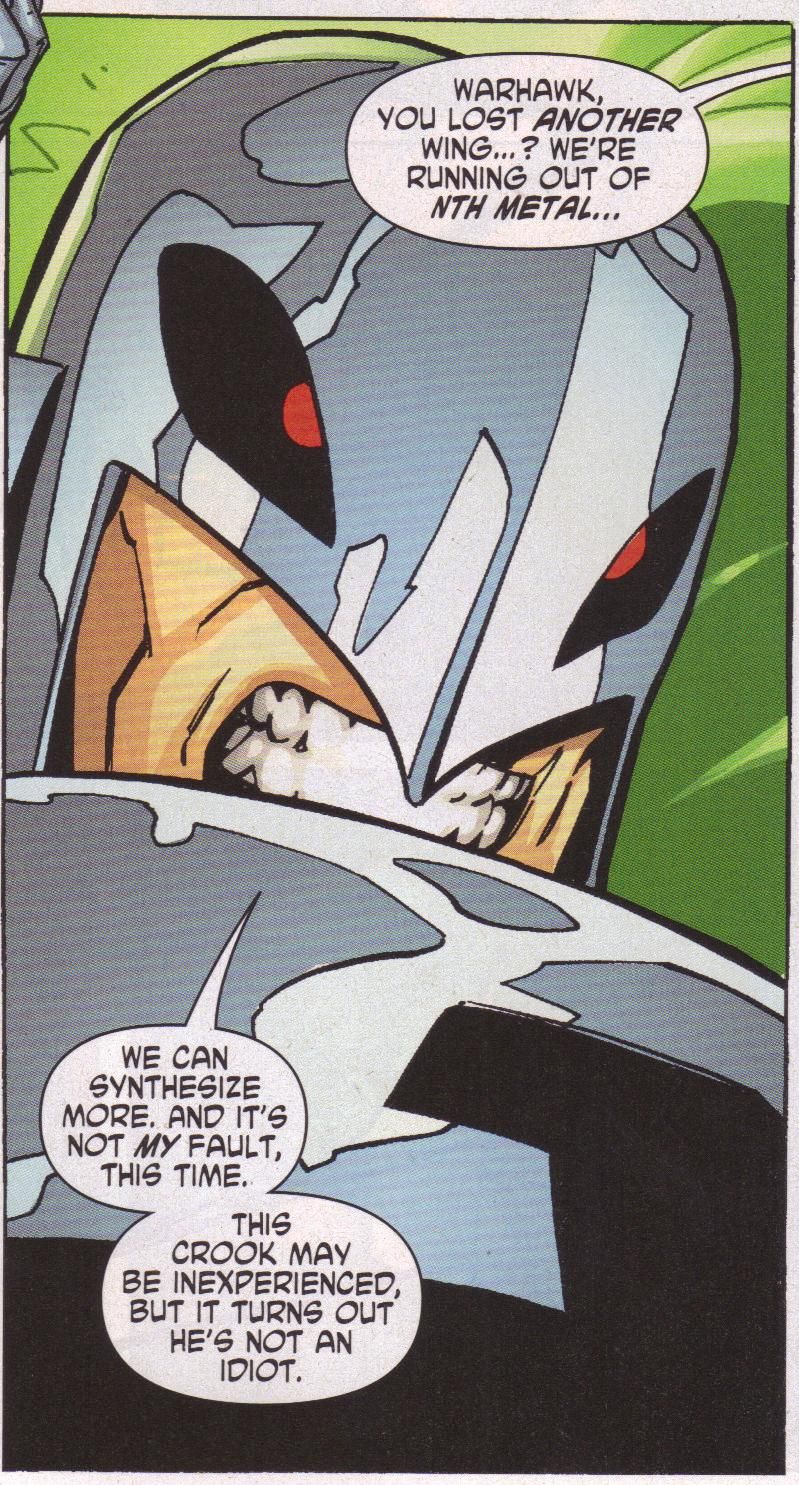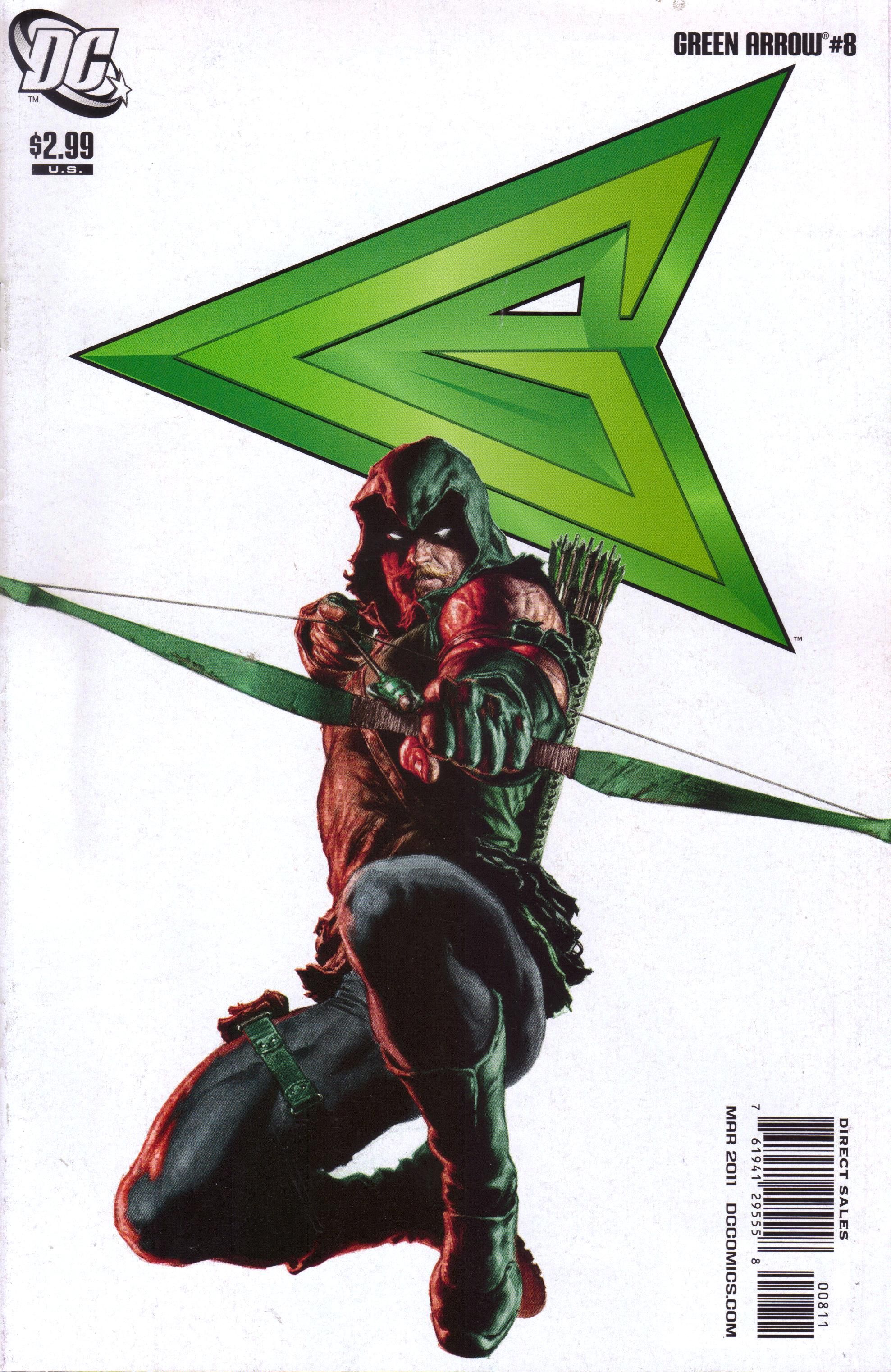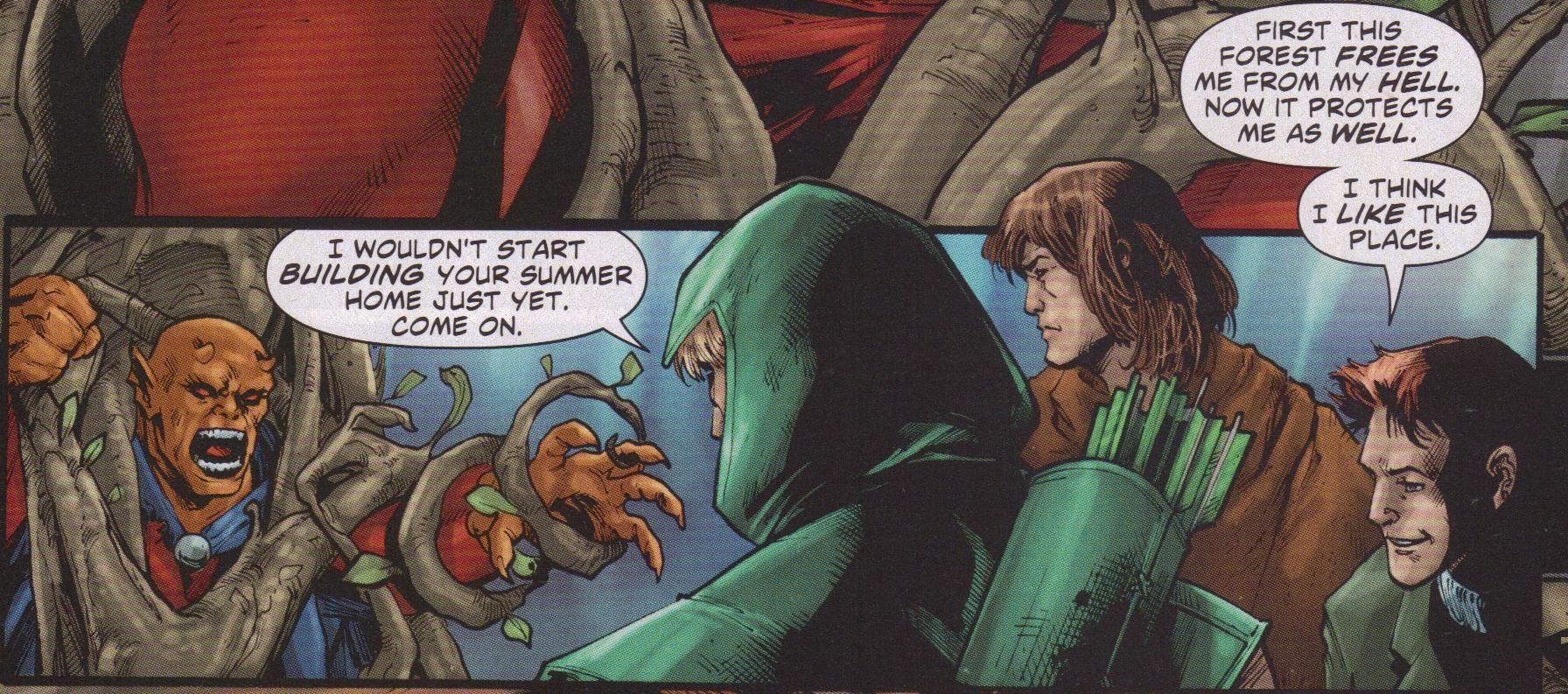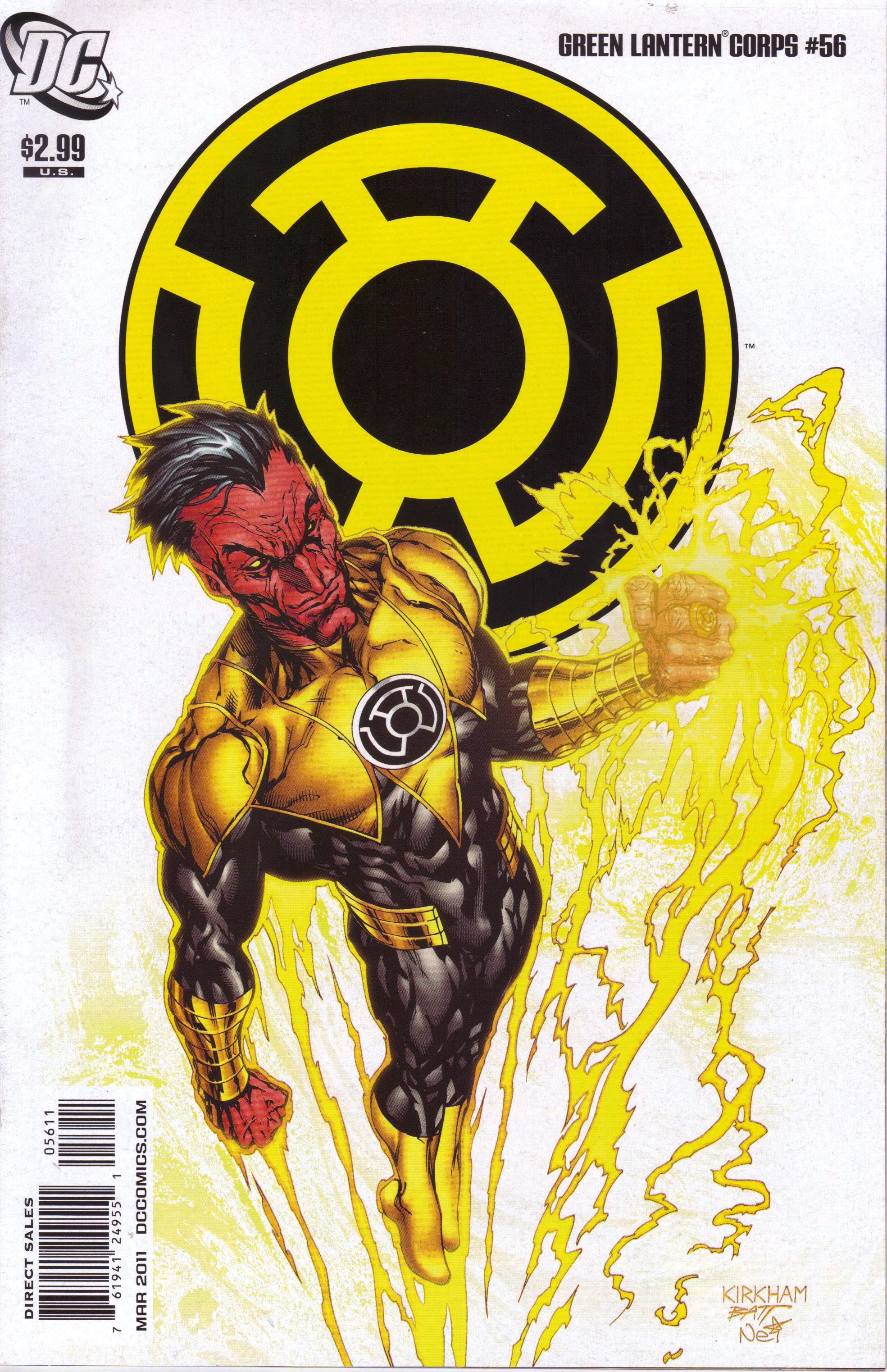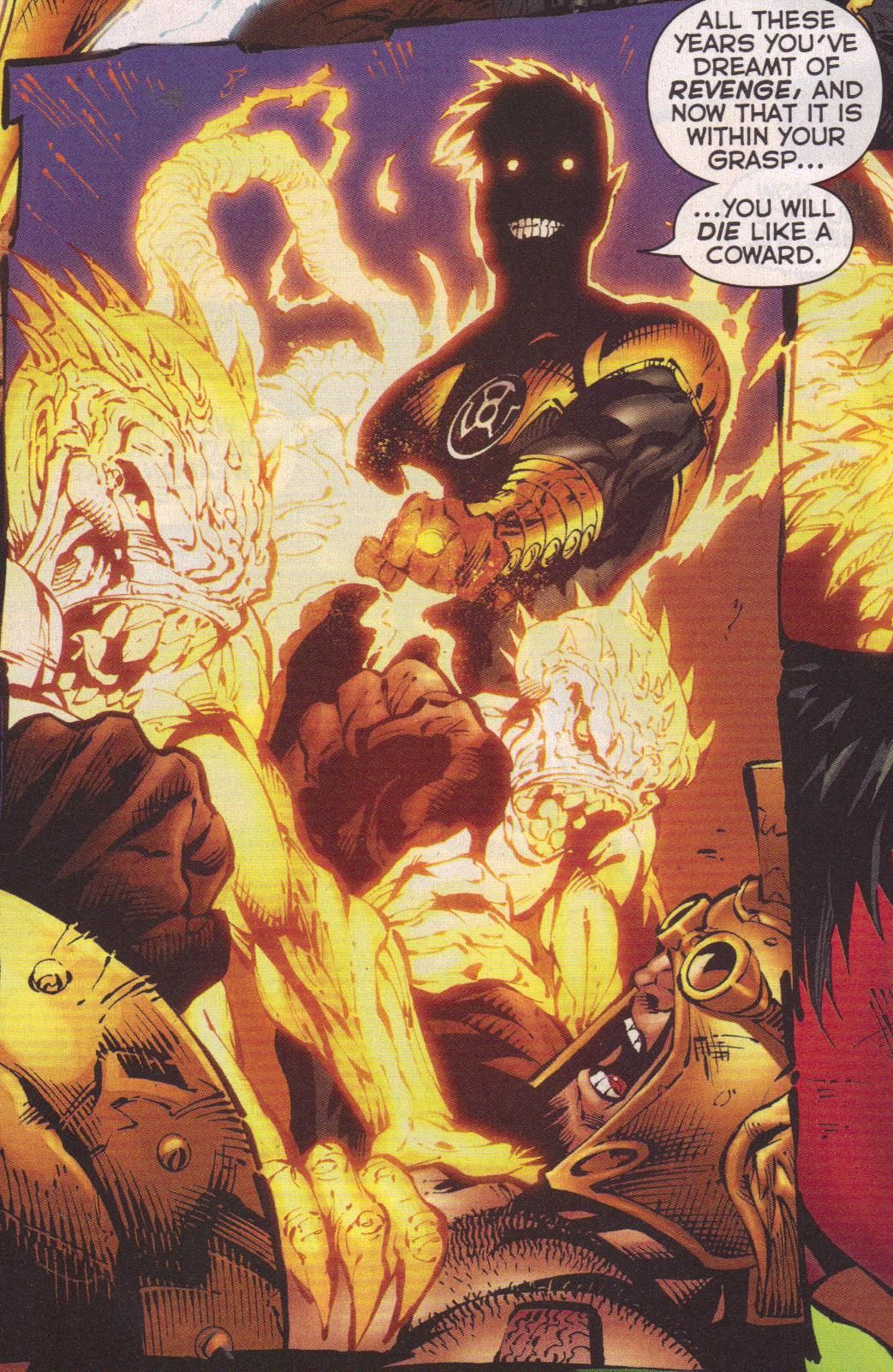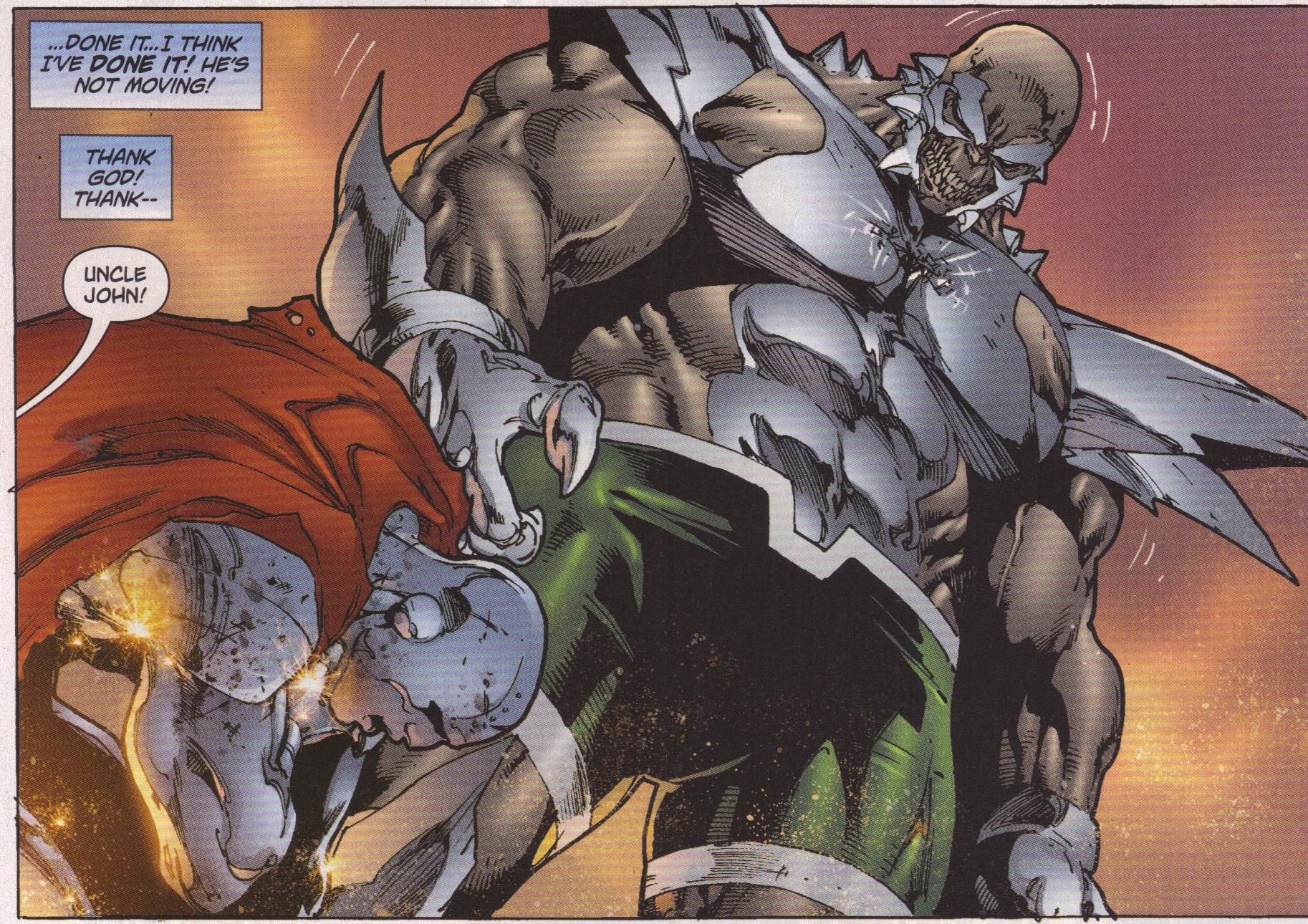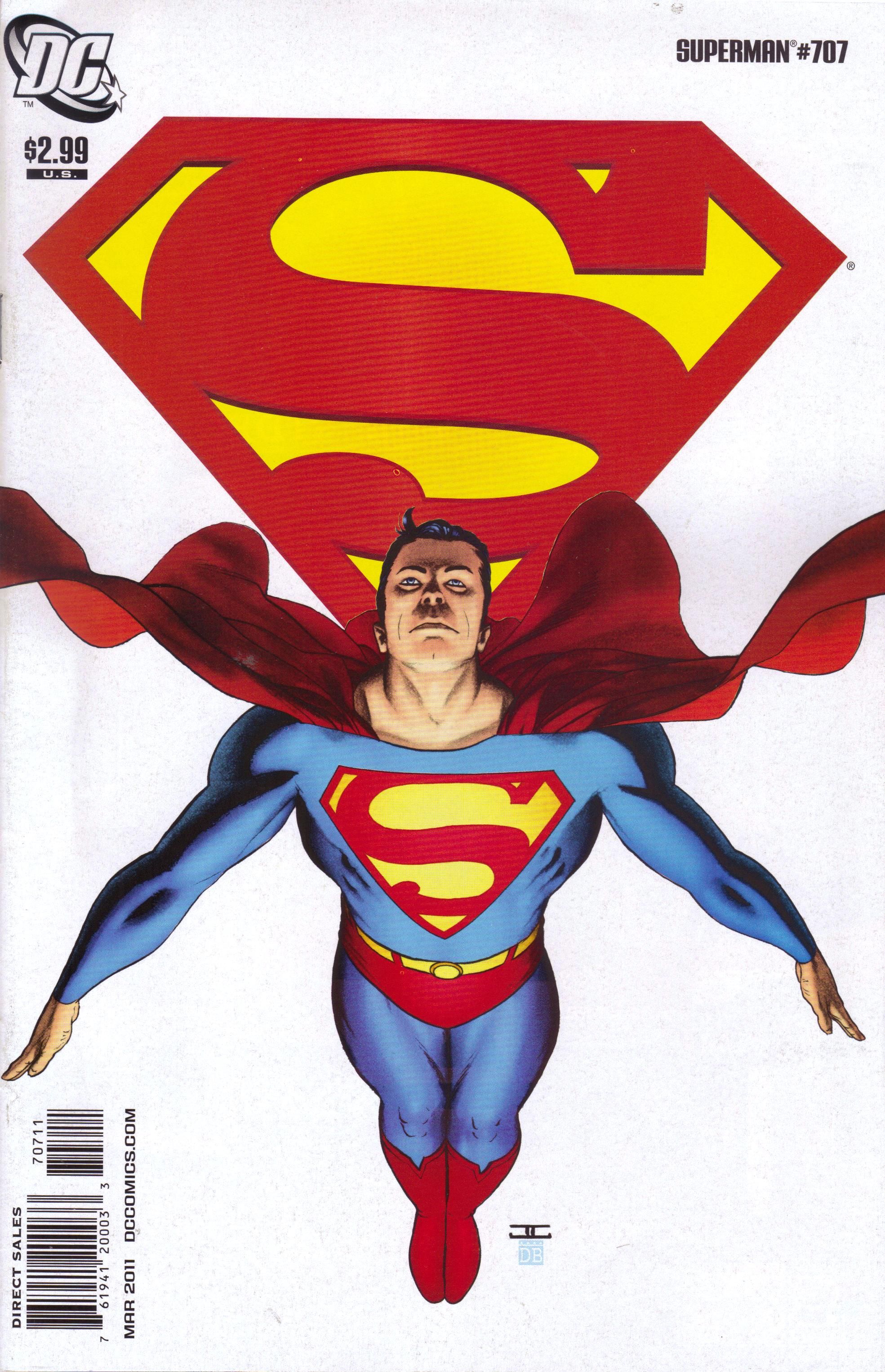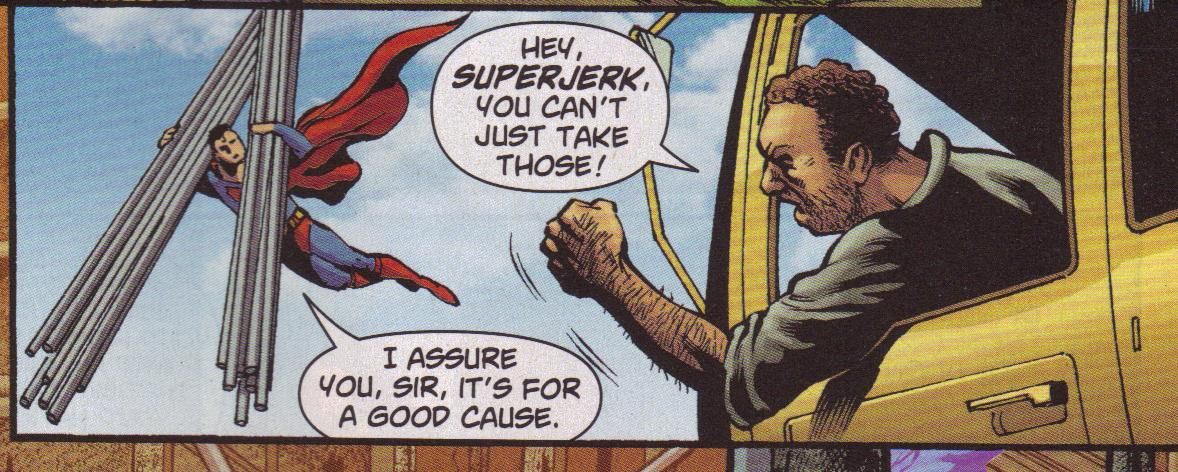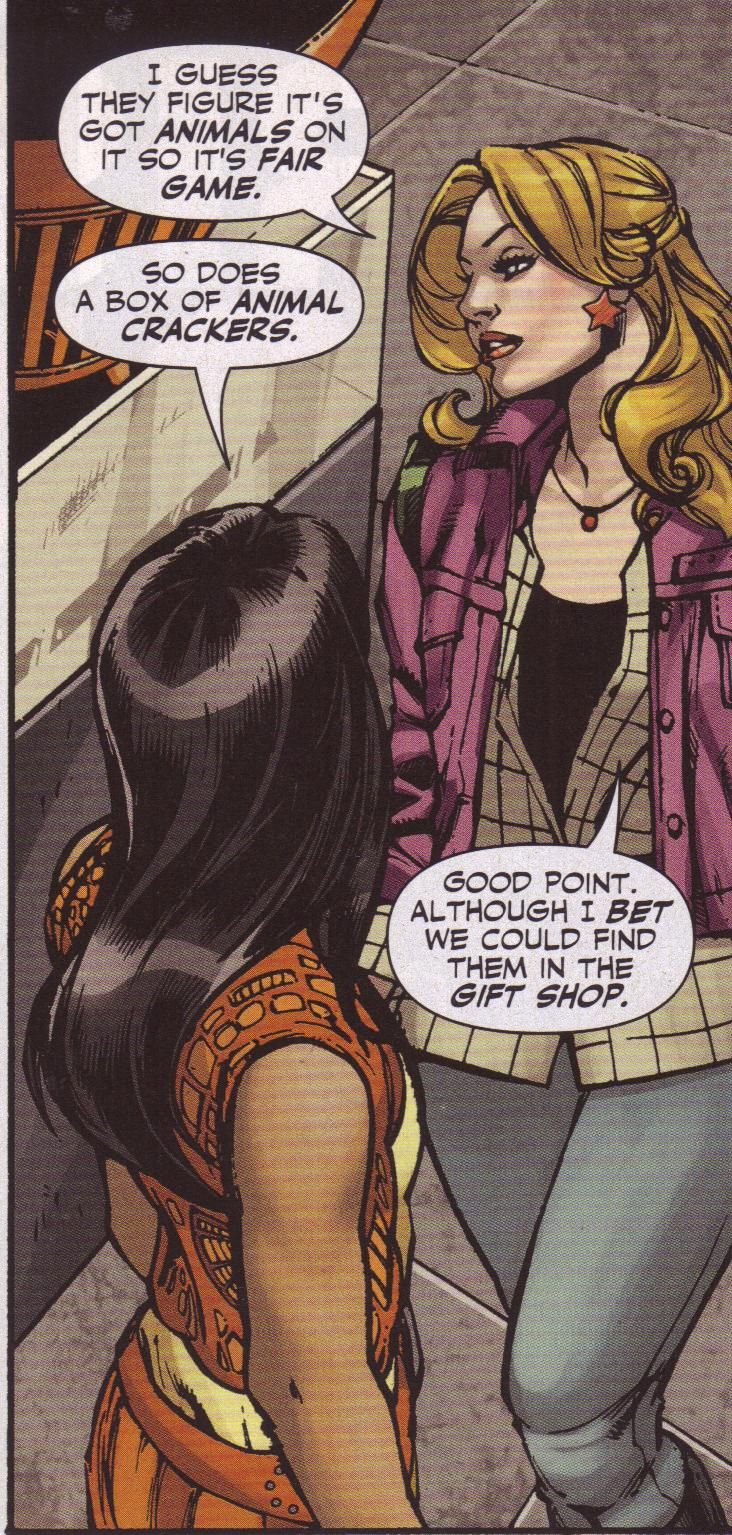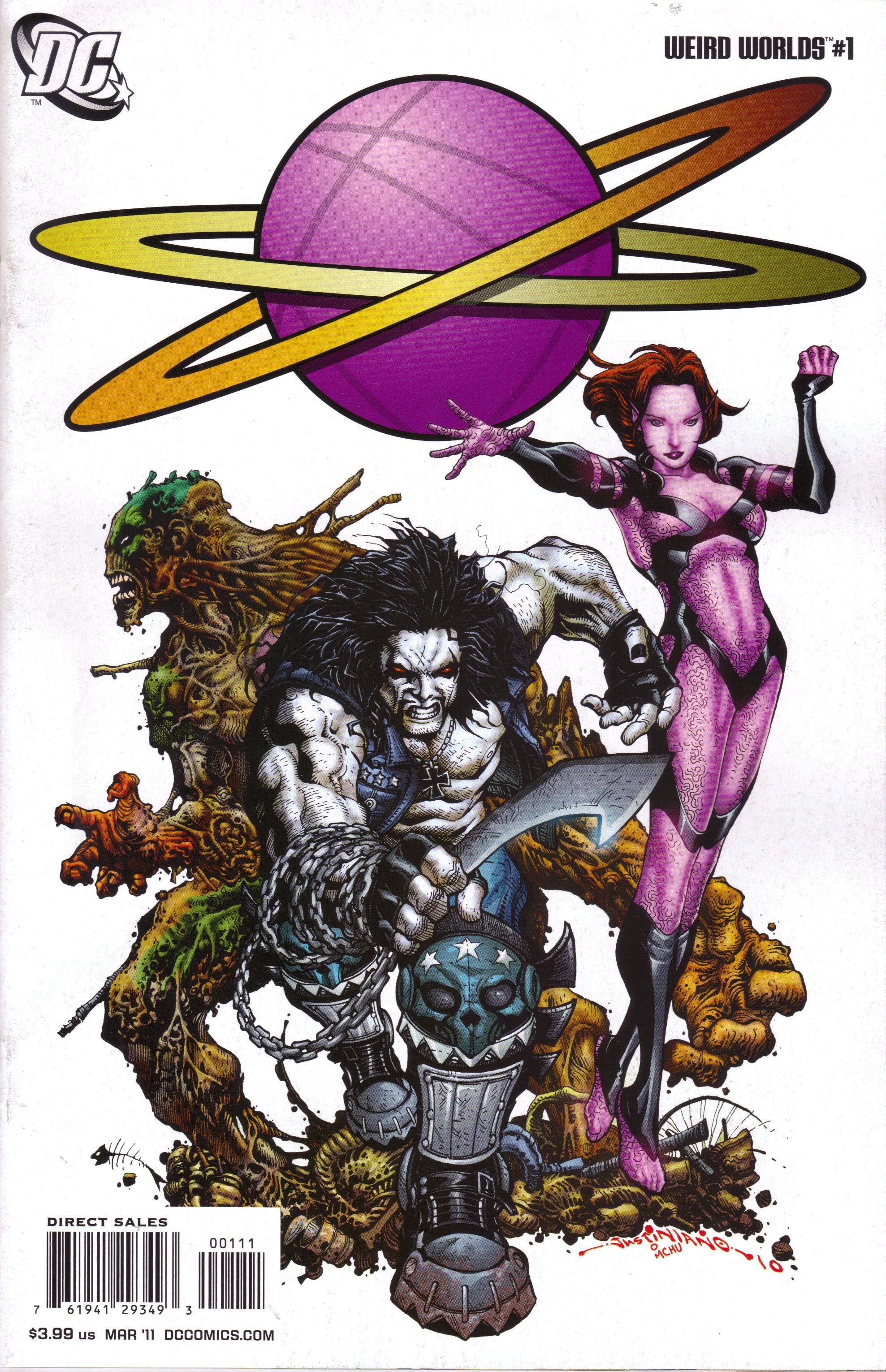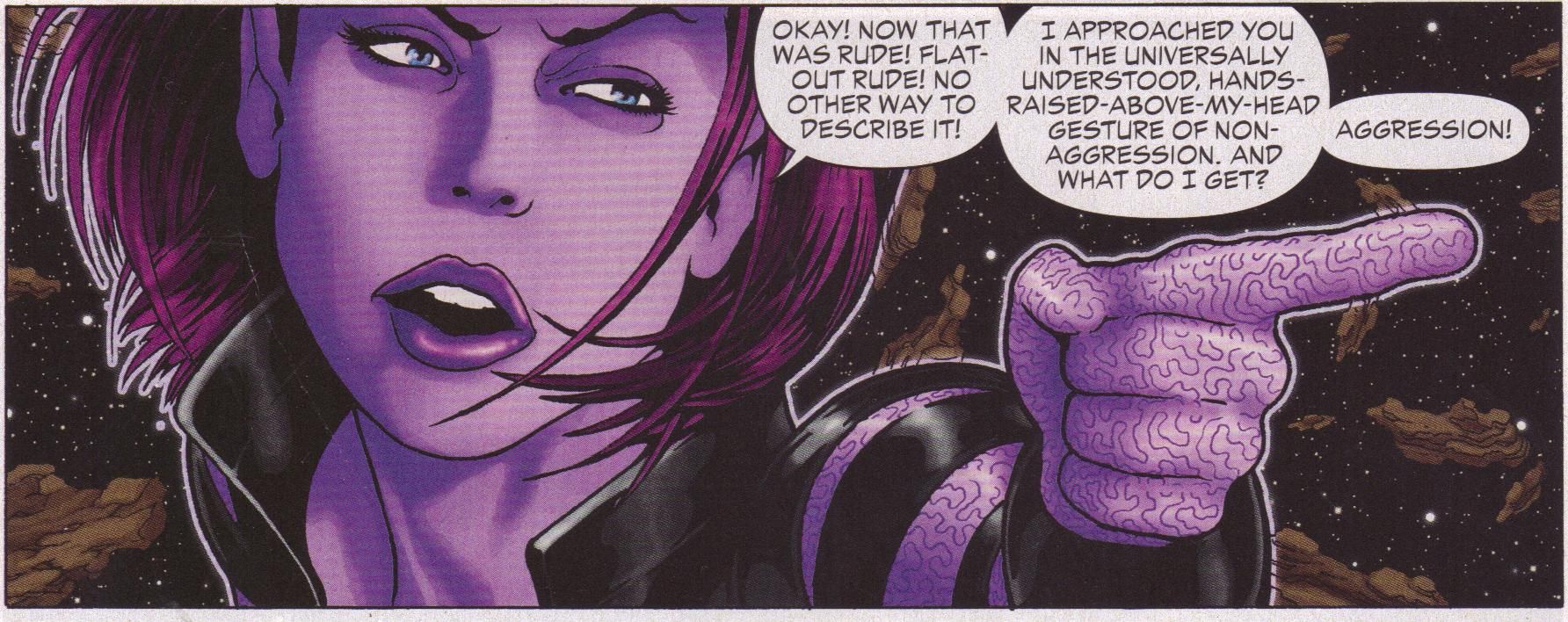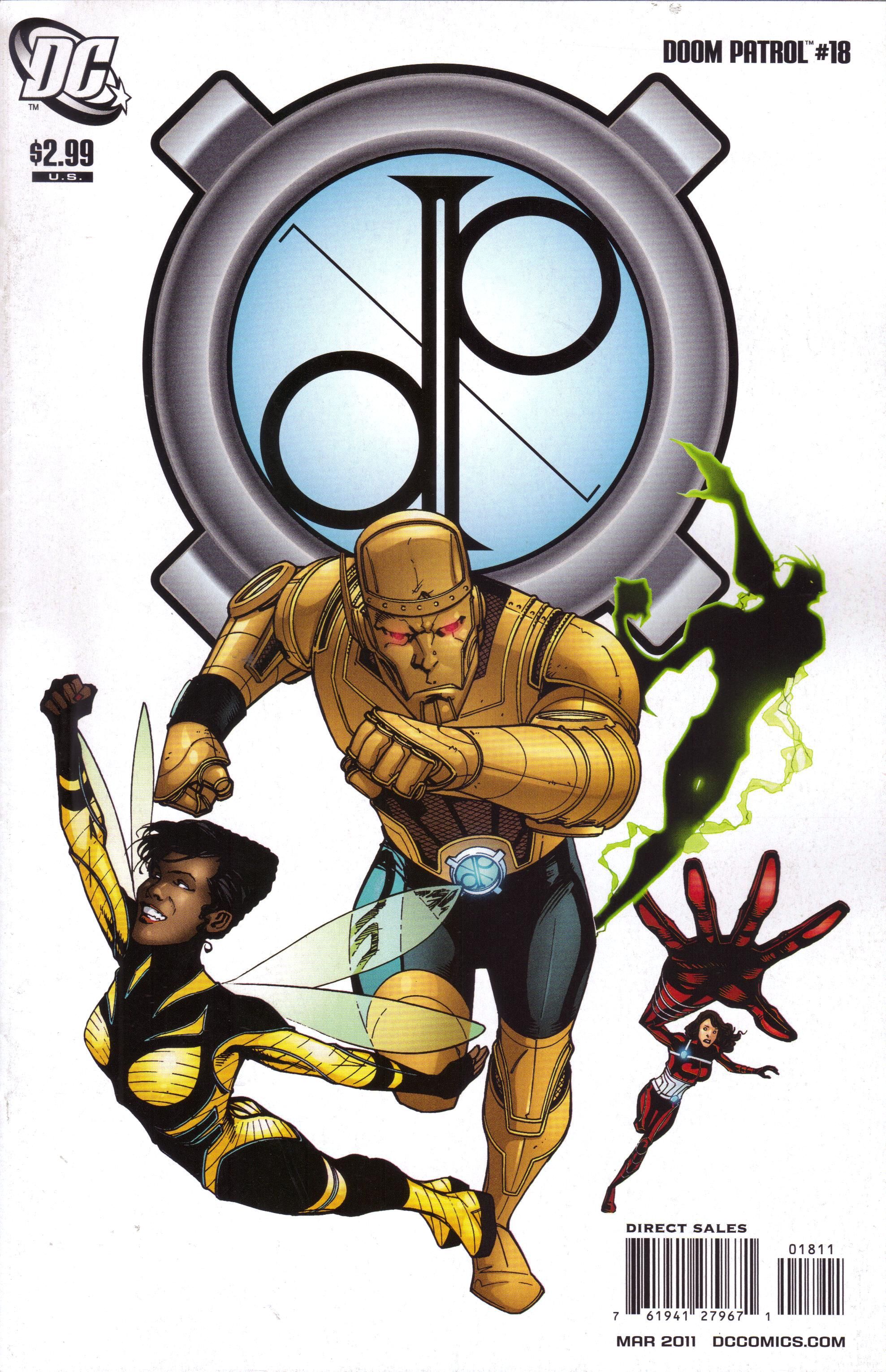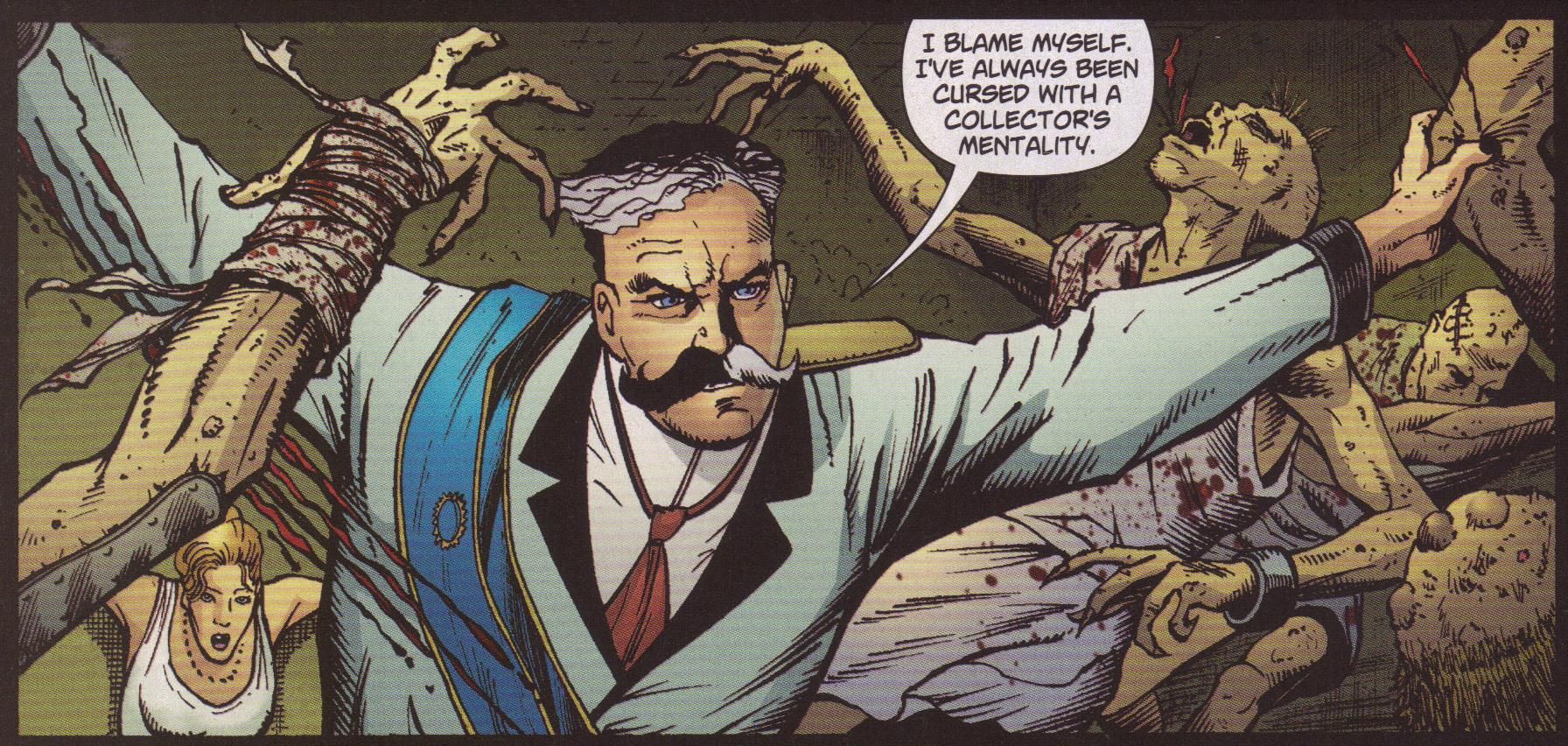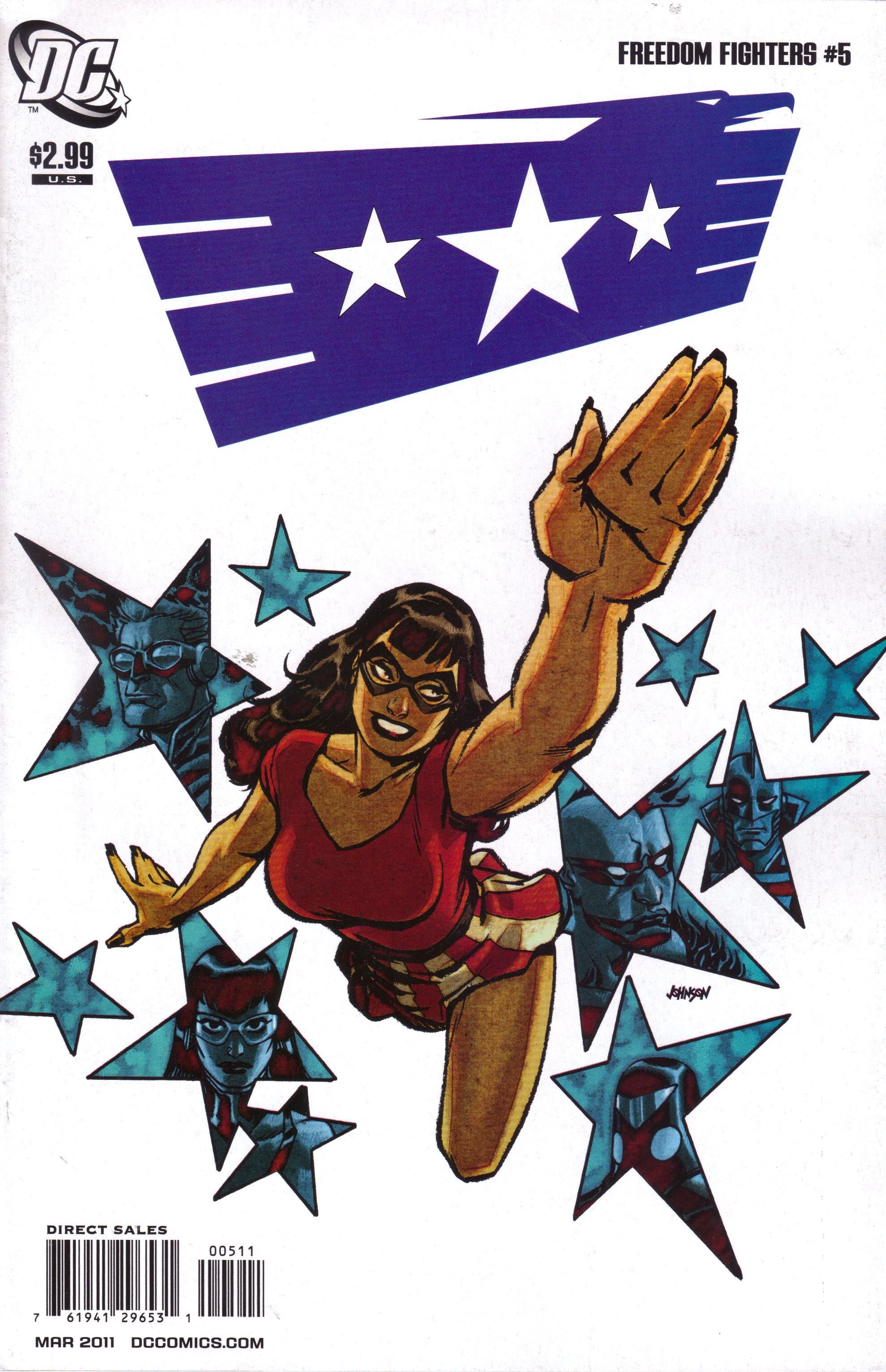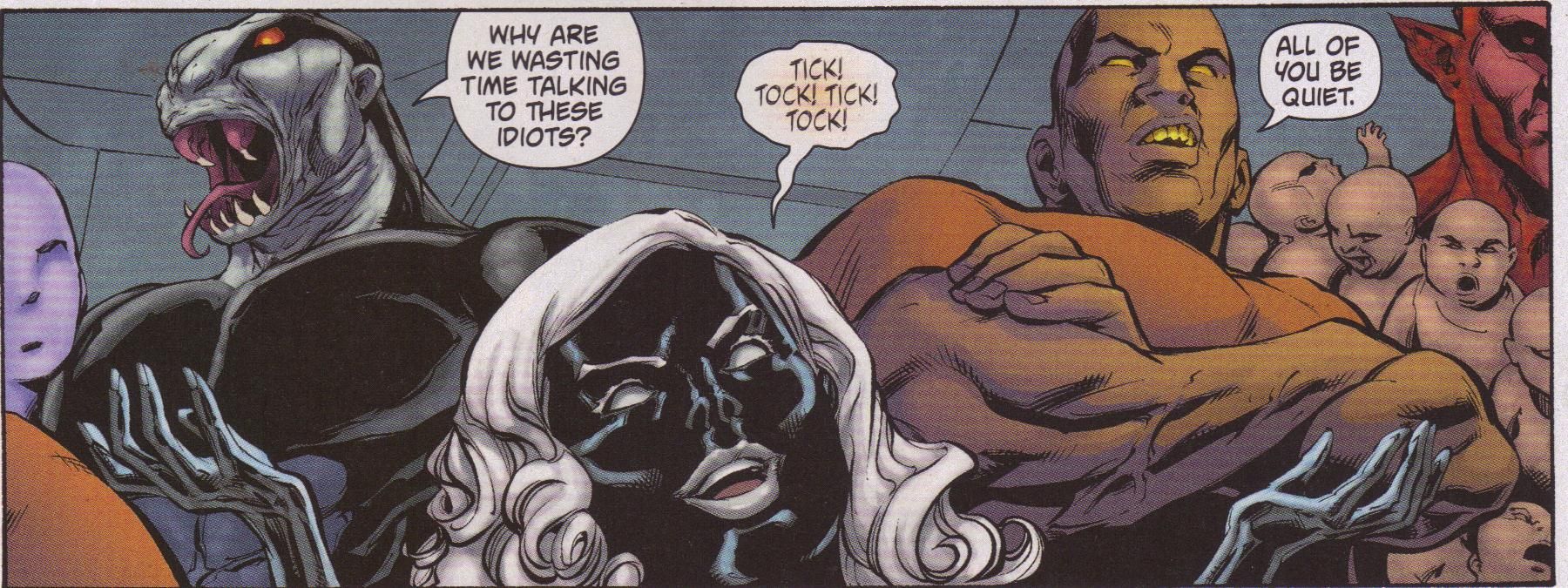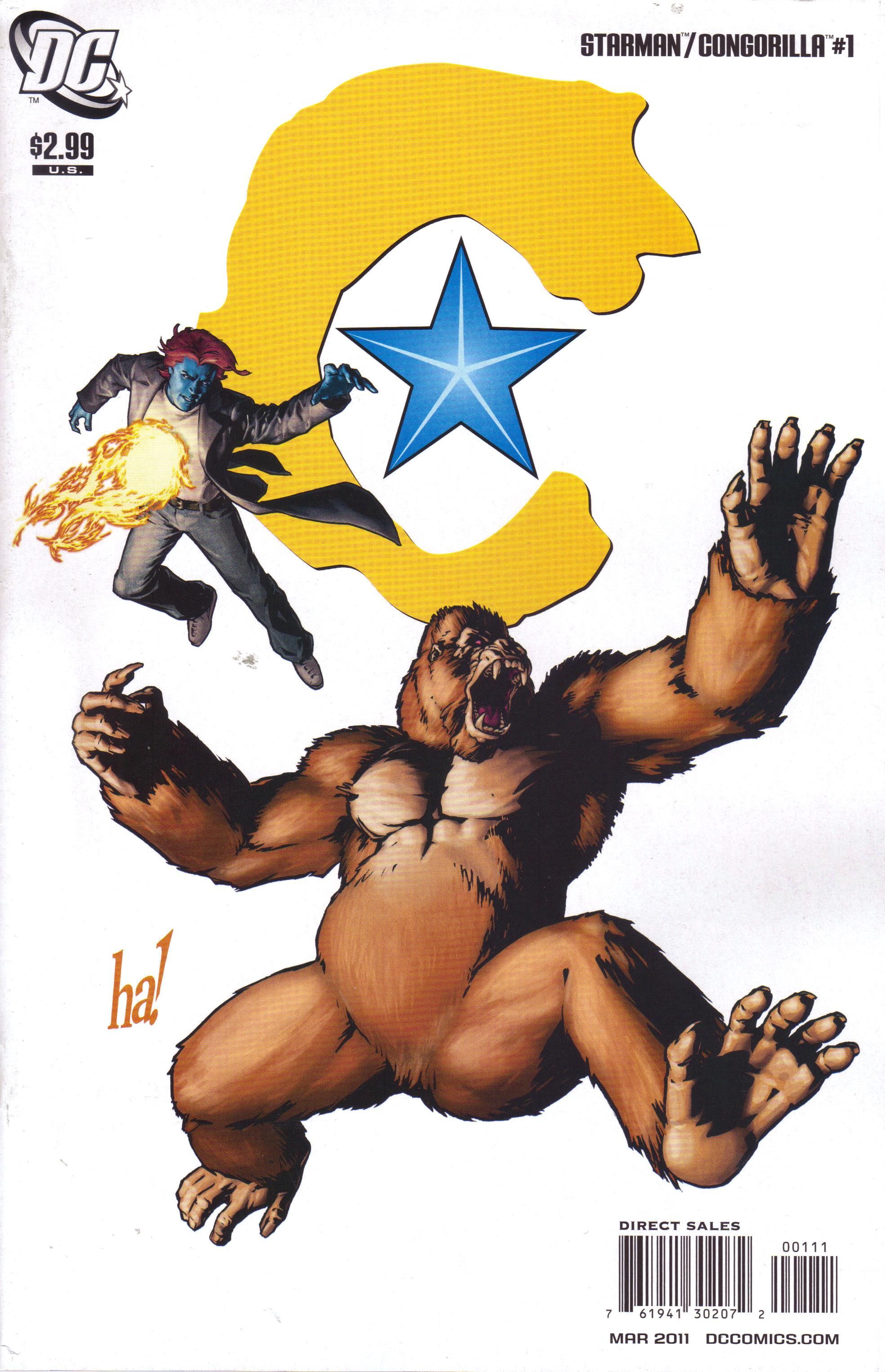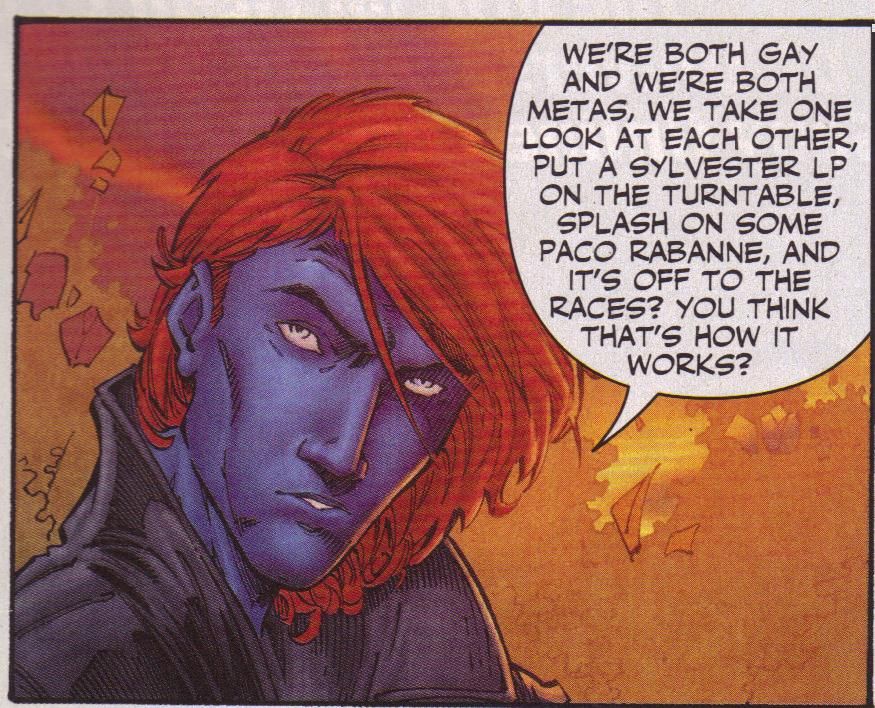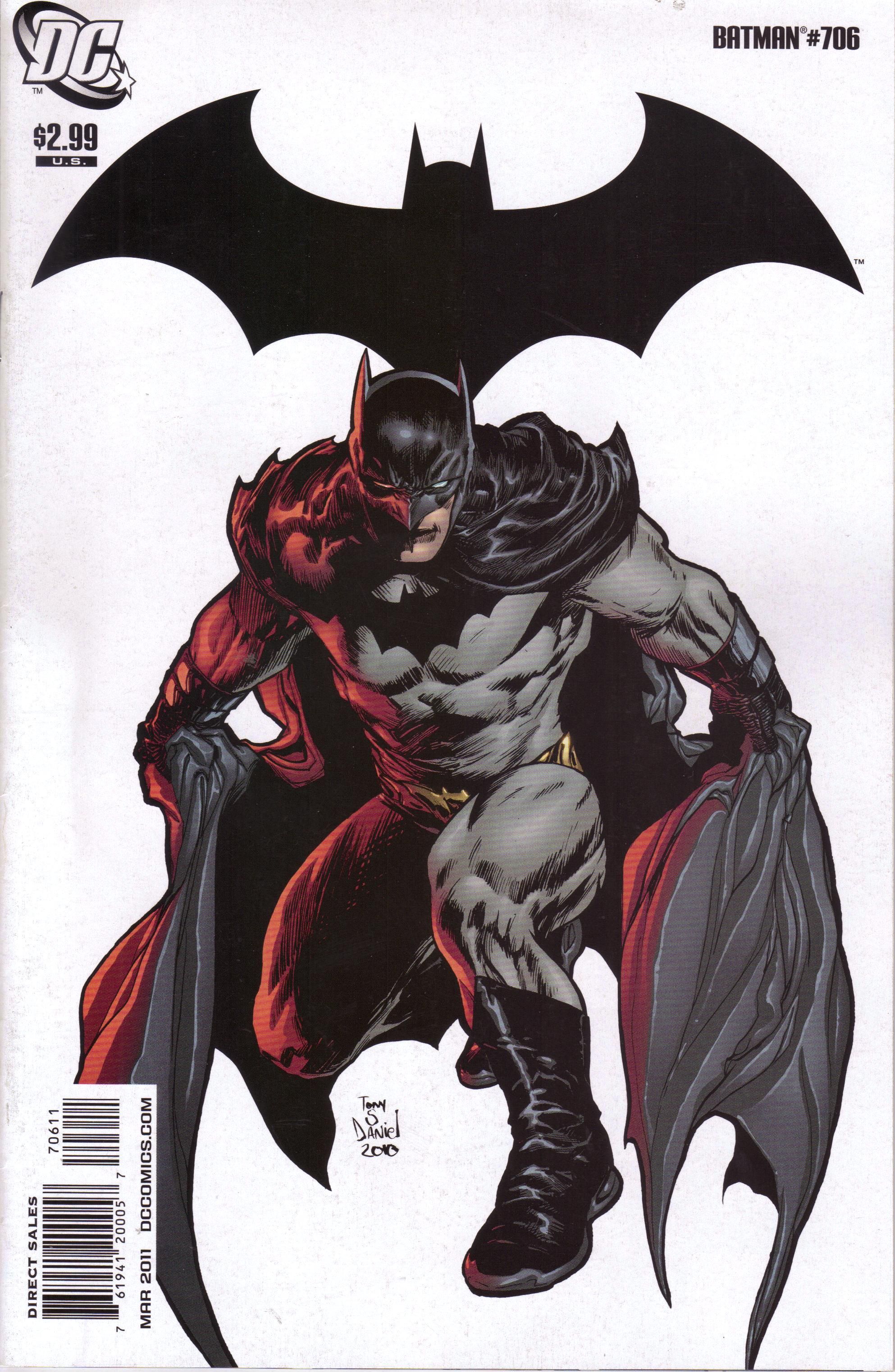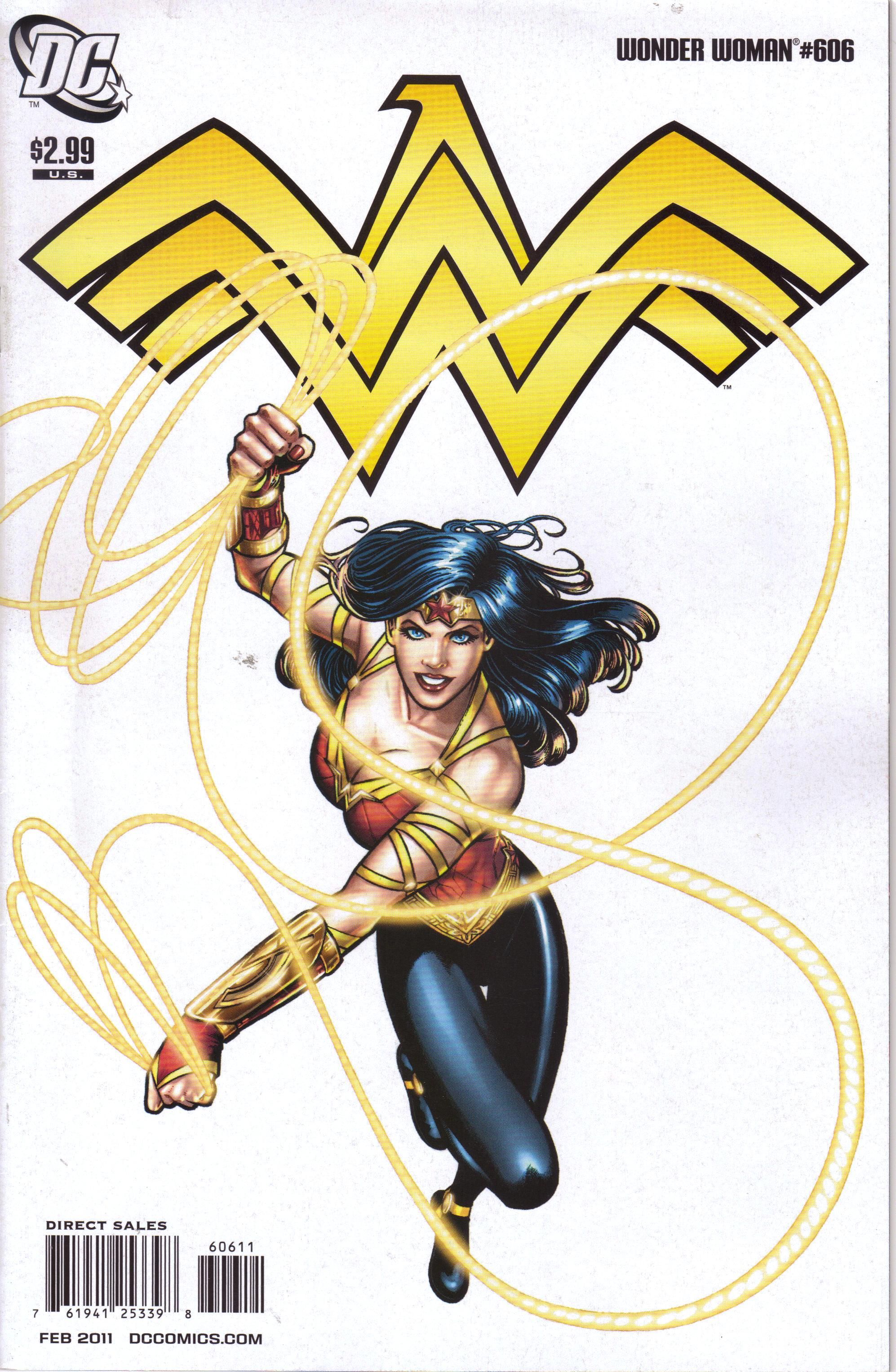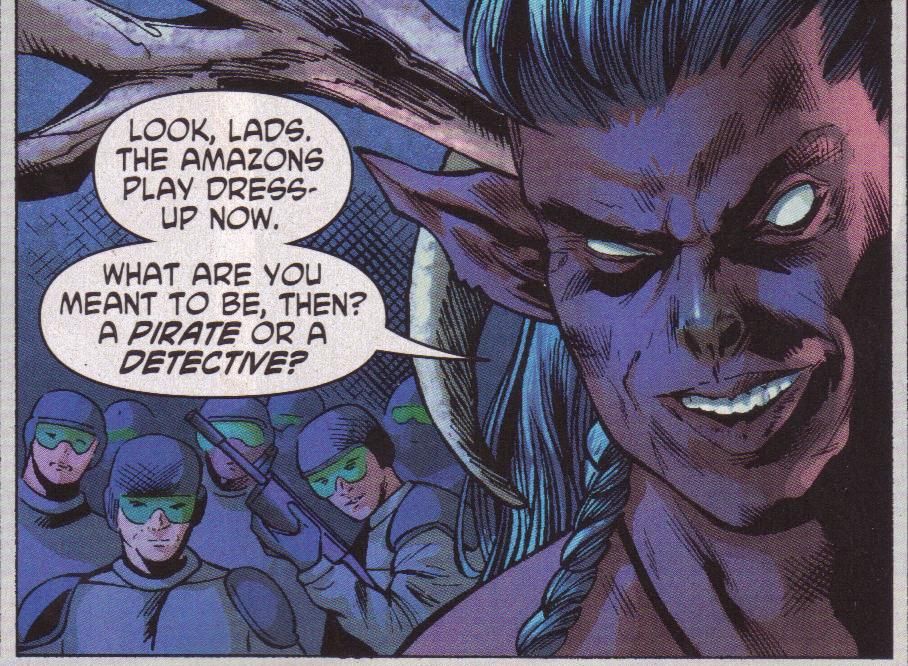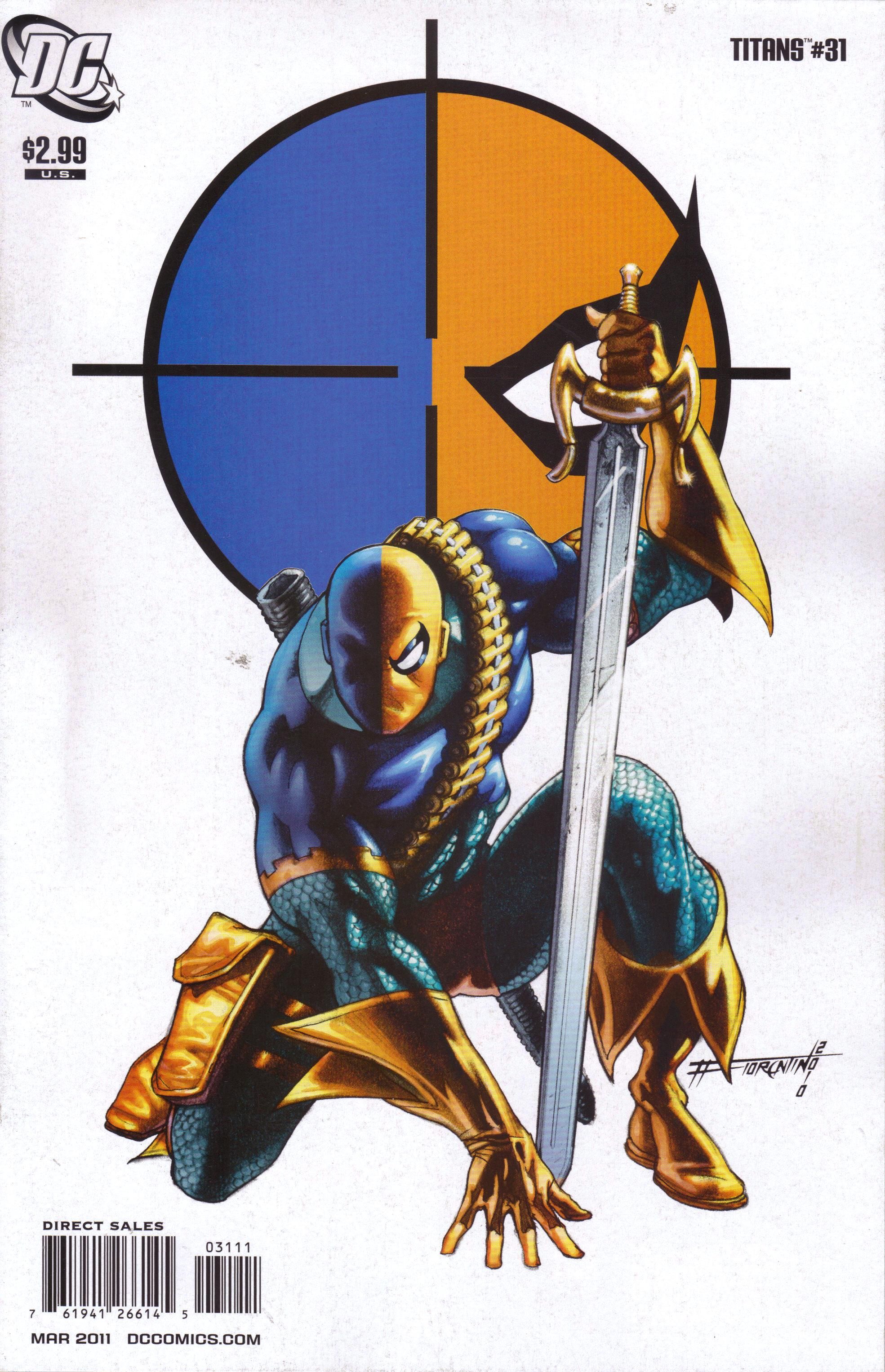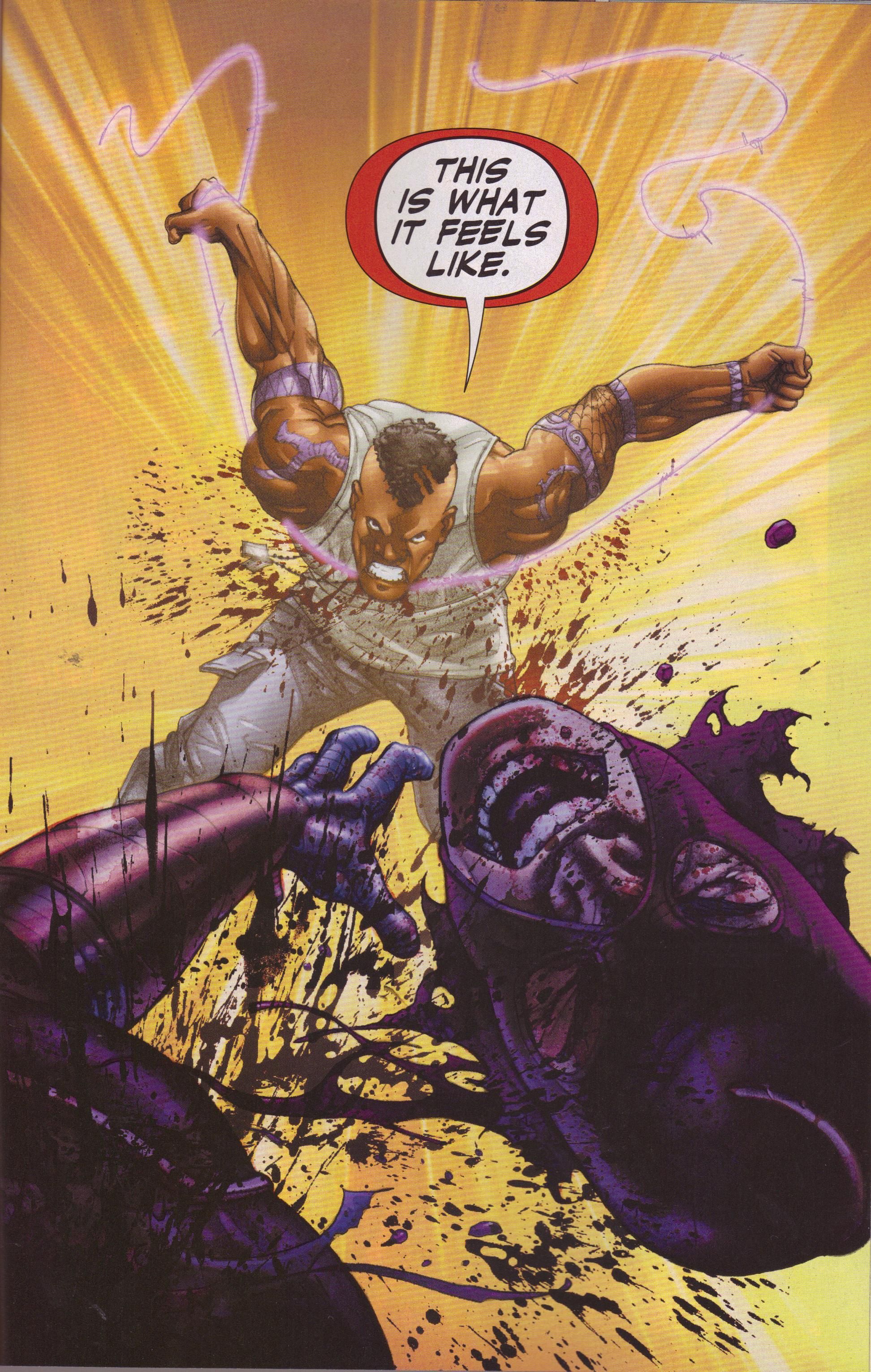Everyone take a deep breath. Here we go!
I traded in a bunch of old trade paperbacks/graphic novels at my olde locall comics shoppe, and they gave me credit. They gave me far less credit than what I paid for the books, but that's to be expected. I decided to have some fun with my credit instead of just using it on the stuff I would normally buy. So for January, I picked up every single DC comic that came out, with some exceptions (hence the asterisk). I didn't get the latest issue of Jonah Hex. They only order a few copies, and they didn't have any left over for me. Plus, from what I can tell, every Jonah Hex issue is pretty much like every other one, so there doesn't seem to be any point in reviewing them. I've read a few here and there, and while they're competently put together, I don't feel the need to start buying the series. I also didn't get any Vertigo books that I normally wouldn't, as my shop doesn't order a lot of those, either, and didn't have many left over. If I couldn't get all of the Vertigo books (beyond the ones I pre-order), I didn't want to read some and not all. So these are reviews of every single mainstream, superhero, DCU book that came out in January. It should be fun, right?
Here's a list of the DC books in January:
Released 5 January 2011:
Adventure Comics #522
Azrael #16
Batman Confidential #52
Batman Beyond #1
Brightest Day #17
Doom Patrol #18
Freedom Fighters #5
JSA All-Stars #14
Starman/Congorilla #1
Steel #1
Superboy #3
Weird Worlds #1
Number of comics: 12. Amount of credit used: $30.
Released 12 January 2011:
Batgirl #17
Batman and Robin #19
Birds of Prey #8
Booster Gold #40
Doc Savage #10
Green Lantern: Emerald Warriors #6
Justice League: Generation Lost #17
Knight and Squire #4
R.E.B.E.L.S. #24
Red Robin #19
Secret Six #29
Superman #707
T.H.U.N.D.E.R. Agents #3
Titans #31
Wonder Girl #1
Number of comics: 15. Amount of credit used: $38.
Released 19 January 2011:
Batman #706
Batman: Streets of Gotham #19
Brightest Day #18
Green Lantern Corps #56
Justice League of America #53
Legion of Super-Heroes #9
Power Girl #20
The Spirit #10
Supergirl #60
Superman/Batman #80
Number of comics: 10. Amount of credit used: $25.
Released 26 January 2011:
Action Comics #897
Detective Comics #873
Green Arrow #8
Justice League: Generation Lost #18
JLA/The 99 #4
Justice Society of America #47
Shazam #1
Teen Titans #91
Wonder Woman #606
Zatanna #9
Number of comics: 10. Amount of credit used: $25.
Total number of DC comics in January: 48 (includes Jonah Hex, which I didn't get). Amount "spent" on DC comics in January: $118.
Usually I post these in alphabetical order, but this time I'm doing them from best to worst. So yeah, the further down you go, the uglier it gets. And no links this time - I'm already a day late with this (I really wanted to post it yesterday) and those are time-consuming. So strap in, and let's review some motherfucking comics!
Batgirl #17 ("The Lesson: Frogs, Snails & Puppy-Dog Tails ...") by Bryan Q. Miller (writer), Pere Perez (artist), Guy Major (colorist), and Travis Lanham (letterer). $2.99, 22 pgs.
"Frogs" is apparently a well-regarded modern-day substitution for "snips" in the ingredients of a boy, although "snips" are eels, which are far cooler than frogs. Just sayin'.
Anyway, I was very pleasantly surprised by this issue. I know our own Kelly Thompson has been talking this up recently, but she's, you know, a girl, and the day I take advice from girls is the day they let them vote!* Plus, do I really need another Bat-book in my life? Based on this one issue, however, I might have to rethink my stance. That Thompson broad apparently knows something about comics!
I'm not sure if Mr. Miller is having Stephanie zip around bonding with other young Bat-protégés (the title seems to imply it's a multi-arc story, what with the colon and everything), but this is a perfectly good standalone issue, so who really cares, right? I'm not even sure what the set-up of this book is: It seems like Stephanie and Damian come across each other while they're working independently on the same case, which is coincidental but not overly so. Either way, it's time for a team-up! Luckily, the case they're working on involves kids being kidnapped (well, not lucky for the kids, I guess), so Stephanie suggests that Damian go undercover as a regular student. Yep, it's as funny as it sounds.
What makes the issue so delightful (yes, delightful) is Miller's script, which is smart, funny, and insightful. Stephanie and Damian have a great rapport - he's a jerk, she's bubbly, but over the course of their investigation she realizes why he's a jerk and does something about it, leading to the absolutely wonderful final scene. The book isn't all laugh-out-loud funny - Damian has some issues, after all, and Miller manages, in the course of a short story, to show us what a punk he is, why he's a punk, and what could be done about it. Miller really nails both characters' voices (well, I don't know if that's normally Stephanie's "voice," but as Miller has been writing the character for a while, I'm going to assume he knows what he's doing) and makes them different yet still peers, as they're both kids. Perez (who has to be being groomed for a big book, right?) is excellent, too - his nice clean Maguire/Sook-like lines are a perfect fit for a good, old-fashioned superhero romp like this.
I have no idea how this book is selling or to whom it's selling (it gets back to DC and Marvel not caring AT ALL about attracting new readers), but this would be a very good comic, I would imagine, for teenaged girls, not just because it stars one. It's a mature enough story so they wouldn't be bored, but it also has that hint of silliness that's, let's be honest, a big part of teenaged girls' lives (I used to teach teenaged girls who were "adult" enough to have sex and bear children but were still awfully silly a lot). It's a good comic for adults, too, as it shows the difficulties of growing up in an interesting way. I actually may have to check this series out a little more, and that means Kelly is right. Dang it!**
* Wait, they let girls vote? Man, what's happened to the repressive America I know and love?
** Let's face it - I don't want to live in a world where Kelly is right. She'd just keep getting uppitier, and we can't have that!
Rating: ★ ★ ★ ★ ★ ★ ★ ★ ½ ☆
One totally Airwolf panel:
Action Comics #897 ("The Black Ring Part Eight") by Paul Cornell (writer), Pete Woods (artist), Brad Anderson (colorist), and Rob Leigh (letterer). $2.99, 20 pgs.
Whenever I don't completely understand the plot of an ongoing, I think about different things. I know that Cornell is having Luthor try to get a power ring and there are spheres of energy he's searching for, but a lot of it escapes me. I can deal with that (I've had to deal with it this month, as I don't read a ton of DC books so a lot of these are new to me), but if the plot is a bit labyrinthine, other parts of the book have to be better. And the other parts of this book are better, which is keen. Woods' art looks less sterile than it has recently - perhaps the presence of the Joker in the book forced him to be a bit more chaotic - which is a good thing. I don't hate the style Woods is employing these days, but I do prefer his old stuff more. Meanwhile, Cornell writes an interesting confrontation between Luthor and the Joker. It's telling that after his dealing with Vandal Savage, when he was much more arrogant and even condescending, the Joker can push his buttons and also force him to be a bit more docile - he's still Luthor, but he also doesn't understand the Joker, so his defenses get breached more easily. I don't know what the deal with the pony is (I assume Cornell has made some references to it, because of some things that Luthor says), but both Cornell and Woods do a good job showing that it's important to Luthor somehow, and when you're coming into a story arc cold, that's good enough. The Joker's warning to Luthor, while vague, is still effective and a bit scary, and that's all because of Cornell's dialogue. I'm not sure if there's a screw-up with the art when the energy from the sphere expands - is Faux Lois just flat-out lying, or was Woods supposed to draw the Joker doing something? If the former, that adds an extra layer of intrigue to the proceedings. I'm not happy that the issue ends with Larfleeze, who's quickly approaching Gambit-level of "characters I hate but every writer seems inexplicably to love," but them's the breaks, I guess.
I've been saying that I'm going to get the trade of Cornell's arc ever since it began, and this issue reinforces that, because it's quite well done. I only hope DC releases it in one big trade. You can do it, DC!!!!
Rating: ★ ★ ★ ★ ★ ★ ★ ★ ☆ ☆
One totally Airwolf panel:
Red Robin #19 ("The Rabbit Hole Part Two: Caught in the Üntertow") by Fabian Nicieza (writer), Marcus To (penciller), Ray McCarthy (inker), Guy Major (colorist), and Sal Cipriano (letterer). $2.99, 22 pgs.
I mention below that Nicieza is a perfectly competent writer whose work is often forgettable, but because he's a perfectly competent writer, occasionally he'll give us something slightly more interesting - the dude writes a lot of comics, so he has to come up with something neat every once in a while, right? The central conceit of this comic (and, presumably, the first part of this arc) is that Doctor Sivana created an evil Internet called the Ünternet that was corrupted even further by Darkseid and then taken over by some dude named Mikalek. It's so idiotically COMICS!!!!! that I couldn't help but love it - especially as Tim Drake is trapped inside the Ünternet and needs to find his way out, with only a toddler version of Tamara Fox (who's his age in the real world) and Anarky (who's in a coma in the real world) to assist him. Meanwhile, the Riddler keeps walking around with them as a manifestation of Tim's unconscious, asking him stupid riddles. Of course it's silly, but when the splash page features a very 1960s Batman and Robin flying down out of the sky and face-kicking an old-school Calculator (with that ridiculous outfit), how can you not love it? And the Joker dressed as Robin is always disturbingly creepy. And Cassandra Cain has a cameo, so Kelly should definitely buy this! (Speaking of the delightful Ms. Thompson, I'm fairly certain she didn't buy this issue, because if she had, she would have been all over the Ünternet's version of the Justice League. Hell, I'd be all over the Ünternet's version of the Justice League: Cassandra Cain, Superman, Miss Martian, Black Dude Aquaman, Jaime Reyes, Wally West, Supergirl, Wonder Girl, Gar Logan, and some chick who sort of looks like Raven. Make it so, DC!) This is just a wacky adventure, and it's a blast to read. Marcus To's old-school superhero art is clean, strong, and a pleasure to read, while Major's colors make the art pop nicely. I don't know if I'll keep buying this, but I'll definitely have to think about it. I'm as surprised as you are!
Rating: ★ ★ ★ ★ ★ ★ ★ ★ ☆ ☆
One totally Airwolf panel:
Secret Six #29 ("What Luthor Has Wrought") by Gail Simone (writer), Marcos Marz (penciller), Luciana Delnegro (inker), Jason Wright (colorist), and Travis Lanham (letterer). $2.99, 20 pgs.
This is the second half of the crossover with Action Comics #896, and while it's not the greatest Secret Six comic, it's a lot better than Action Comics #896, mainly because Simone writes the characters better than Cornell does (which isn't too surprising and not really a bad thing - Cornell is a good writer, but Simone has been writing these characters for years), so even though the plot is kind of silly, it's still a good comic. At the end of the first part, it appeared everyone was going to get blown up, but through a miracle that only happens in fiction, the explosives didn't go off and everyone has time to yell at each other a bit. Really, the only thing that matters in this comic is that Scandal explains a bit about her mother and why Vandal Savage actually respects her, unlike his other multitudinous offspring - it's a nice part of the book. Other than that, it's a lot of back-and-forth between Luthor and Savage, with Rag Doll making pithy comments and the Lawton/Blake bromance taking another tentative step toward physical consummation (I'm sure it's not going to happen, but I'm rooting for those two!).
Marz's art is kind of a low-rent Pete Woods look, with decent enough drawing, a bit stiff in places, and very light inks that makes the art look a bit computer-generated even though it's probably not. I don't love it, but I don't hate it either. I wonder if they got Marz to fill in because his art does resemble Woods', and DC is planning on including this in the Action Comics trade when it comes out. I'm sure Califiore needed a break, but I wonder if they picked a guest artist whose work could fit into a trade without too big a contrast. Beats me.
I enjoyed this and I'm glad Simone tried to move the characters' arcs forward a bit even though she was trying to tie up the overall plot, but I do wish it has stayed in the pages of Action Comics. Oh well!
Rating: ★ ★ ★ ★ ★ ★ ★ ★ ☆ ☆
One totally Airwolf panel:
Superboy #3 ("The New Adventures of Psionic Lad Part One") by Jeff Lemire (writer), Pier Gallo (artist), Jamie Grant (colorist), and John J. Hill (letterer). $2.99, 22 pgs.
There are a couple of things I didn't like about this comic. On page 4, Conner whines that he feels bad he can't do anything to help the farmers who lost their crop in the big battle from last issue. That's fine, but then Ma Kent goes on about how tough it is to be a farmer and that these people have had shitty winters before and that they always come through and that they stick together in hard times because they're such a great community. It's not that I'm annoyed with the sentiment, but it feels so forced and pollyanna, as if Lemire really wanted to write a speech about how great farming communities are, that it's really out of place, because it's just presented without evidence - it's Ma Kent speechifying, and we have no idea if it's bullshit or not. It would be much more effective if we saw some of this stuff, but that's, you know, boring. This happens a lot in superhero comics - the stuff about heroism and community and toughness is often told to us by characters or, if it's actually shown, someone needs to draw our attention to it. I know it sets up Conner's idea for later in the issue, but Ma could have easily said, "They'll get by" and Gallo could have drawn the sadness in her face and that would have been enough. I thought farmers were supposed to be tight-lipped?
Anyway, that's one thing. The other is Lori's ridiculous blouse. She's wearing what looks like lingerie, not a shirt, and there's no evidence that she's wearing a bra (and I know not all women need to wear a bra, but the way she's drawn, she sure does). It's just weirdly distracting, because it's not like she's wearing tight spandex with a cut down to her navel, she's wearing what would be normal teenaged clothing, except the top looks like it's about to fall off at any time, plus the material looks sheer, like nylon or very thin cotton. It's bizarre.
Other than that, this is a fine issue, one which gets me closer to committing to this series full-time, as Lemire sets up the idiotic Superboy/Flash race well (it's Conner's idea to raise money for the community), while the main story is a decent mystery as to why everyone in the high school is getting a headache and then collapsing (the title of the issue gives you a clue). I'm not sure I buy a few things - Conner telling Simon he can't be friends with him because if Simon is hanging out with Superboy and Conner, people might start to figure things out; Conner himself making no effort to hide his secret identity - all he does is take his shirt off, but he's wearing the same pants and shoes as he was before, so even though Lori sees him change, how could she not know who he is? - but it's still a well done superhero comic. Lemire, like Nick Spencer in T.H.U.N.D.E.R. Agents (see below), appears to be doing a good job writing solid single issues while still building a larger story, and it's a nice balance. Some writers are good at that, and some, as we'll see as we move down the list, are not.
Rating: ★ ★ ★ ★ ★ ★ ★ ★ ☆ ☆
One totally Airwolf panel:
T.H.U.N.D.E.R. Agents #3 ("The Man Who Wasn't There ...") by Nick Spencer (writer), CAFU (penciller), Howard Chaykin (artist), Bit (inker), Santiago Arcas (colorist), Jesus Aburtov (colorist), and Steve Wands (letterer). $2.99, 20 pgs.
T.H.U.N.D.E.R. Agents continues to be an intriguing series, especially as Spencer seems to enjoy these slow burns with regard to the overall plot while still writing good single issues. I assume that if the series survives longer he'll start to assume we know who's who, but early on, at least, he's doing a good job introducing the characters and telling a larger story, which is nice. In this issue, Colleen goes to visit NoMan, an old T.H.U.N.D.E.R. agent whose deal is that he figured out how to transfer his consciousness into an innumerable number of clones, all of whom are blue-skinned. He doesn't trust T.H.U.N.D.E.R., so Colleen has to leave Toby outside, much to his chagrin. NoMan - Anthony Dunn - has an invisibility cloak, which is why Colleen wants him - they need him to sneak inside the compound where Raven is being held and snatch him back from the Spider cell that's holding him. In between, Chaykin illustrates Dunn's "secret origin" and shows how, whenever he transfers his consciousness, he loses a bit more of his humanity, so by the time T.H.U.N.D.E.R. fires him, he's almost Dr. Manhattan-esque (it doesn't appear that this characteristic is evident in the original series, so I wonder how much Spencer lifted this from Watchmen). Colleen, however, tells him something that gets him back in the game (we don't know what it is; she turns off the audio that Toby is listening to at that crucial moment), which is obviously part of Spencer's bigger plot. And, of course, Dunn's mission goes off the rails, plus there's a traitor within T.H.U.N.D.E.R. itself - oh dear. That's never good (I won't give away who it is, but Spencer ends the issue by revealing who it is).
I'm liking this series quite a bit - it's fun that DC gets different artists for the flashback sequences (I know it's a way to make sure CAFU doesn't have to draw so much each issue, but it's still a smart move), and Spencer is doing a nice job giving us solid single issues that slowly build on what comes before while pointing the way to a larger story. So far, the bad guys (Spider) don't seem all that impressive, as we haven't gotten a lot of what their deal is, but that's okay - I'm sure we'll get to that soon enough. It's an enjoyable series so far, and I hope it's selling well enough to keep it going.
Rating: ★ ★ ★ ★ ★ ★ ★ ★ ☆ ☆
One totally Airwolf panel:
Batman and Robin #19 ("The Sum of Her Parts Part 3") by Paul Cornell (writer), Scott McDaniel (penciller), Rob Hunter (inker), Alex Sinclair (colorist), and Patrick Brosseau (letterer). $2.99, 20 pgs.
I was harsh on the second issue of this three-issue arc, and I don't regret it, because it was a poorly-written issue, but I was also willing to see where Cornell was going, because it certainly is difficult to see the forest for the trees occasionally in serialized fiction (one of the banes of serialized fiction, as we well know). So even if I weren't buying every DC comic in January, I would have picked this up, and I'm glad I did, because Cornell rescues the lousy second issue with a very interesting final issue, as Una Nemo gets Dick and Damian in a classic Bat-villain death-trap and then proceeds to explain herself while arguing with Dick about her motives. Cornell does a very nice job highlighting all the clichés of villains (especially comic-book ones and James Bond ones) who stand around and talk instead of just shooting the good guys (Seth Green doesn't show up to suggest that, although it feels like he should), and in the end, we get a very interesting new Bat-villain and some serious questions about Bruce Wayne and what he does to people. As much as I thought the second issue was ham-fisted, the entire story shows that it was deliberately so, which doesn't completely mitigate it but at least shows Cornell's game plan a bit better. I liked the entire story because I'm always interested in comics that toy with our expectations and don't follow the formula, and although Una does follow a formula (she even tells us what formula she follows), it's an unlikely one, and it's fun to read. I imagine it will read much better in a trade, when the deficiencies of the second issue are quickly explained away rather than festering for a month, but such is the way of comics publication!
Rating: ★ ★ ★ ★ ★ ★ ★ ½ ☆ ☆
One totally Airwolf panel:
Booster Gold #40 ("The Life and Times of Michael Jon Carter") by Kieth Giffen (writer), J. M. DeMatteis (writer), Pat Olliffe (penciller), Rich Perrotta (inker), Hi-Fi (colorist), and Sal Cipriano (letterer). $2.99, 20 pgs.
Giffen and DeMatteis try to get new readers caught up, as this is exactly what the title of the issue says it is: A recap of Booster's origin and life in general. They skim it, of course (it's only 20 pages long!), but if you've never read a Booster Gold book, this is a pretty good summarization of who he is and how he came to be! The Nazi mad scientist from a few issues back, who survived the explosion of his lab and was thrown into the future, has spent a decade building up his wealth and planning his revenge on General Glory and Booster Gold. As Glory is now, you know, dead, Doctor Nishtikeit is now concentrating on Booster. So one of his underlings has compiled a report on Booster in the 25th century, and that's what we get. Then Booster himself shows up fighting a wacky bad guy (called Hit Point, because he is), and we get a bit more exposition about Booster's time in this century (after he's banned from his favorite Sundollar Coffee place because he draws the attention of too many wackos). FInally, he talks to Rip Hunter about what kind of man he was and what kind of man he's become. It's a perfectly fine issue, giving us everything basic we need to know about Booster. I don't know why Giffen and DeMatteis chose to do this; perhaps sales have been getting better and people are getting it just because of the writers and don't know much about the character? Either way, it's a bland issue, plot-wise, but filled with the Giffen/DeMatteis Brand of Humor, so it's fun to read, at least. I didn't like the ending, when Rip Hunter arrests Booster for his 25th-century crimes (stealing artifacts, that sort of thing). I guess it's going to lead into the next story arc, but why would Rip suddenly care about Booster's crimes? Didn't he know Booster stole all those artifacts before now? Why hasn't he arrested him before? It seemed awkward, but it's just a plot device to get Booster into prison (I think I saw in the solicitations that he's going to prison, right?), so I can deal with it.
This issue isn't as energetic and funny as the previous ones have been, but it sets up some plots and gets everyone squared away with regard to Booster and his deal. There's nothing wrong with that.
Rating: ★ ★ ★ ★ ★ ★ ★ ½ ☆ ☆
One totally Airwolf panel:
Detective Comics #873 ("The Black Mirror Part Three of Three") by Scott Snyder (writer), Jock (artist), David Baron (colorist), and Jared K. Fletcher (letterer). $2.99, 22 pgs.
This is a disappointing ending to Snyder's first arc, mainly because Dick really doesn't do any detecting and the bad guy turns out to be just another monster. I don't like a lot of supernatural elements in my Batman books, but I can live with a little bit, and I think Snyder crosses the line a bit too much here. Dick escapes the crowd that was about to eviscerate him, and then, after recovering from the drug that he was dosed with, finds the bad guy rather easily and stops him. On top of that, we get a classic ambiguous ending which means we'll see this bad guy again. For a rather creepy and unusual set-up, the ending feels rushed (perhaps we could have had another issue?) and totally anticlimactic. That's not to say there aren't some good parts - when Dick first wakes up from his drug-induced sleep, the hallucination he has is very effective (even though we know it's fake). Another reason I don't like the ending is because Jock doesn't seem to do bombastic superhero action all that well - earlier in the arc, when things were creepier, he was much more effective, but the end of the arc lacks the punch it needs (so to speak). The lack of the back-up story, strangely enough, hurts the issue, and as next issue continues that story, couldn't DC have let it go just this once? I guess holding the line is more important than telling a good story. I know that Snyder is planning on continuing the back-up, but it felt like an integral part of the main story, and its absence is felt.
I'm definitely not giving up on Snyder's Detective yet, because it shows a lot of promise in this arc, but I hope he had Dick do more down-to-earth stuff, especially as Bruce is winging around the world fighting giant octopi and riding buffalo. It would make a nice contrast!
Rating: ★ ★ ★ ★ ★ ★ ★ ½ ☆ ☆
One totally Airwolf panel:
Justice Society of America #47 ("Supertown Part Four") by Marc Guggenheim (writer), Scott Kolins (artist), Mike Atiyeh (colorist), and Rob Leigh (letterer). $2.99, 20 pgs.
Now, see, unlike a lot of the big dumb superhero comics further down on this list, this is a well done big dumb superhero comic. Despite the fact that it's "part four," Guggenheim does a fairly good job getting us up to speed. The JSA are in a city called Monument Point (which is not too far from Washington, D.C. - geography is a bit odd in this book, a point I'll come back to) helping clean it up - something happened there that has destroyed the city (I remember back when these issues were solicited, how I ranted against DC calling every event the worst terrorist attack on American soil when something like it happens every six months or so - I assume that's what they're talking about in this issue), so the JSA is on the scene. Dr. Mid-Nite, meanwhile, is in Jacksonville, checking in on Alan Scott, who had what appeared to be a heart attack. Unfortunately, Alan Scott has disappeared - this is a subplot that's unimportant for this issue, at least, as Mid-Nite is easily distracted from Scott's disappearance and Guggenheim checks in on Scott for one page later in the issue, so I'm sure it will play out later on. Mid-Nite, meanwhile, is distracted by a young woman named Lightning, whose body is apparently dead but whose soul has been taken elsewhere by Dr. Fate so that it doesn't go on to the afterlife (this is so she can be resurrected if Mid-Nite can fix her body). Finally, there's Dr. Chaos, the villain of the piece, who has a big plan to destroy the JSA, one which involves blackmailing Mr. Terrific because that hero is slowly losing his intelligence thanks to something a different bad guy did to him, and Dr. Chaos claims he can fix it as long as Terrific lets some completely different bad guy out of prison. All clear? It does actually track fairly well, and it's an interesting plot that Guggenheim has going on. Dr. Chaos wears a silly costume but he has a certain charm in his villainy, and of course everyone knows that if you have a good villain, you're far along the way to having a good comic. Even when the JSA surprises him, he keeps it together nicely. The only thing I don't quite get is where the book takes place. In the beginning, Jay Garrick is in Monument Point, and it appears that Dr. Chaos is hanging out there as well. The villain he wants Terrific to spring is in a Monument Point "jail" - a bank vault they converted into a holding cell. But Mid-Nite is in Jacksonville, and he says that Jay is taking Lightning's body back to Tampa, but I'm not sure if he ever left Florida. I guess he did, but did the Flash carry him up to Virginia (or Maryland, I suppose)? How did he get to Monument Point? It doesn't bother me too much, but it's a bit weird.
I enjoyed Scott Kolins' art on this book a lot more than I did on his recent issue of Flash. It's still his new style, but it's a bit rougher, less stiff, and he does a really cool job with Lightning's soul and whatever is going on with Alan Scott. I still prefer his old style, I think, but this is quite good.
I don't think I'll keep getting JSA, but it's a pretty enjoyable superhero book. That's certainly not a bad thing!
Rating: ★ ★ ★ ★ ★ ★ ★ ½ ☆ ☆
One totally Airwolf panel:
Knight and Squire #4 (of 6) ("For Six Part Four") by Paul Cornell (writer), Staz Johnson (layouter), Jimmy Broxton (finisher), Guy Major (colorist), Dave Sharpe (letterer). $2.99, 23 pgs.
Here at the blog, there's been a contingent of folk who keep telling me to get this, and I have to explain that with DC and Marvel mini-series these days, I'm waiting for the trade because it's just more economical and efficient. And then there's Mr. Chad Nevett, who doesn't much like this series, and I think Chad knows what he's talking about for the most part (even though we disagree on several comics' worth). I'm still probably going to get the trade, but this issue, for instance, doesn't fill me with too much confidence.
It's not that it's a bad issue, but it doesn't sparkle like many people say the first three issues have done. Cornell has a good handle on the characters, and the relationship between Cyril and Beryl is very nice - Cornell writes them a bit like brother and sister but also like mentor and protégé ... except that in some scenes, Beryl is the mentor, a nice twist on the dynamic. The central battle of the issue is between Cyril and his armor, which has come to life through COMIC-BOOK SCIENCE!!!!! to hassle him, and it's interesting because the armor is the "heroic" part of Cyril, while the actual Cyril is much more complex and therefore human. Cornell makes an interesting point about costumed heroes and their façade of heroism - how much is just an act? It's not in any way a unique point, but it's one worth making every once in a while. The other story, of Beryl's "date" with the Shrike, doesn't work as well, mainly because the Shrike is such a complete tool and it feels really off, both that he would be so and that Beryl would forgive him so quickly. It just felt odd and undercut what could have been an interesting dilemma about superheroes and their secret identities and Beryl's abilities to ferret out information. Instead, it seemed rushed and silly - and not silly in a good way.
I'm still going to keep checking out what people say about this series and decide about the trade when it's offered, as this issue didn't sway me either way. It didn't make the trade a "must-buy," but there's enough in here that's intriguing, so I'll just wait and see, won't I?
Rating: ★ ★ ★ ★ ★ ★ ★ ½ ☆ ☆
One totally Airwolf panel:
Teen Titans #91 ("After School Special") by J. T. Krul (writer), Nicola Scott (penciller), Doug Hazlewood (inker), Scott Koblish (inker), Jason Wright (colorist), and Sal Cipriano (letterer). $2.99, 20 pgs.
Ah, Nicola Scott. Why don't you work on a book I really want to read? Teen Titans is surprisingly decent, but it's helped quite a bit by Scott's pencils - her figure work has always been quite good, but her layouts in this comic are really good, and she draws teenagers that look like teenagers, which is a plus. I do wish she would return to Secret Six - she went off to do Wonder Woman, which I assume is a step up, but Teen Titans has to be a lateral move from Secret Six, right, so when she wasn't doing Wonder Woman anymore, couldn't she have returned to Secret Six? Beats me. Oh well, I'll live.
Krul's story is pretty good, too. On the first page, there's a young boy who poisons another kid, and it's obvious that it takes place in the past (this is confirmed when the boy is shown later as a grown-up). The man narrates that science is messy and always needs tinkering, and so this entire issue is this guy tinkering with science and the consequences of that. I assume that we know why, on the second page, we see him dressed in what looks like a crimson Klan outfit, because we don't see that costume again, but it's obvious that it's him, and he's experimented on some kids who have gotten out of control and the Titans need to stop them. In one school, a telekinetic opens a black hole and threatens to suck all the Titans down with him. In what I assume is a different school, Robin and Deathstroke's daughter (whose superhero name escapes me) fight through a bunch of teenaged zombies. Both stories are fairly standard fare, but Krul's dialogue when Damian and Deathstroke Jr. is very well done, as Damian is forced to admit to himself that he respects her (plus they can share stories about crazy parents!). Krul does a noce job with the climax of the fight with the telekinetic - Raven cuts loose, which is always interesting because she's usually so tightly wound. As with all standard superhero stuff, the goodness is in the details, and this is pretty good.
I don't think it's quite enough to get me to buy Teen Titans on a regular basis (especially because I don't know how long Scott will be drawing it), but it's close. I may change my mind - you never know!
Rating: ★ ★ ★ ★ ★ ★ ½ ★ ☆ ☆
One totally Airwolf panel:
Batman: Streets of Gotham #19 ("The House of Hush Chapter Four: The Reason for Hyenas") by Paul Dini (writer), Dustin Nguyen (penciller), Derek Fridolfs (inker), John Kalisz (colorist), and Steve Wands (letterer). $2.99, 20 pgs.
Boy, Dini has a real hard-on for Hush, doesn't he? Whenever I turn around, he's writing yet another Hush epic. I mean, that's great and all, but has anyone been really impressed with what he's done to good ol' Tommy Elliot? When he first showed up, he was a terrible character. Has Dini made him interesting? It doesn't seem like it from this issue.
Anyway, as this is part four of a story, I expected to be a bit confused, and I was, but luckily, it's a mainstream superhero comic, so the overriding idea in any mainstream superhero comic is "bad guys want to beat up good guys," and when Batman is your good guy, you can figure it out from there. Hush has some scheme that involves Dr. Death and some other gangsters doing something to Bruce Wayne, and then he decides he'll take out the Joker as well, and maybe John Zatara is involved? I don't know, because this is a labyrinthine plot with a ton of characters, and while I'm sure it makes sense as part of the bigger picture, it doesn't make a lot of sense in this single issue. I mean, here's a list of the characters: Hush; Dr. Death; a henchman named Mr. ZZZ; a bad guy named Judson Pierce (who ordered the hit on Martha Kane, Bruce's mother - thanks, Internet!); Anthony Marchetti, another gangster; the Joker (in a flashback), Sallie Guzzo, Anthony's uncle, who also shows up only in flashback; two Joker henchmen who don't say much; Jeffrey Carter, a Wayne employee; Batman (Bruce); John Zatara; Thomas Wayne; Martha Kane (obviously, the previous three are all in flashback); Selina Kyle; and some creepy dude with crazy dreadlocks who's apparently been around before. That's a lot of speaking parts, and with two separate flashbacks, it's kind of convoluted. I appreciate that Dini packs quite a bit into twenty pages, but it seems like he's making a simple story more complicated than it needs to be. The other thing that bugs me about the writing is that Dini implies that when the Joker first showed up, he was the clown of the 1950s and then quickly evolved into the psychopath we all know and love. Obviously, this is patently false, as the Joker was a psychopath first, then a clown, then a psychopath again, and while I understand why Dini did this, it bugged me. I mean, anyone who's ever read a superhero comic probably knows the first Joker story, in which he kills several people.
Nguyen is amazing, of course, keeping his base style but giving us some rougher-looking backgrounds of the city and the circus where the Joker is holed up, which is pretty neat. Kalisz's coloring in the Joker flashback is strange as it makes it look like the Joker doesn't have white skin, so it looks off, but it's not too horrible considering the entire flashback is sepia-toned. But it's still bizarre. And I can't get over that Hush wears a costume. It looks dumb and out-of-character.
I can certainly see that if you like Dini and what he's been doing with the character or if you like art a lot more than story, you'd pick this issue up. It doesn't make me care enough to find out what's going on, though - like I wrote, it's perfectly easy to figure out even though Dini seems to go out of his way to make it complicated, but the actual plot doesn't really do anything for me, and I don't really get a lot out of Dini's actual writing. I like Nguyen, but his art alone isn't going to get me to buy this. Such is life.
Rating: ★ ★ ★ ★ ★ ★ ★ ☆ ☆ ☆
One totally Airwolf panel:
Birds of Prey #8 ("The Death of Oracle Part Two of Four: The Gauntlets and the Guillotine") by Gail Simone (writer), Guillem March (artist), Nei Ruffino (colorist), and Travis Lanham (letterer). $2.99, 20 pgs.
We jump into the middle of a story arc, but Simone is always good at getting us on board, so it's not too hard to figure out. Calculator has hired some bad guys to find and kill Oracle, because Babs went and screwed with his memory after he found out her real identity. So now he's dying for some unclear reason (at least from this issue, and we only have his word to go on, so perhaps he's not actually dying), and he wants revenge. Meanwhile, the Penguin is somehow involved.
Simone is a good writer, so there's nothing really terrible about this (well, except for something strange that I'll get to), but it doesn't give me much of a reason to keep buying it, either. It's definitely one of those books where, if you've been reading along, I can see why you like it, but someone who hasn't been probably won't be interested. I like Oracle and the characters in here, but not to the point where I desperately need to read the book. Simone has a good handle on the characters - with the exception of Helena, who seems a bit too oddly awestruck by Batman and Black Canary fighting in tandem and doesn't fight anyone, even though she seems perfectly healthy - and has some nice dialogue in the book - the brief scene with the Penguin as he tries to explain charm to potential waitresses is hilarious - so there's that. She also falls in line with the kindler, gentler Batman that editorial has decided upon, and Bruce is an interesting addition to the story. It's a solid superhero book, and although I don't like anyone referencing or building upon Identity Crisis (as Simone does; that story should never be spoken of again, in my humble opinion), if seems Simone is moving toward a reckoning with regard to Barbara's tampering, so that might work out well.
I had a problem with a couple of things in the book. First, the descriptive tags used for the characters. I'm not a huge fan of descriptive tags, but there are a lot of characters in this book, so I'll live with them. However, Simone decides to name the characters and then, underneath the names, list their "powers." Here are some examples of "powers": "Heroic WWII fighter pilot"; "world's premier infojack and data specialist supreme"; "intelligent"; "compassionate"; "one of the world's most dangerous hand-to-hand fighters"; "gifted and fearless fighter and marksman." In case you're wondering, none of those are actual "powers," but the one that cracked me up the most is that Dove is "compassionate." That's a power? Man, half the world is super-powered! I get what Simone is doing, but I wish she had used a different word than "powers" because, really, Oracle, Lady Blackhawk, and Huntress don't actually have any powers. Yes, I like to nitpick. Sue me.
The other thing that bugged me was the presence of the bad guys at the end of the book. Okay, so Calculator hires three supervillians to take out the team and find Oracle. If you read through the book, those are the only three villains standing around talking to the team for the first twelve pages of the book. Suddenly, at the bottom of page 13, Dinah is punching some dude in a uniform and telling us, in a caption box, that there are "a lot of these bastards." Um, what? On the next page, Batman shows up, and there ARE a lot of these bastards, and when Helena and Zinda get some bystanders outside to safety, there are even more of them. But who the heck are they? They weren't in the first part of the book, and nobody explains them. Was this part of the two pages of script that got cut when DC sliced them off their story size so they could "hold the line"? I don't know, but it was a glaring weakness in the issue.
I do like March's art, though. He was the only reason I was even a bit interested in Gotham City Sirens, and I wouldn't mind at all if he started drawing a book I really want to read. We shall see!
Rating: ★ ★ ★ ★ ★ ★ ★ ☆ ☆ ☆
One totally Airwolf panel:
Doc Savage #10 ("Inter Arma") by Ivan Brandon (writer), Phil Winslade (artist), Dave McCaig (colorist), and Rob Leigh (letterer).
I suppose this is the second part of an arc, possibly, because Brandon simply drops us into the middle of the story and gives us no reason why on earth he's there - are we supposed to just accept it, as it's not that difficult to follow the story, or was there a reason in the previous issue that he's there? It doesn't really matter, but as it appears the story continues next issue, I just wondered about it.
Anyway, this is a perfectly serviceable comic, although it has nothing really to recommend it. Brandon tells a simplistic morality tale, as Doc Savage is hanging out with a group of Marines in some Middle Eastern country (it's unidentified, but it's in the desert and some people dress in traditional Muslim garb, so there's that) fighting a war, and Doc is trying to fight a kinder, gentler war. He avoids killing people and actually implies that the soldiers should feel bad about killing their enemies, which seems awfully sanctimonious for someone who's close to superpowered. Doc plans how he can disable the enemies without killing them, and he saves a boy whom one of the soldiers throws off a roof (he didn't realize it was a kid; to be fair, the kid was shooting at them). It's a dull book because it's as unsubtle as you can get, and while I hate war and wish people could figure out ways to solve their differences in less bloody ways, it's silly to think that soldiers in a war are going to fight in a way so that they don't kill needlessly. I don't mind the simple message of this book, but more its ham-fisted delivery. Winslade's Doc, unfortunately, is lousy as well - he's inconsistently drawn, at time appearing somewhat svelte (for a muscle-bound dude) while at other times his chest looks like a block of crudely hewn granite. His head is often too small for his frame, as well, which makes him look weirdly grotesque. I've liked plenty of Winslade's art in the past, but this is not very good.
Doc Savage #10 is one of those completely forgettable but perfectly competent issues that you may not recall minutes after you've read it. Both creators have done far better work, so I suggest you find that instead of spending your money on this issue.
Rating: ★ ★ ★ ★ ★ ★ ★ ☆ ☆ ☆
One totally Airwolf panel:
Justice League: Generation Lost #17 and #18 ("Code Blue" and "Old Friends") by Judd Winick (writer), Joe Bennett (penciller, issue #17), Jack Jadson (inker, issue #17), Ruy José (inker, issue #17), Matt Ryan (inker, issue #18), Hi-Fi (colorist), Sal Cipriano (letterer, issue #17), and John J. Hill (letterer, issue #18). $2.99, 20 pgs each.
For pure superhero comics, you can't go wrong with JL: GL, as Winick is only concerned with speeding from plot point to plot point as quickly as possible. Unlike another twice-a-month comic below, however, the plot is much tighter, so it holds together much better - it's still Captain Atom, Fire, Ice, Booster Gold, and Blue Beetle versus Maxwell Lord, which is pretty danged easy to follow. I'm ignoring the fact that Maxwell Lord seems to be the most powerful human who ever lived, because it's all part of suspending my disbelief, and he makes a good villain (even though, in the two issues' best moments, he tell Jaime he's not the bad guy - a belief he's had for years, but Winick does a nice job building up to it). In these two issues, he tortures Jaime for answers about his suit, takes over Checkmate (again, right?) and does dastardly things. Meanwhile, Captain Atom is ambushed by Power Girl, who sees him as a Superman who advocates killing, so she fights him. Eventually they break through her Lord-programming and she joins the fight. Onward!
It's a perfectly fine superhero story, and if I still loved pure superhero stories or if the price was half of what it is, I'd probably be buying it. Like Brightest Day (see below!), it feels like a comic that simply updates us on what minor characters are up to, and as I like the characters in this comic more than those in BD, I'm a bit more partial to JL: GL. As I mentioned, the reason this is better than Brightest Day is that it's more focused. It's not great, but it's not bad, either.
Rating: ★ ★ ★ ★ ★ ★ ★ ☆ ☆ ☆
One totally Airwolf panel:
JSA All-Stars #14 ("The Puzzlemen Part One of Three: Appassionato") by Matthew Sturges (writer), Freddie Williams II (artist), Richard and Tanya Horie (colorists), and Pat Brosseau (letterer). $2.99, 22 pgs.
In much the same vein as the other issues in the 7-star rating range, this is a perfectly fine superhero comic that doesn't really do much to rise above that level. Sturges tells the story of some dude named Arthur Pemberton (the name is familiar, and while it's obvious he's a continuing villain in this book, I know I've read about him somewhere else) who is going around collecting artifacts of ancient and unknown origin. He's doing this for a group of hooded and apparently inhuman magicians who want to, you know, rule the world. Pemberton wants them to heal his comatose daughter as part of the bargain. As he's going around killing people in order to get these artifacts, the JSA is interested, but their first encounter with Pemberton goes poorly, as it must (it's only part one!). Meanwhile, the normal subplots in a book like this continue or begin - I'm not sure.
As with many of these comics, there's nothing really wrong with JSA All-Stars, and if you really like these characters, I can see why you would like it. Williams' art is good (although I doubt if the explosion early on would strip all the skin off of the bone, as he shows one of the deceased as a skeleton, which seems wrong), Sturges does a decent job introducing the entire plot, and we move merrily along. If you're not reading this, there's no reason to pick it up, but if you are, there's no reason to drop it, either.
Rating: ★ ★ ★ ★ ★ ★ ★ ☆ ☆ ☆
One totally Airwolf panel:
Legion of Super-Heroes #9 ("One Last Durlan") by Paul Levitz (writer), Yildiray Cinar (penciller), Wayne Faucher (inker), Hi-Fi (colorist), and Sal Cipriano (letterer). $2.99, 20 pgs.
This Legion book is slightly better than the other two Legion books, mainly because Cinar is the best artist on the three of them. Levitz's story is more interesting than the one in Adventure Comics (see below!), as Chameleon Boy and Brainiac 5 visit Durla while other Legionnaires try to stop a Durlan assassin from killing a United Planets councillor. This would obviously be much more dramatic as part of a bigger stort arc, because the ending has no impact on someone who hasn't read the book before, but that's okay. There's a lot of talk about R. J. Brande, some dude who apparently helped rebuild Durla, but that's again part of the bigger story arc, so Levitz doesn't go into it too much.
Cinar is the draw of the book, as he does a very nice job with the art. He gives us nice dragons and other weird creatures that the Durlans morph into, and he adjusts the art to a more painted look when Tellos ventures into Dawnstar's consciousness. Cinar was a good artist when he started drawing Noble Causes, and he's just gotten better at DC. I would love to see him draw something I actually want to read, but I won't hold my breath!
Legion of Super-Heroes has some things to recommend it, but it's also just another superhero book, essentially. There you have it!
Rating: ★ ★ ★ ★ ★ ★ ★ ☆ ☆ ☆
One totally Airwolf panel:
JLA/The 99 #4 (of 6) ("The City That Never Sleeps") by Stuart Moore (writer), Fabian Nicieza (writer), Tom Derenick (penciller), Drew Geraci (inker), Allen Paasalaqua (colorist), and Rob Leigh (letterer). $2.99, 21 pgs.
I wasn't surprised at all by this comic book, because when you put Fabian Nicieza and Tom Derenick on a book, you're probably going to get something like this - a pleasant, forgettable superhero book with absolutely nothing to recommend it but nothing you can really point to as horrible, either. The art is sturdy and fairly dull but gets the job done (Derenick does a few nifty things - Batman wearing the Psycho-Pirate's mask is a nice splash page), while Moore and Nicieza go through the paces of a superhero epic without really making it anything great. Hawkman appears like he needs to lay off the steroids as they're making him enraged too much, but that's just a minor part of the issue. There's a big plot about Starro, and for some reason Batman thinks he needs the Psycho-Pirate's mask (not sure exactly how that's going to work), and the final page is kind of cool, but it's simply a standard superhero book. Even the presence of the Tashkeel Comics characters don't have much of an impact - there are more dark-skinned people in this comic than you'd see in a usual American comic, but they act pretty much as we expect characters in a superhero epic to act - they don't have much personality beyond what's needed for the plot. I guess this is nice for Tashkeel Comics, but there's no reason, based on these characters, to go check out their books any more than you'd need to check out a mediocre American superhero book. Which this is.
Rating: ★ ★ ★ ★ ★ ★ ★ ☆ ☆ ☆
One totally Airwolf panel:
Power Girl #20 ("Beasts of Burden") by Judd Winick (writer), Sami Basri (artist), Sunny Gho (colorist), Jessica Kholinne (colorist), and John J. Hill (letterer). $2.99, 20 pgs.
I dropped Power Girl like a hot potato once Amanda Conner stopped drawing it, and I certainly don't regret it. Basri is competent enough, but he totally lacks the sense of humor that made Power Girl with Conner a delightful if not truly great series. That's too bad in this issue, because he's called upon to draw monsters, including a giant four-armed ape, and while it's pleasant enough to look at, it seems less interesting because it's not as beautiful as Conner would make it. I'm fairly surprised because Winick's writing is sharp and not without humor, especially when Kara and a clone of Krypto turn the tables on the rest of the monsters. There's some lip service to an ongoing saga about Kara's business and its impending implosion, but mostly, this is just PG beating up weird genetic monstrosities with some clever dialogue. This book leads directly into Justice League: Generation Lost #18 (or the end of #17, I suppose), so at least Winick is making an attempt to explain Kara's presence in the other book (unlike JSA All-Stars, where she appears but doesn't seem involved at all with the other books).
I may have dropped this for utterly capricious reasons without giving Winick and Basri a chance to impress me, and while it looks like they're making a fairly decent comic, there's nothing here that lures me back. Maybe if the art was a bit looser and fun, I would give it more of a chance. At least the script has some nice touches!
Rating: ★ ★ ★ ★ ★ ★ ★ ☆ ☆ ☆
One totally Airwolf panel:
R.E.B.E.L.S. #24 ("Starstruck Part One") by Tony Bedard (writer), Claude St. Aubin (penciller), Scott Hanna (inker), Rich Horie (colorist), Tanya Horie (colorist), and Travis Lanham (letterer). $2.99, 20 pgs.
As far as Legion of Super-Heroes books go, this isn't as good as the main title but it's better than Adventure Comics (see below). Bedard builds the tension in this issue slowly but effectively, as it's the first part of an arc so he needs to lay some groundwork before ending with a bang (which he does). As much as I don't like Lobo, the part where he gets taken out was decent, while Bedard catches up with Vril Dox and the Queen of Tamaran as well as Adam Strange and his family. I'm not sure when Starfire got this reputation as being a slut, but I thought it odd that more than one character mentions it. Oh well - I'm not up on Starfire, so if she wants to be a slut, good for her! All of this is fairly standard superhero stuff, but it's paced well and St. Aubin is a decent artist, even if he doesn't do anything too spectacular. It was the inestimable Timothy Callahan who mentioned that he enjoys reading this series in big chunks because Bedard writes for the big chunks, so I will have to bow to his superior knowledge. I can certainly see that Bedard knows what he's doing, so I suppose if this reads better in 10- or 12-issue bunches, that makes sense. As a single issue, it's okay, but nothing great.
Rating: ★ ★ ★ ★ ★ ★ ★ ☆ ☆ ☆
One totally Airwolf panel:
The Spirit #10 ("Crime and Punishment") by David Hine (writer), Moritat (penciller), John Kantz (inker), Gabriel Bautista (colorist), and Rob Leigh (letterer). $2.99, 20 pgs.
There's a big problem with this issue of The Spirit: It's way too familiar. If we go all the way back to "The Tell-Tale Heart" (and maybe earlier), we've seen stories like this. In this one, a small-time crook decides to kill a pawn shop owner he dislikes and he uses a weapon that a different felon dropped, so he thinks he'll get away with it. Naturally, he immediately starts seeing the Spirit everywhere, driving him deeper and deeper into madness with guilt. I mean, there's nothing wrong with using that plot, and Hine does some clever things with it (when Roscoe, our protagonist, goes into a bar, he starts hearing things, which is kind of neat), but basically, it's a story we've all read before, and when it doesn't deviate too far from the template, it becomes less effective. I'm also not sure if Moritat is the right artist for this book. He was very good on Elephantmen and of course he had to take this gig (money-wise, it makes sense), but for some reason, his art isn't as effective on this book as it was on the other. I'm not sure what it is - he struggles a bit with the more pulpy aspects of the script, so maybe that's it. There's just something off about the art, and I can't really articulate what it is.
I enjoy these stories where the Spirit is more of a presence in the city rather than the active agent of justice, but Roscoe's tale is just a bit too familiar. Maybe the other issues are better.
Rating: ★ ★ ★ ★ ★ ★ ★ ☆ ☆ ☆
One totally Airwolf panel:
Supergirl #60 ("Good-Looking Corpse Part One") by Nick Spencer (writer), James Peaty (writer), Bernard Chang (artist), Blond (colorist), and Travis Lanham (letterer). $2.99, 20 pgs.
Spencer's Supergirl isn't a bad superhero book, but like a lot of others with this rating, it lacks something that keeps it from being really good. Chang's art isn't perfect but it's serviceable enough, but Spencer and Peaty's script just doesn't seem to have that je ne sais quoi that could make it more impressive. The plot threads aren't bad - Lois Lane investigates some weird goings-on at Cadmus with evidence brought to her by a woman who pays a heavy price for her whistle-blowing; some dude who's apparently quite evil comes up with a new app for your phone that allows him to track superpowered people because he apparently hates them all; and Supergirl gets attacked by Parasite, Silver Banshee, Kryptonite Man, and Metallo, but she quickly realizes something is weird about them, especially as they're all attacking her as a group. So there's a lot going on, but it never quite coheres into something really compelling. Jimmy Olson, in his brief appearance, seems like an idiot, for instance. The evil dude - Alex - is somehow connected to Cadmus, but it's unclear how, and while the information he and his cronies discuss is important, their conversation also seems off somehow. It's close to being a really good comic, but it's not quite.
I noticed over the course of reading 47 comics published by the same company in the course of a few weeks that DC is making an effort to promote cross-title continuity, which is kind of neat. I mean, they don't go too far - Lois is in Metropolis, Kansas and Star City this month, after all - but Perry White references something about the Spectre (didn't read that one), Captain Atom killing a bunch of people (which is from Justice League: Generation Lost) and the events of JSA, which is kind of neat. Ever since Perry didn't know the difference between passive and active voice, I will always think he's a terrible editor, but at least he's talking about other big events in the DCU (other comics this month have done that, too, but I noticed it in this one more because it all happens in one panel). That's kind of cool. Plus, the Cadmus thing obviously has something to do with what Maxwell Lord is doing, another reference to JL: GL.
Supergirl is a decent enough superhero book, and Spencer obviously has some big plans. I can't quite say what's missing from it, but something is. Oh well.
Rating: ★ ★ ★ ★ ★ ★ ★ ☆ ☆ ☆
One totally Airwolf panel:
Zatanna #9 ("Stringleshanks" and "Brace Yourself") by Paul Dini (writer, "Stringleshanks"), Adam Beechen (writer, "Brace Yourself"), Cliff Chiang (artist, "Stringleshanks"), Jamal Igle (penciller, "Brace Yourself"), Robin Riggs (inker, "Brace Yourself"), John Kalisz (colorist), and Pat Brosseau (letterer). $2.99, 20 pgs.
Well, this is odd. The main story of this comic is 12 pages long. That's just weird. Why? I don't know.
Anyway, Dini does the main story, in which a man trapped in a marionette's body has captured Zatanna but can't hold her very long. After she escapes, she traps him and demands to know what's what, so he tells her his tragic story and how and why her father trapped him in a marionette's body. He begs her to figure out a way to free him from his prison, so she takes him to her family mansion to see if there's a way to break the spell. It's a dramatic spot to end the story, but it's just weird how short it is. Chiang's art is, well, Chiang's art, but it's a bit rougher than it usually is, and it's not quite as crisp and beautiful. It's still excellent, and his marionette is sufficiently creepy (his mouth is a permanent smile, so when he speaks sadly, it's a weird effect), but I wonder why it's a bit rough. Beats me.
Beechen's back-up story is quite clever, although not without its problems. It's a story of Zatanna as a teenager, and she's just gotten braces. While she's hanging out at the mall bemoaning her fate, a thief shows up and lams it, and Zatanna gives chase. Unfortunately, because she's just gotten braces, she can't speak very well, so she can't say spells. She comes up with an ingenious (if slightly gross) solution, and all is well. The biggest problem with the issue is Zatanna's loss of ability to speak. I know it's supposed to be funny, but I don't recall having trouble speaking when I got my braces on, and I know I didn't drool as much as Zatanna did. Again, it's a funny effect, but it's a bit sitcommish, which makes it slightly less amusing because it's so unrealistic. I don't know - maybe someone who's had braces more recently can tell me that Beechen gets it right (it's been over 25 years since I got mine). It's a minor annoyance in a fun little story.
I'm not quite sure why the main story is so short and necessitates a back-up story. Neither story is great, but together they do make a fun little book. I don't regret dropping Zatanna, but there's nothing really wrong with it, either.
Rating: ★ ★ ★ ★ ★ ★ ★ ☆ ☆ ☆
One totally Airwolf panel:
Adventure Comics #522 ("Consequences") by Paul Levitz (writer), Geraldo Borges (penciller), Marlo Alquiza (inker), Sal Cipriano (letterer), and Hi-Fi (colorist). $2.99, 20 pgs.
Levitz gives us a fairly simple story of superpowered beings beating on each other, but there's not anything inherently wrong with that. Obviously, this is part of a bigger storyline, so we're thrown into the middle of stuff, but it's not to hard to figure everything out - Sun Killer is the bad guy, Mon-El is the good guy, and Mon-El doesn't want Sun Killer to release Saturn Queen, who's being transported to some prison. Why she's being transported, what she did, and why Sun Killer wants the guards to release her - none of those things are addressed, nor are they terribly important in this issue, at least. Levitz also has a few other subplots - one involving Dawnstar, who's in some kind of coma, another involving a Professor Li, who speaks cryptically about something she failed to do, and another involving an "adversary" who flies around in the form of a blue, glowing baby. They're be important, I assume, but not right now. The only thing confusing about the main story and the subplot of Professor Li is that both spaceships seem to be flying through an asteroid belt created by the destruction of Titan, Saturn's moon, but they don't seem to have anything to do with each other. Are the two ships part of the same fleet? Beats me. Again, I'm not too put out by it because I haven't been reading along, but it's an odd coincidence if the two ships have nothing to do with each other.
Mon-El's fight with Sun Killer is the main action in the book, and it's handled pretty well. Borges's art is solid if unspectacular, and only one thing about the art and/or story bugs me. Mon-El is a Green Lantern, and he's wearing a black suit with green undertones and a green cape. Sun Killer blasts him with "red solar rays" to weaken him, and his costume changes color to a red suit with a blue cape and boots. I know that's his "regular" superhero costume, but why did the GL suit change color just because he's a bit weakened? I know it's not a mistake, but has it been established that Mon-El's GL suit goes away when he's weak? Why?
I don't plan on picking up subsequent issues - like a lot of what DC puts out, this is a perfectly competent and mediocre superhero comic. I assume people who like the Legion of Super-Heroes dig this, and that's cool - it appears Levitz is doing some things with the characters that might be interesting if you've followed them for a while. But I haven't, and nothing in this issue convinces me I should.
Rating: ★ ★ ★ ★ ★ ★ ½ ☆ ☆ ☆
One totally Airwolf panel:
Azrael #16 ("Three Mysteries Part Three: Fire the Color of Ice") by David Hine (writer), Cliff Richards (artist), Tomeu Morey (colorist), and Sal Cipriano (letterer). $2.99, 20 pgs.
This is an odd issue, as Hine is not a bad storyteller, so parts of this resonate fairly well, but it's also a book that resists new readers - the characters talk a lot about things that simply aren't explained in the issue, which is fine if you're telling this in installments but daunting if you're coming to it cold. I can't imagine someone who picks this up on a whim wanting to continue - there's not much about why we should really care about Azrael. The two Batmen in the issue are more interesting than Michael, the nominal star of the book. It's also somewhat boring - not a lot happens, and there's a lot of talk about magic and science and alchemy, which probably fits in the general arc of the book and therefore doesn't seem too off-putting to a regular reader, but it reads like mystical bullshit to someone coming to this cold. Hine does a nice bit with Grieve, the creepy dude Azrael meets in hell or purgatory or wherever he is after he "dies," but that's the only inspired part of the book. Cliff Richards is solid on art - I don't know if I've seen his work before or if I've seen it inked by someone other than him, because it looks softer and a bit more naturalistic in this issue than I thought it was before (unless I've never seen his art), which makes the weird places Azrael walks a bit more interesting.
Azrael doesn't seem to have much reason for existing, but it's not a terrible comic. Like many people who write for one of the Big Two, Hine can and has done better. Oh well.
Rating: ★ ★ ★ ★ ★ ★ ½ ☆ ☆ ☆
One totally Airwolf panel:
Brightest Day #17 and #18 ("Homecoming" and "Easy Come Easy Go") by Geoff Johns (writer), Peter J. Tomasi (writer), Ivan Reis (penciller), Ardian Syaf (penciller), Scott Clark (penciller), Joe Prado (penciller), Vicente Cifuentes (inker), David Beaty (inker), Peter Steigerwald (colorist), Beth Sotelo (colorist), and Rob Clark, Jr. (letterer). $2.99, 22 pgs each.
As with all of these DC pseudo-event books, they're so bound up in plot that it's almost impossible to get into them halfway through. I was lost for a lot of this, even though the broad outlines are easy enough to understand. Firestorm goes to Qward in the first few pages of issue #17 and then isn't seen for the rest of that issue or #18, so his placement on the cover is a bit odd, unless it was his "turn." Meanwhile, the main stories of these two issues concern Boston Brand (Deadman), Dawn Granger (Dove), and Hawkman and Hawkwoman (I refuse to call her "Hawkgirl" - they're married, for crying out loud). Boston and Dawn are making the beast with two backs, and Boston has learned that his grandfather is still alive. So he bonds with him for a while until his white lantern ring suddenly activates, drawing him away (to the Hall residence, as it turns out). The main story deals with Hawkman and Hawkwoman on Zamoran, fighting Shiera's mother, who's some kind of evil mammajamma. I don't know - she spouts crappy evil dialogue and acts all evil, so I guess she's evil. Carol Ferris shows up riding some eyeless alien (of the Alien movies)/horse hybrid, which she calls the "entity of love." It's supposed to be all powerful and shit, but it's completely useless, as it bonds with Evil Hawk Lady and she becomes even stronger. Way to go, Entity of Love! You'd think that Johns and Tomasi, writing all this stuff about love and how powerful it is, would find some way for Carter and Shiera to take down Evil Hawk Lady with the power of love or something, but when the time comes, they ... stab her with a big sword. That'll show her! Their mission is accomplished and the White Lantern Voice tells them they get to "return to life," but then Deadman shows up and throws a spanner in the works. And so the cycle continues!
This isn't a terrible comic, but it's really just a typical event comic, in that you read it simply to find out what's happening with characters in the shared universe, not because it's any good. Johns and Tomasi try to do a tiny bit of character development, but mainly this is basically getting from plot point to plot point with absolutely no thought about the characters or making any of these emotional developments matter. I mean, I guess we're supposed to feel crappy that Carter and Shiera aren't allowed to enjoy their new life together for more than a minute or two before Deadman shows up, but the writers certainly don't care, so why should we? If you're the kind of person who buys comics simply because you like the characters in a certain shared universe and don't care in the least about anything else, I suppose you'll enjoy this book because in six months or a year when one of them gets a new series, you'll know to what certain plot points are referring, but otherwise, this is corporate comics at its very corporatest.
Rating: ★ ★ ★ ★ ★ ★ ½ ☆ ☆ ☆
One totally Airwolf panel:
Green Lantern: Emerald Warriors #6 ("Last Will") by Peter J. Tomasi (writer), Fernando Pasarin (penciller), Cam Smith (inker), Randy Mayor (colorist), and Steve Wands (letterer). $2.99, 20 pgs.
I have not been interested at all in what's going on in the Green Lantern corner of the DCU, and this issue is a good example of why not (along with Green Lantern Corps, which I'll get to). This is a dull, somewhat unpleasant comic that is redeemed slightly by having decent art, but otherwise, it simply moves pieces into place for this war thing that's coming up and doesn't do much to make you want to come back. When Guy Gardner is the most responsible person in an issue, something's wrong. What happens that's so unpleasant, you might ask? Well, this isn't a gore fest like some of the DC books I've randomly selected over the past few years, but here are some things that happen:
1. Kilowog and Arisia fly away after finding out that Guy has hidden things from them about his mission. This is after he tries to apologize and asks them for help. I don't know where they're going, but aren't Green Lanterns supposed to be the best of the best? Yet they just abandon Guy because he hurt their feelings. HE'S GUY GODDAMNED GARDNER, for crying out loud. That's his default setting.
2. Some big dog-like things eat the corpses of Green Lanterns, and even though we don't see much, we still see bloody legs sticking out of their mouths. It's a minor thing, but still gross.
3. Bleeze, that thing on the cover, vomits up a bloody knife. Is that how she gets things, by vomiting them up? Charming.
4. Later she vomits some more blood. Just because.
Now, this is not a long list, nor is it a deal-breaker with me. It just seems to be a pattern with these books, to the point where I'm not even surprised by it, and Tomasi isn't even going for any kind of shock value - we're so desensitized to it that when Bleeze vomited up a knife, I thought, "Oh, look, she's vomiting up a knife" instead of thinking "HOLY SHIT WHAT THE FUCK IS SHE DOING OMGTMZBBQ!!!!!" It's bland, and when shocking things become bland, they lose even that value and become idiotic. Now, the overall plot isn't bad - some bad dude is building a big gun powered by telepaths that will mess you up (and he actually says "Yes, I've always been a firm believer of mind over matter" as he attacks Guy, immediately making him 1000 times less scary*) - and Tomasi gets us from Point A to Point B with no screw-ups, but that simply makes this a pedestrian comic - a LeCar, if you will. I'm sure if you've been following all the Green Lantern books, this is perfectly acceptable to you, but it doesn't really do much to make new readers care about anything that's happening.
* That's SCIENCE!
Rating: ★ ★ ★ ★ ★ ★ ½ ☆ ☆ ☆
One totally Airwolf panel:
Justice League of America #53 ("Omega Part 4: Finale") by James Robinson (writer), Mark Bagley (penciller), Rob Hunter (inker), Norm Rapmund (inker), Don Ho (inker), Hi-Fi (colorist), and Rob Leigh (letterer). $2.99, 20 pgs.
I haven't read a lot of Robinson's work since he returned to comics, but I've read enough about it to know I probably wouldn't like it, and this issue pretty much confirms it. This is yet another mediocre superhero comic, knocked down a bit for a couple of reasons. First, the book begins really oddly. Donna Troy is fighting Superwoman (of the Crime Syndicate) and narrating the book. Here's the narration:
My name is Donna Troy. And my life is sad and filled with uncertainty. My past is sadder still and so crammed and complicated ... no, convoluted a better word ... to such a degree that I've long since decided to ignore it, when I'm able. And as a JLA member I guess you'd say I'm stepping in for Wonder Woman ... although in the eyes of most people I'll never hold a candle to her. And I can accept that. Another thing I accept ... I've been tired for so long I don't remember a day I wasn't. Not my body of course, super-powers and all, I'm never tired. My soul, however -- and this is the thing ... I want to be happy and I no longer think I have the capacity to. I'm angry all the time, even when I appear calm ... Dick, Jennie, my friends ... none of them know the rage I feel brewing inside my head and heart.
This is all in the first three pages of the book. I'd think Robinson was being satirical somehow, but I really don't think he is. This is just Donna Troy moping as she fights, and it's, unfortunately, laughable. I mean, she's right about her life being shitty, from what I know of Donna Troy, but dear Lord, does she need to whine about it so much? It sets a weird tone for the book that it never quite recovers from.
The entire plot is kind of stupid, as well. The Crime Syndicate and some dude named Omega are doing something dastardly (I'm not going to get into it), and they need Batman to create something to help them. Robinson has Batman explain why he's helping them by going to the recent Bat-events and saying he'll do anything to stay alive. Jade acts as his foil throughout, calling him a coward and such. It's so over-the-top that of course we know it's a set-up, but is Owlman (who's supervising them) that dumb? I mean, really? Does he know anything at all about Batman? It's mind-bogglingly stupid on his part, and I just don't buy it. I know that he's a villain so he doesn't "get" heroism, but that's a bit of a stretch. It leads to a ridiculously anticlimactic climax that takes care of the bad guys really easily, so there's very little drama at all. It just makes no sense.
This is Bagley's last issue (he's going back to Marvel), and while I generally like his work, I don't like his women - they always seem like they're teenagers, and it's kind of strange. I guess it's because he tends not to draw woman with big boobs, which is a big plus, but there has to be a way to draw women with smaller busts but who still look like adults. It's always been a problem with him, so I guess going back to Ultimate Spider-Man, where he can draw teenagers, is not a bad career move.
Mainly, this is a big dumb superhero comic that's a bit dumber than most of the others that DC released this month. Hence its lower rating!
Rating: ★ ★ ★ ★ ★ ★ ½ ☆ ☆ ☆
One totally Airwolf panel:
Shazam! #1 ("United We Stand") by Eric Wallace (writer), Cliff Richards (artist), Hi-Fi (colorist), and Steve Wands (letterer). $2.99, 20 pgs.
This is one of the one-shots that DC released in January that tie into other comics, in this case Titans #32 (on sale in February!). It's not a terribly good comic, but Richards' art is actually pretty good, so there's that. In this issue, Freddy Freeman is sitting around with Mary Marvel and Billy Batson (both of whom have no powers anymore) when he keels over, apparently poisoned by Mary at the behest of someone named Blaze, who's the daughter of the wizard who gave Billy his powers (and apparently goes around handing out powers like they're Pez, because a lot of people seem to have them). Blaze is peeved that the wizard pointedly did NOT give her powers, and she promises to give Mary and Billy their powers back if Mary kills Freddy. Mary, of course, hatches a plan with Freddy to fool Blaze (come on - she wouldn't poison Freddy!) and then it's totally on, bitches! After some fighting, Freddy sends Blaze back to hell, but she continues to scheme, and that's where the book will continue in the Titans! Whoo-hoo!
This is a fairly inoffensive comic, although there doesn't seem to be any reason why it exists as a separate comic, as all of this could be folded into the Titans ongoing as a brief explanation (yes, I know the reason is cash money, but other than that). I mean, it's basically Freddy, Mary, and Billy proving that they're heroes even if the latter two don't have powers, and we kind of knew that, didn't we? So, I mean, yeah.
As I wrote, Richards' art is quite nice - the fight is nicely drawn, although a couple of things puzzle me. When Blaze has Freddy down for the count, Mary and Billy try distracting her, but I don't get it. Billy spots a hose, and then Mary tries to talk to Blaze for a moment. Blaze is about to punch her brain right out of her skull, and in the panel, she has a raised fist and she looms over Mary. In the next panel, we see the hose spouting water. We turn the page, and apparently Freddy punches Blaze so fast we can't even see his fist, but Blaze goes flying. In the next panel, Freddy stands in the foreground, all wet, while Billy stands behind him with the now-off hose. What happened? Billy might have hosed down Freddy in a bizarre wake-up call, but Freddy wasn't unconscious, just beaten up. So what did the hose do? It doesn't appear to have done anything to Blaze - she's not wet. I don't get it at all. Then, when they want to send Blaze back to hell, Freddy says "Shazam!" and lightning blasts Blaze. Except she's not standing right next to him, so can he direct the lightning wherever he wants to go? I was under the impression that the lightning struck him, and only if someone was standing next to him would that person be affected (this is known as the "Kingdom Come Gambit"). It's all very confusing.
Anyway, this is an utterly unnecessary but not horrible comic book. I suppose it will be important if you read Titans, but if you only read Titans and don't want to pick this up, I can't see any reason to do so.
Rating: ★ ★ ★ ★ ★ ★ ½ ☆ ☆ ☆
One totally Airwolf panel:
Superman/Batman #80 ("World's Finest Part Two") by Chris Roberson (writer), Jesus Merino (artist), Blond (colorist), and Steve Wands (letterer). $2.99, 20 pgs.
I guess Roberson accomplishes what he wants to do with this issue (and, presumably, the first part of the story), which is write an old-school superhero epic that would feel right at home in any of the fifteen or so years before Frank Miller fucked it up for everyone with The Dark Knight Returns. I mean, Merino is even channeling someone like José Luis Garcia-López (this is not a bad thing at all), giving the art an old-school feel to match the script. The problem is that a lot of superhero stories from the late 1970s/early 1980s aren't terribly memorable, even if they're competently put together. So it is with Superman/Batman #80: It's a perfectly fine story of two different Batmans and Supermans from different times fighting the same bad guy, Epoch the Lord of Time, and it's okay for what it is. Both "our" Batman (a late 1970s one - Dick Grayson is still in college, for instance) and Superman and the 853rd-century Superman and Batman figure out a way to defeat Epoch in clever ways, and all is well in the world. Merino has fun drawing a double-page spread of Epoch fighting various Batmen and Supermen through time, and he does a perfectly good job with the main parts of the story (although at one point Lois is wearing a pink polo shirt with a black-and-white striped tie over it - fuck the heck, Lois?). If you took Epoch's time machine back to 1978 and saw this on the stands, the only thing that would stand out is Fiona Staples' cover. Other than that, it would fit in perfectly. That's fine, but it also means this is pretty instantly forgettable.
Rating: ★ ★ ★ ★ ★ ★ ½ ☆ ☆ ☆
One totally Airwolf panel:
Batman Confidential #52 ("Two Leagues: Super Powers Chapter 3") by Marc Guggenheim (writer), Jerry Bingham (artist/colorist), David Baron (colorist), and Ken Lopez (letterer). $2.99, 23 pgs.
I've gotten a lot less interested in the premise of books and stories like Batman Confidential over the years - far too much time is spent "filling in the gaps" of characters' histories rather than, you know, pushing the characters forward - so I haven't bought it, especially when it seems like the companies don't really care who they put on it, dumping bad stories in books like these just to get the out there. I don't have a negative or positive opinion of Guggenheim - as we saw above, the latest issue of JSA was pretty good - and Bingham isn't an artist who can get me to buy stuff just because his name is attached to it, so there was really no reason for me to read this. After reading this issue, there's no reason to keep buying it, either.
So I guess this story takes place before Batman meets the Justice League, because at the end of this issue he's about to. There's some weird creature that he defeats in the beginning of the issue (although it's unclear exactly what happens to said creature - Batman throws a batarang into its forehead, after which it completely disappears from the book) and only the Justice League has files that can help him track it, but most of the issue is a flashback in which the younger Bruce Wayne is hanging out with some Asian superheroes who are fighting some Asian supervillain. I assume the two stories will have some relevance to each other, but from this issue, it's unclear what they are.
It's a dumb comic with very little to recommend it - Bingham's "present-day" art looks rushed, but his flashback art is better, with a lush painted palette, while Guggenheim doesn't do anything very interesting with the story except that the Asian superheroes are a form of the Justice League, which is where the arc gets its title. The flashback parts are weird - it feels like it takes place deep in the past, but it's obviously not - Bruce is there, after all, and some of the bad guys have automatic rifles. I guess it's the character designs - everyone looks like they're ripped from an early Nineties Image book, with pony tails on the men and lots of gaudy head gear and armor plates strapped to naked shoulders. The only fun part of the book is that Bruce is a total dick while he's in the hospital, which is a nice touch.
This is just another mediocre-to-bad comic that tells a story that didn't need to be told and does it with a basic level of competence. I guess that's the way it is.
Rating: ★ ★ ★ ★ ★ ★ ☆ ☆ ☆ ☆
One totally Airwolf panel:
Batman Beyond #1 ("Madness, Mayhem, & Mentachem Part 1 of 3") by Adam Beechen (writer), Ryan Benjamin (penciller), John Stanisci (inker), David Baron (colorist), and Steve Wands (letterer). $2.99, 20 pgs.
Adam Beechen deserves better. Beechen is a very nice man, and he's not a bad writer at all (plus, in 2009 his comics collection was stolen, and that's just not kosher). However, something about his DC comics just doesn't work, as he was vilified when he wrote Robin, and even though Batman Beyond sold well enough as a mini-series that it earned ongoing status with this book, it's not very good. Not a lot has to do with Beechen, however. There's nothing great about the script but nothing terrible about it, and paired with a better artist, this might be a comic I could see at least enjoying. A guy who worked in the Justice League Watchtower in Metropolis was contaminated by something there - radiation or alien substances or something - and he wants revenge. He gets a hold of a wand that can transmute elements, but it somehow reacts to his condition and he's able to do it by touch. This unhinges him even more than he already is and he takes an entire mall hostage - the mall where Terry's brother is getting a suit for his elementary school graduation. (Oh dear lord, don't get me started on "elementary school graduation" and what a crock of shit it is. I fear the day when my kids go through it, if they do at all - I don't know what the policies of the schools they attend are. I know people think it's no different from high school graduation, but it's very different - after high school, you don't have to go to school anymore and it serves as your transition into the "adult" world. What do you do after "elementary school graduation"? You go on to junior high or middle school, whatever your district calls it. I mean, that's great that you passed sixth or seventh or eighth grade, but why not just have a graduation ceremony after each school year? It's all part of the peculiar recent American tradition of celebrating every single goddamned thing kids do. I don't want to celebrate my daughters' passage from sixth to seventh grade, because that's what they should do! But I digress.) The story ends on a misdirection cliffhanger, as Terry tells the Justice League they can't go into the mall. I write "misdirection" because all Terry has to do is explain that his brother and mother are in there and all should be well, right? Or is Terry some kind of vigilante in the future and the Justice League will just treat him like a criminal? I don't know. It seems like a weird falsely dramatic ending.
There's nothing wrong with the story - I was puzzled by the bad guy's easy accessibility to the weapon and by the fact that the Justice League hadn't, you know, destroyed it, but sometimes I have to bow down to getting the story started just for the sake of getting the story started - and Beechen does a fairly decent job with Terry's relationship with his girlfriend, Dana. However, Benjamin's art is just terrible. It's low-end early Image art at its worst, and really hurts the story (even if, as I mentioned, the story isn't that great). Benjamin's figures are downright terrible - in long shots they're just misshapen lumps, and as we zoom in we get all kinds of problem with how they're placed within panels - and all his faces look alike - roundish, tiny noses and therefore giant cheeks, with barely any expression. The design of the characters and future Gotham is rudimentary and bland. I can't find one panel in this book that looks decent - even Terry kissing Dana looks wrong, as if Dana is trying to suck Terry's lips off. This is an ugly comic book, and it takes a mediocre but serviceable story and drags it down even further.
These two guys worked on the Batman Beyond mini-series, so it's not like people haven't seen them together before. I guess some people like it. But that doesn't make it a good comic!
Rating: ★ ★ ★ ★ ★ ★ ☆ ☆ ☆ ☆
One totally Airwolf panel:
Green Arrow #8 ("Exorcising the Demons") by J. T Krul (writer), Diogenes Neves (penciller), Oclair Albert (inker), Vicente Cifuentes (inker), Ulises Arreola (colorist), and Rob Leigh (letterer). $2.99, 20 pgs.
You know what bugs me about dialogue? I don't like dialogue that exists solely as exposition, especially if it's dialogue that nobody would ever say out loud. Expository dialogue is a fact of life in serial fiction, and I accept that, but if you're going to do that, you should try to make it better than what we get on the first page of this issue. Evan Gibson, a Star City reporter, welcomes Lois Lane to town and wonders why she's there, as Superman is nowhere to be seen (for all that they ignore big events in other books, I found it neat that Gibson references "Superman's nationwide tour" here). Lois tells him she covers other news too, and Gibson wonders why the attention is coming to Star City now but not when it was wiped out in the first place. Here's the clunky exchange:
Lois: I've been following the story. I thought your piece on the urban blight was engaging. Really put a face on the problem.
Evan: There are a lot of faces -- a lot of suffering.
Lois: Yes, but you got beyond the statistics and made it personal and intimate without being exploitative.
Evan: I'm glad the focus is coming this way. Star City could use some light.
Lois: The news world has been kind of busy. You had a lot to compete with -- Kryptonian War. Return of the living dead. But now you've got your angle ... your hook -- a magical forest.
Who says stuff like "you put a face on the problem"? Lois has to get the readers up to speed as to why nobody cares about Star City, but I wish that writers would say their dialogue aloud every once in a while to hear it spoken, because that entire sequence "sounds" silly. But oh well - basically the first few pages are exposition, showing us the giant forest in the middle of the city, showing us Doctor Mid-Nite and Mr. Terrific working with S.T.A.R. Labs, Lexcorp doing something, Poison Ivy hanging out - it sets the scene, I guess. Then, of course, we go inside the forest, where the action is!
I suppose there's nothing terribly wrong with the story, as Green Arrow and some dude who calls himself Galahad wander around the forest helping people in need. They come across Jason Blood, who has somehow split from Etrigan, and then, of course, there's a big Jason/Etrigan throwdown. The forest binds Etrigan for a time, so we know it's weird and mystical, and when Mid-Nite and Terrific show up, Galahad freaks out at them, leading to a brief fight as GA tells them to back off. It's definitely part of a storyline, as nothing really wraps up but several clues are dropped. Krul does a couple of things that I didn't like - he's bad at writing Etrigan's rhymes, which highlights how stupid a device that is (to be fair to Krul, I would be terrible at writing Etrigan, and if I wrote for DC, I would avoid writing him at all costs and, if I couldn't avoid it, I'd make him sound like an idiot who went to the Jon Bon Jovi School of Rhyming*), and I felt a bit uncomfortable reading about a character, Galahad, who Oliver admits is "funny in the head" - I know it's comics and that there won't be anything really wrong with the dude, but he probably needs an MRI or something. Other than that, it's a perfectly inoffensive comic, but there's no reason to be all that interested in it. I did think that Neves was a better artist than this, as I looked at his few issues of New Mutants that he drew and didn't mind them, but this issue, while not horrible, looks smoother and more vacuous than that art. Unless I'm misremembering. Much like the story, it's not terrible art, but it's nothing great, either. Even the arrival of the Phantom Stranger doesn't make me care all that much about this book. Oh well.
* When "I'll Be There For You" became a hit, my friends and I started talking about the Jon Bon Jovi School of Rhyming, because it seems like everything in that damned song rhymes with "there." So we made up lines: "I'll throw a chair for you"; "I'll eat a bear for you" - it's fun! I would write Etrigan with the simplest rhymes ever, if I had to.
Rating: ★ ★ ★ ★ ★ ★ ☆ ☆ ☆ ☆
One totally Airwolf panel:
Green Lantern Corps #56 ("The Weaponer Part Four") by Tony Bedard (writer), Tyler Kirkham (penciller), Batt (inker), Rob Hunter (inker), Nei Ruffino (colorist), and Steve Wands (letterer). $2.99, 21 pgs.
As far as big dumb superhero books go, this is fairly big and dumb, but the reason it's knocked down a bit is because I just do not like Tyler Kirkham's art. It's that lousy Image style that so many people have copied, but he's not as technically proficient as Jim Lee or as detailed as Todd McFarlane or, hell, even as energetic as Rob Liefeld (say what you want about Liefeld, the dude loves drawing wacky shit). He's toned down some of his excesses from his Image days, but he's still not very good. Bedard's story isn't great, to be sure, but Kirkham drags it down a bit more.
As yet another book spinning its wheels until the big war thing, this doesn't accomplish much in terms of plot motion, as Bedard could have easily condensed this a bit and gotten more into it. I suppose the Lantern War has to start at a specific time, so the GL writers have to adjust accordingly. Basically, in this comic, Sinestro sends the Yellow Lanterns to kill a Weaponer, and the Green Lanterns defend him. But, as the two Lantern Corps are in a truce, they have to figure out how to beat on each other without breaking the truce. Kyle (that's Kyle, right?) figures out that if they don't use their rings, all else is fair, so it's on, baby! Tune in next month to see the even bigger fight!
The biggest problem I have with this issue is that the fight seems utterly pointless. Sinestro calls his Lanterns together and tells them they have to attack the Weaponer, but he never says why. Oh, he mutters something about the Weaponer stealing his dignity, but that's kind of vague, isn't it? I totally realize this is "part four" and so I should shut up, but it seems like such an easy thing to drop into the issue that it bugs me that Bedard didn't. Because all of this crap seems kind of pointless if Sinestro doesn't have a good reason. I guess he's a villain - he doesn't need a damned reason!
So it's another long and dull issue with bad guys fighting good guys with no resolution yet and seemingly nothing at stake. Yawn.
Rating: ★ ★ ★ ★ ★ ★ ☆ ☆ ☆ ☆
One totally Airwolf panel:
Steel #1 ("Reign of Doomsday Part 1: Full Circle") by Steve Lyons (writer), Ed Benes (artist), Blond (colorist), and Pat Brosseau (letterer). $2.99, 20 pgs.
Steel is another of the one-shots DC put out in January that leads into a different title, in this case an apparent crossover called "Reign of Doomsday" (it's the only DC book this month with any writing other than the title of the actual issue on its cover). That doesn't make it any good, you understand - in fact, I would have been surprised if this was any good, as anyone who's planning on buying "Reign of Doomsday" will probably pick it up no matter what its quality, so why bother making it good? So this issue is basically John Henry Irons recapping a little bit of the "Death of Superman" nonsense from, you know, almost 20 years ago (in case someone out there doesn't remember) while fighting Doomsday. Except it's an even better and tougher Doomsday - he's wearing armor that grows out of his skin, he can fly, and he can heal even faster than he used to, and apparently he's learned enough speech to grunt "St-eeeee-ull!" throughout the book. Essentially, this is a big dumb fight comic with very little redeeming value to it - that it's not a terrible big dumb fight comic is really all the recommendation I can give it. Steel's niece is in it, and Peter Milligan used to write her, so I guess that's something. And Ed Benes brings us his typically vapid art. Sigh.
Rating: ★ ★ ★ ★ ★ ★ ☆ ☆ ☆ ☆
One totally Airwolf panel:
Superman #707 ("Grounded Part Five") by J. Michael Straczynski (plotter), Chris Roberson (scripter), Allan Goldman (penciller), Eber Ferreira (inker), Marcelo Maiolo (colorist), and John J. Hill (letterer). $2.99, 20 pgs.
If this is an example of what's been going on in Superman since JMS took over, I can see why it's been getting raked over the coals. This is phenomenally stupid comic, showing a phenomenally stupid Superman, and the only mitigating factor is that it appears he's being mind-controlled, which I hope Roberson threw in there to explain his phenomenally stupid behavior in this and previous issues. Superman begins the issue by moping to Lois on a cell phone (because that's how average people communicate) when there's an explosion at some kind of factory. He stops the fire and then hears from a fired worker that the plant has been poisoning the ecosystem because their toxic waste is leaking into the soil. The owners just bribe any inspectors who come around. Superman checks and sees that there is indeed chloride in the aquifer, but then the factory workers come forward and beg him not to shut them down because they rely on the plant for work. Superman admits that the chloride isn't killing anyone even though it's not great for the environment and he decides to leave them alone, telling them they need to clean it up and that he'll be checking on them (yeah, sure, Supes). Then, to add insult to injury, he tells Lois she can't run the story, which pisses her right off. During this, we get a hint that maybe, just maybe, someone is controlling his mind. I guess it's to make him so emo that he can't fight off any big attack.
That doesn't mitigate the issue's stupidity. It seems like this is what has been happening throughout this arc - Superman comes up against a "real-world" problem and is stricken by inaction because, as he puts it, "it's not all black and white." But, as others have pointed out, that's the problem with introducing real-world problems into superhero worlds - you can't deal with the difficult ramifications of everything in 20 pages and still tell and good story and not make your hero look like a complete tool. If the contamination of the aquifer isn't as bad as Superman says, then why does Manuel get so bent out of shape about it? If it's terrible like Manuel says, then why doesn't Superman back him up and why wouldn't the plant try to conform to standards? It's significant that we don't even know what the plant does - they're a "chemical" plant, but what to they produce and how important is it? All of this would entail delving deeper into the "real-world" issues at the heart of this story arc, and, let's face it, that's just boring - hey, look at the last page, where the Superman Squad shows up! Aren't they fucking cool?
This was a boneheaded idea from the start, but if this issue is any indication, it's even dumber than it sounded originally. No wonder JMS jumped ship - even he was surprised at how terrible it was!
(Oh, and while I'm at it, I thought Goldman's art wasn't bad, but I do wonder why he draws Lois like a 23-year-old bimbo with a boob job. Sheesh, that was weird.)
Rating: ★ ★ ★ ★ ★ ★ ☆ ☆ ☆ ☆
One totally Airwolf panel:
Wonder Girl #1 ("Growing Pains") by J. T. Krul (writer), Adriana Melo (penciller), Mariah Benes (inker), Marcelo Maiolo (colorist), and Sal Cipriano (letterer). $2.99, 20 pgs.
The last one-shot that DC gave us in January is also the only one that doesn't appear to lead into any other story arc - this is a standalone issue, although it does introduce a new, potentially interesting character to the DCU. I couldn't help but hear the 3 Chicks discussing this issue when I read it - this is why I don't like to read reviews of books before I read them, because it colors my perception of it - and I agree that Cassie looks weird throughout this comic. On the first page, for instance, she looks about 30. When she's not in costume, she look much more like a teenager. Occasionally when she's in costume she looks like a teenager, but at other times she looks older. This is odd because the new character, a teenager named Kiran, looks like a teenager pretty much all the time, so it's not like Melo can't do it. It's bizarre.
The story, such as it is, is very slight, and I do wonder exactly why it needed a separate issue - as lousy as some of the other ones were, they tied into a bigger storyline which sort-of justified their existence. This seems like it could have been an issue of Teen Titans - you can have an issue focus on one character in a team book, you know - but I guess DC (cough) knows what they're doing. In this issue, Cassie flies to London to hang out at at archaeological conference with her mother, who thinks Cassie needs to be more anorexic at the beginning of the issue but hugs her when Cassie saves her bacon at the end. In the meantime, Cassie meets Kiran, wanders around the museum where the conference is being held, and gets into a fight with some rock creatures. It turns out that Kiran is also a superhero (because of course she is), and the two team up to battle the bad guys and stop Lady Zand - the "psychotic ruler of Zandia" - from taking artifacts that she claims belong to her country. They stop the rock creatures but not Lady Zand, who manages to get away with her artifact. Cassie and Mom reconcile - yay!
There are several things wrong with this issue, and it's probably due to its length - Krul simply can't expand on anything important in the issue so it comes off as half-formed. The most important part of the issue from Cassie's standpoint is how her relationship with her mother changes, and while I guess the fact that her mother is not very close to her is a long-standing part of her character's back story, here it's presented as if her mother is Joan Crawford, so the shift at the end feels really false. I guess, too, that Krul wants to make some point about the British taking artifacts from countries all over the world and displaying them in their museums (the Elgin Marbles, for instance) which the original countries now want back, but as this is a superhero comic, he does it in the most simplistic way possible. The idea of Wonder Girl and Solstice (Kiran) teaming up is fine, but the fact that neither of them seems to know the other's secret identity is ludicrous, and I guess if Krul introduces Solstice to the pages of Teen Titans he'll address that. Finally, I chuckled when I first saw Lady Zand, as her attire and skin color seem to imply that she's Asian - Indian or Persian, most likely - while the banner above the area where her necklace is displayed reads "Exploring the Baltic - Estonia, Latvia, and Zandia." Krul and Melo know where the Baltic region is, right? And that the people there look, I don't know, European, right? It's bizarre. (Plus, I love that her country is named after her. I wish more countries in the world would be named after their rulers. Ahmadinejadia and Mugabea and Chavezia and Obamaland and Sarkozia and Putinia - it's fun!)
Anyway, this comic doesn't make me want to gouge my eyes out, but it's not terribly good either. If Krul wanted to introduce a new character to the DCU, good for him, but couldn't he have done it in his own comic?
Rating: ★ ★ ★ ★ ★ ★ ☆ ☆ ☆ ☆
One totally Airwolf panel:
Weird Worlds #1: "The Jawbone of an Ass" by Kevin Vanhook (writer), Jerry Ordway (artist), Pete Pantazis (colorist), and Jared K. Fletcher (letterer); "Reborn Identity" by Aaron Lopresti (writer/penciller), Matt Ryan (inker), Dave McCaig (colorist), and Jared K. Fletcher (letterer); "Distrait" by Kevin Maguire (writer/artist), Rosemary Cheetham (colorist), and Jared K. Fletcher (letterer). $3.99, 30 pgs.
DC gives us an anthology mini-series whose only reason to exist, it appears, is to let Lopresti and Maguire have some fun with their own creations - the Lobo story might sell it, and it's always fun to see Ordway's old-school art, but it's also a very, very typical Lobo story, meaning there's really nothing to it that we haven't seen exactly one billion times before*. Lopresti's story is about Garbage Man, a dude who was experimented on by a mad scientist guy trying to make "super-soldiers" (the mad scientist guy is pretty awesome, actually - he knows he's a walking cliché and revels in it) but turned into sentient sludge, and now he wants (wait for it) REVENGE!!!!! Lopresti's story is a Swamp Thing pastiche, but he's a good artist and the story is visually entertaining. Maguire does his thing with a space-faring chick named Tanga, who spends the story talking to what appears to be a drone spaceship, basically explaining who she is and how she came to be. It's very much a set-up for the main story, but it's Maguire, and my only complaint is that Maguire doesn't do much that shows off his art - yes, he does his facial expression stuff, but mostly this is just Tanga talking in the vast emptiness of space. If you're reading this series, I imagine you're hoping that he cuts loose pretty soon.
I like the idea of this anthology more than the actual execution - it's a chance for guys who do mostly work-for-hire stuff to do some things near and dear to their heart. I read this before I saw Eric Powell's latest creator-owned rant (thanks, Bill!), but I wrote the review after I watched that and had a discussion about it at the comic book shoppe. As the proprietor pointed out, a lot of artists work for the Big Two instead of doing creator-owned stuff because they just might not have very good ideas for stories. After one issue of Weird Worlds, I can't say that's completely true of Lopresti and Maguire, but neither Garbage Man nor Tanga seems all that different from a lot of what already exists in the mainstream superhero world, so why wouldn't these two gentlemen simply draw superheroes and get paid for it? Anyway, that's my thought on the whole situation. Oh, and Eric Powell isn't funny. I have to mention that whenever his name comes up!
* This may be an exaggeration. But only a slight one.
Rating: ★ ★ ★ ★ ★ ★ ☆ ☆ ☆ ☆
One totally Airwolf panel:
Doom Patrol #18 ("Gut Instinct") by Keith Giffen (writer), Matthew Clark (penciller), Ron Randall (penciller), John Livesay (inker), Guy Major (colorist), and Patrick Brosseau (letterer). $2.99, 20 pgs.
This is a fairly awful comic, and it reinforces Our Dread Lord and Master's contention that Giffen is best paired with a dialogue person so he can concentrate on plots - Booster Gold, you'll note, a far superior comic, has DeMatteis co-writing it. There's honestly nothing in this comic that is any good - the plot is stupid, the dialogue is dumb, and the art is ugly. I'm not going to hold the fact that there appears to be a European duchy in the middle of North Korea, because it's comics and, more specifically, the Doom Patrol, but that's a silly part of the issue. There are two immortal people who have just slaughtered a bunch of people, and the woman (who's covered in blood the entire issue) stays to fight Cliff while the man goes back to his torture chambers, where he does unspeakable things to various people. I have no idea why the Doom Patrol is there or what they're trying to accomplish - it seems they're rescuing some woman from the couple and fleeing, but I guess we've found out who she is in a different issue, because all we get in this one is that she's somehow connected to Oolong Island and the North Koreans don't like her. Beats me. Who cares? The art, meanwhile, is dull and uninspired. Two things stand out - the immortal woman's breasts are impossibly inflated, and at one point when the immortal couple's son is supposed to look scared, he looks like he's meditating. Oh well - the art matches the story, in that both are kind of lousy.
I'd love to delve further into this book, because there's something bad on pretty much every page. I've read some people who like this series and think it's getting better with every issue. Maybe it has been, but if this is an example of the way the series has gone so far, I'm glad I didn't buy it from the beginning. Of course, now it's crossing over with Secret Six, so I'll see if next issue forms a trend with regard to its quality.
Rating: ★ ★ ★ ★ ★ ½ ☆ ☆ ☆ ☆
One totally Airwolf panel:
Freedom Fighters #5 ("American Nightmare Part Five!") by Jimmy Palmiotti (writer), Justin Gray (writer), Travis Moore (penciller), Trevor Scott (inker), Rob Schwager (colorist), and Travis Lanham (letterer). $2.99, 20 pgs.
I honestly cannot figure Palmiotti and Gray out. I think they're far better suited to write horror, but they also can do quite good superhero books despite that. Some of their work I've loved, and some I haven't, and what I've loved and what I haven't doesn't seem consistent. So I wasn't surprised that this issue was terrible, but I wouldn't have been surprised if it had been excellent, either. I certainly wished for the latter, because this is a thoroughly unpleasant comic book.
We get caught up quickly on the splash page, as there's a nice "Previously" caption. I won't get into it too much, but a mission to rescue the vice president has led the Freedom Fighters to Enclave A, "a top-secret metahuman prison in Death Valley." There was a riot, and now the inmates are trying to escape, and the Freedom Fighters are bent on stopping them. All clear?
That's not a bad set-up, but it goes wrong on the second page. The spokesman for the prisoners, King Bullet (he actually has bullets for teeth - how the hell does that work?), starts in about the oppression he and his fellow inmates have suffered and that the government has been experimenting on them for years. As cynical as I am about the government, the way he explains it all is very ham-fisted and dull, robbing the scene of any tension and really grinding the fight between the two sides to a crawl, as King Bullet just keeps talking. The actual plot isn't bad (although it's overdone), but it's such a sluggish way of getting all this propaganda across that it feels dumber than it should. Of course the prisoners take the Freedom Fighters captive and chuck them in the basement where the real creepy creatures live, so we'll see how that plays out next issue, as the creatures immediately begin taking them out. King Bullet finds what he's looking for - a magical sword that would have won the Civil War for the Confederacy, and apparently these artifacts (which were referenced in the "previously" caption) are somehow important to a bigger plan. In the meantime, the prisoners grab the warden, who says this: "I miss the old days, segregation, no fags in the military, women knew their place ..." Again, this is boring - the warden is such a cookie-cutter evil dude that of course he makes the prisoners look good! No room for nuance in this world - it's a superhero comic! Finally, Phantom Lady makes a charming discovery at the very end that she comes to quite quickly - how on earth does she deduce what she deduces just by what she's seen? It's supposed to creep us out, but she makes the leap so quickly that the first question I had was, "How'd she know that?"
The problem is that this is a horror comic masquerading as a superhero comic, and as I've written about over the past few years (mostly with regard to the Green Lantern zombie stuff), those two genres are very hard to mix and mix well. Palmiotti and Gray have written some tremendous horror stories over the past few years and some decent superhero stories, but this doesn't blend them well and turns into a clusterfuck as a result. It's unnecessarily bloody, unpleasant, and makes the heroes seem completely ineffectual and the villains idiots. The visual design of the prisoners isn't bad - the demon made up of babies is weirdly cool - but Moore is just a journeyman with very little flair, so the book's art is clear but bland. Mostly, it's a terrible comic because Palmiotti and Gray seem to want to do far too much - they want to do horror, they want to do magic, they want to do political commentary, and they want to superheroics - and none of it works because all of it is simplistic. There's really nothing about this book that is any good - we don't even get any interesting characterization. Maybe DC could give Palmiotti and Gray a horror comic to write, and that might be good. This, unfortunately, is not.
Rating: ★ ★ ★ ★ ★ ½ ☆ ☆ ☆ ☆
One totally Airwolf panel:
Starman/Congorilla #1 ("Now & Then") by James Robinson (writer) Brett Booth (penciller), Norm Rapmund (inker), Andrew Dalhouse (colorist), and Travis Lanham (letterer). $2.99, 22 pgs.
Here's another terrible DC comic, another one-shot that ties into another title but is utterly pointless. Up there in Justice League of America #53, there's a deus ex machina that allows the JLA to get out of the energy dome over Washington, D.C. In that issue, it tells us that we can find out how the deus ex machina ended up in D.C. in this book, and so Robinson explains how an ape with some energy-dome-cancelling weapon came to appear in JLA #53. This is something that could have been handled in a panel of expository dialogue in that comic, but no! DC wants us to get the "big story" behind Malavar's appearance, so we get this crap. First of all, it has Brett Booth on art, so giant thighs and lousy haircuts are everywhere! Then there's Robinson's script. Back when Robinson was a good writer, people used to complain a bit about his verbosity, but usually it was fairly organic and within the flow of the entire narrative, so if he wanted to go off a bit with the words, I could live with it. But this book is almost all Congorilla talking to Mikaal and telling him stuff, much of it recaps of previous DC events. It's long-winded and boring, and Robinson even writes too much during the fight scenes, which is really annoying (the fight scenes aren't great, but they're even more of a chore to read because Congorilla won't STFU). And then the Tasmanian Devil comes back to life, which I guess is supposed to be the big impact of the issue. Here's all of Hugh Dawkins' dialogue in this book:
"You blokes need a hand. Reckon so."
"Looks like we've done 'em all, eh?"
"Too right. My dad always told me the smartest scrapper knows when not to."
"No worries. In fact, thank you, mate. All of you ... For staying and fighting. You save me."
"Great. Better than great."
"Australia, I guess. Let my mum know I'm alive. Unless you need me in Washington, D.C. like Malavar [Editor's note: Who says "Washington, D.C." when they're speaking?]. I guess my family can wait if --"
"So are friends, and it's great to know out of all this I get my body back, my life ... and I've made some new mates."
"I'll see you soon, all of you. 'Til then ... good on ya."
I leave further comment to our Down Under commenters - I know FunkyGreenJerusalem will chime in, and I hope Kris Bather does as well. Tell us that's you're going to throw some shrimp on the barbie, gents!
So that's this issue. It's dull, unnecessary, and ugly. On the slight positive note, Robinson has some actual funny dialogue about Mikaal being gay and Congorilla not being sure how to talk about things around him, so there's that. Yeah, it's not enough.
Rating: ★ ★ ★ ★ ★ ½ ☆ ☆ ☆ ☆
One totally Airwolf panel:
Batman #706 ("Eye of the Beholder Part Three: Speak No Evil") by Tony Daniel (writer/penciller), Sandu Florea (inker), Ryan Winn (inker), Ian Hannin (colorist), and Jared K. Fletcher (letterer). $2.99, 20 pgs.
Oh, Batman. Doesn't one of DC's flagship titles deserve better than this? I guess not. In case you're wondering, this is an awful comic book. I mean, I had hope that Tony Daniel's writing might somehow be decent and that would make his art a bit better, but man, this is a horrible comic. I've been vacillating about Daniel's art - his work with Morrison fluctuated between really bad and not terrible - but this is an example of "really bad" Daniel art. And when you add it to the writing and the story ... well, you get this. Batman shouldn't be this hard to write, should it? IT'S THE GODDAMNED BATMAN!!!!!
So let's break this down a bit. It's "part three," but the plot seems easy enough to follow: Some stereotypical Chinese villain from a 1930s pulp novel named Sensei has kidnapped Lucius Fox because he thinks Lucius belongs to some secret society and he wants to know what Lucius knows. He's perfectly willing to threaten Lucius's daughter Tamara to get what he wants. Okay. Then we check in with Batman, who's getting beaten up by ... the Riddler and his daughter. Okay, maybe this is just me, but I doubt if the Riddler has ever been more interesting than when Paul Dini turned him into a "consulting detective," and I would love for DC to keep him that way. So why is now a bad guy again? He's not even, in this brief scene, an interesting bad guy - he just beats on Dick for a page, has the tables turned on him, and runs away. Sigh.
Then Dick and Damian do some detective work, and Dick realizes something ties into the "Reaper," who is being held at Arkham Asylum. I know this isn't the same Reaper from "Year Two," but I wonder if there's any connection to that one. Anyway, Dick talks to the director of Arkham, who's named Alyce Sinner. Yes, really. This is a few pages after we learn that the Riddler's daughter is named Enigma. Yes, Enigma Nigma. Anyway, Dr. Sinner allows Dick to see the Reaper, who gives him a clue about Lucius and Sensei. That's nice. Daniel then checks in on I-Ching, who's tending the wounds of someone named "Peacock" - I-Ching calls her "Sasha" and it's not Sasha Bordeaux, so I wish DC would have told Daniel to give her a different name because "Sasha" is a fairly important recent name in the Batman mythos, but that would imply editorial guidance, which is just crazy talk! I-Ching heads off to find "Luki" (apparently that's Sasha's brother) and it's time to see what Dick is doing. Why, he's busting in on Selina Kyle's pad, where a girl named Kitrina Falcone - "Catgirl" - is hitting the bag. When Dick stops her, she actually says to him, "Have I done something illegal, copper?" Yes, it's Edward G. Robinson showing up in a Batman comic!
Dick wants to talk to Kitrina because she saw somewhere the Reaper went and he thinks it's where Lucius might be. He busts in, finds I-Ching's glasses (a few pages before, we saw I-Ching bust into the same place), and then the floor collapses, putting Dick at the mercy of Sensei. And ... scene!
The actual story of this comic doesn't suck - it's a fairly standard superhero story, so no harm, no foul. The crappiness is in the details - Sensei's cliché spouting, Dick calling the Riddler's daughter "Spanky," Kitrina saying "copper," Daniel's lousy touch with names of characters. It appears that Daniel is trying to do something with a parent-child dynamic - everyone in this comic seems to have a protégé or kid - Lucius and his daughter, Riddler and his daughter, Dick and Damian, I-Ching and Peacock, Selina and Kitrina - but if he's doing anything with that theme, it's not evident in this issue. It's just a bunch of people running around doing things. Worse is Daniel's art, which has never been my favorite but looks particularly terrible in this issue. The Riddler looks like a street bum, which rubs me the wrong way. But it's more that his action scenes are poorly choreographed, his facial expressions are inappropriate, and the art is just ... ugly. The perspectives in some panels are so off that it makes the actual drawings look even uglier, and there's the random odd panel, like the one where Dr. Sinner looks like a man. It's a strange, ugly comic with a lousy story. On one of the few DC comics that should have a top creative team on it.
I don't know how Daniel got this assignment, but I know that the title is still selling decently enough. I honestly think a great deal of the sales of this comic come from people who buy Batman simply because it's Batman, not because of any quality within. I know that happens because I used to be one of those people! I hope that's it, because I can't believe this comic is a top-15 book because of what's inside. It's that lousy a comic.
Rating: ★ ★ ★ ★ ★ ☆ ☆ ☆ ☆ ☆
One totally Airwolf panel:
Wonder Woman #606 ("Odyssey Part Six: The Huntsmen") by J. Michael Straczynski (writer), Phil Hester (writer), Eduardo Pansica (penciller), Leisten, Alquiza, Faucher, Ferreira (inkers so unimportant their first names don't even matter), Alex Sinclair (colorist), and Travis Lanham (letterer). $2.99, 20 pgs.
Well, that was unpleasant. I usually enjoy Hester's writing, but I don't envy him jumping onto this book and taking it the way JMS wanted it to go (just like I don't envy Roberson over on Superman), and I don't know how much of this is him and how much is JMS (who's credited with "writer" on this while only being a "plotter" on Superman). But this is a crappy comic - it's dark and poorly colored, the pencil work is subpar and downright bizarre in some places (at one point the Huntsman deity, whose lower body is a horse's and presumably ought to be sleek and powerful, looks weirdly porcine), and the story leaves a bad taste in your mouth. It's unnecessarily bloody, from Philippus getting gored by the Huntsman god to Diana stabbing that same god in the back with his own, ripped-from-his-head antler (after she breaks his back, BANE-STYLE!!!!). Diana seems almost joyfully bloodthirsty, which I suppose could be part of the story arc in general but doesn't mean I have to like it. There's really nothing to like here, so let's just move on.
Rating: ★ ★ ★ ★ ★ ☆ ☆ ☆ ☆ ☆
One totally Airwolf panel:
Titans #31 ("Family Reunions Part 4: The Fate We Make") by Eric Wallace (writer), Fabrizio Fiorentino (artist), Philip Tan (artist), Hi-Fi (colorist), and Travis Lanham (letterer). $2.99, 21 pgs.
The absolute worst comic that DC released in January was Titans #31. I mean, Wonder Woman and Batman are pretty terrible, but Titans #31 has that something special that makes it the worst. For instance, where Wonder Woman has Diana ripping off a god's antler and stabbing him with it (which is pretty awful, but has that strange comics weirdness to it - she rips a god's antler off! - that makes it just a tiny bit redeemable), Titans has the Tattooed Dude from Final Crisis (his name is Mark, but I don't know if they call him the Tattooed Man or if that's not fucking hardcore enough) using one of his tattoos to slice Slipknot's head clean off, plus we get a single-page splash showing the head flying from the body and blood and gore splattering everything. Screw you, Wonder Woman!
This is just the culmination of the stupidity of this issue. Slade Wilson has brought Slipknot to his "Titans" so that Mark can take his revenge - Slipknot killed his son. He lets Slipknot go so that the fight is fair - I guess Mark isn't as villainous as some of the "Titans," so Wilson thinks he needs the fight to be fair - and so they fight. It's a poorly-drawn and poorly-written fight (the entire "Titans" section - which I think is Fiorentino's work - is ugly, with overwrought facial expressions and horrible figure design), leading to the beheading. Meanwhile, in "Philadelphia" (I'll get back to that), Black Adam is trying to bring Isis back to life, so he's sacrificing lives to Ra to appease the god. He ends up at the U.S. Mint and slaughters some robbers (in as brutal a way as possible, but he can't compete with the beheading!) and then decides to blow up the building, I assume killing all the hostages (although why there's one kid with her mother inside the Mint is unclear - I could buy a school field trip, as that's how I went to the Mint when I was but a lad, but why would a mother and her daughter be there?). At the end, Freddy Freeman shows up, and we're told we best go pick up Shazam! #1 to find out what he's doing in Philadelphia (but, believe me, you really don't need to)!
I do like how Black Adam is hanging out in Philadelphia, because the artist (I think it's Tan handling this part) has no idea what Philadelphia looks like nor where it is, apparently. That's perfectly fine, but there's such a thing as Google and with some research, anyone could find out that Philadelphia is not exactly surrounded by mountains, as this city seems to be. Nor does the downtown core seem to end abruptly at the foot of those mountains. It's a little thing and only amuses me because I grew up near Philadelphia, but if a writer is going to set a comic in an actual location, it would be nice if they could insist the artist at least make the topography a bit like the area in which it's set. I mean, couldn't Wallace have set this in one of DC's many fictional cities? Beats me.
Anyway, this is a terrible, terrible comic. It's ugly, boring, depressing, bloody, and unpleasant. I know people wonder how I can get grumpy about stupid bloody comics like this and read something like Secret Six, which is fairly bloody in its own right, but I always have a good answer - it's all in the execution. Simone is a good writer and so she gives each of the characters a distinct and interesting personality - even if you're not a reader of Secret Six and pick up a random one, you can "hear" the different voices the characters have. In this issue, everyone just seems angry. Plus, she doesn't write stupid dialogue like we get in this issue (Slipknot says, "Now I'm gonna snuff your ass. Just like your boy" and Mark smiles and says, "Bring out your dead, baby" - what the fuck does that even mean?), so the violence seems less like a dumb action movie starring Dolph Lundgren and more "realistic," meaning it has more impact. When I read an issue of Secret Six, I'm often uncomfortable because it feels like these people are actually experiencing the horrors I see on the page. In this issue, Slipknot's death is a punchline to an unfunny joke.
So that's Titans #31. Man, it's a bad comic book.
Rating: ★ ★ ★ ☆ ☆ ☆ ☆ ☆ ☆ ☆
One totally and completely not Airwolf in any way panel:
So that's DC's output for January. You'll notice some titles are missing - off the top of my head, I know that Batman, Inc., Gotham City Sirens, Green Lantern, and Outsiders didn't ship in January, but I'm not going to get them when they come out (well, except for Batman, Inc., which I'd buy no matter what) - I'm not buying the white covers, I'm just buying their output for a month, and if they can't ship everything that's supposed to ship, that's not my problem. So let's break it down a bit, shall we?
Here are the people who worked on each DC book I bought:
Travis Lanham lettered 9 comics; Hi-Fi colored 8 comics; Sal Cipriano lettered 8 comics; Rob Leigh lettered 7 comics; Steve Wands lettered 6 comics; Patrick Brosseau lettered 5 comics; Guy Major colored 4 comics; John J. Hill lettered 4 comics; Paul Cornell, J. T. Krul, Peter J. Tomasi, and Judd Winick wrote 3 comics; Vicente Cifuentes and Rob Hunter inked 3 comics; David Baron and Blond colored 3 comics; Jared K. Fletcher lettered 3 comics; Tony Bedard, Adam Beechen, Paul Dini, Keith Giffen, Marc Guggenheim, David Hine, Geoff Johns, Paul Levitz, Fabian Nicieza, Chris Roberson, James Robinson, Gail Simone, Nick Spencer, J. Michael Straczynski, and Eric Wallace wrote 2 comics; Aaron Lopresti drew 2 comics (and wrote one of them), Scott Clark, Ivan Reis, Joe Prado, Ardian Syaf, Cliff Richards also drew 2 comics (although Clark, Reis, Prado, and Syaf only did part of the books); Marlo Alquiza, David Beaty, Wayne Faucher, Eber Ferreira, Norm Rapmund, Matt Ryan inked 2 comics; Richard and Tonya Horie, John Kalisz, Marcelo Maiolo, Dave McCaig, Nei Ruffino, Alex Sinclair, Beth Sotelo, Peter Steigerwald, Jason Wright colored 2 comics; Rob Clark Jr. lettered 2 comics ... and Jesus Aburtov, Oclair Albert, Santiago Arcas, Ulises Arreola, Mark Atiyeh, Brad Anderson, Mark Bagley, Sami Basri, Gabriel Bautista, Batt, Ed Benes, Mariah Benes, Ryan Benjamin, Joe Bennett, Jerry Bingham, Bit, Brett Booth, Geraldo Borges, Ivan Brandon, Jimmy Broxton, CAFU, Bernard Chang, Howard Chaykin, Rosemary Cheetham, Cliff Chiang, Yildiray Cinar, Matthew Clark, Andrew Dalhouse, Tony Daniel, Luciana Delnegro, J. M. DeMatteis, Tom Derenick, Fabrizio Fiorentino, Sandu Florea, Derek Fridolfs, Pier Gallo, Drew Geraci, Sunny Gho, Allan Goldman, Jamie Grant, Justin Gray, Scott Hanna, Ian Hannin, Doug Hazlewood, Phil Hester, Don Ho, Jamal Igle, Jack Jadson, Jock, Staz Johnson, Ruy José, John Kantz, Jessica Kholinne, Tyler Kirkham, Scott Koblish, Scott Kolins, Jay Leisten, Jeff Lemire, John Livesay, Ken Lopez, Steve Lyons, Kevin Maguire, Guillem March, Marcos Marz, Randy Mayor, Ray McCarthy, Scott McDaniel, Adriana Melo, Jesus Merino, Bryan Q. Miller, Stuart Moore, Travis Moore, Tomeu Morey, Moritat, Diogenes Neves, Dustin Nguyen, Pat Olliffe, Jerry Ordway, Jimmy Palmiotti, Eduardo Pansica, Pete Pantazis, Fernando Pasarin, Allen Passalaqua, James Peaty, Pere Perez, Rich Perrotta, Ron Randall, Claude St. Aubin, Rob Schwager, Nicola Scott, Trevor Scott, Dave Sharpe, Cam Smith, Scott Snyder, John Stanisci, Matthew Sturges, Philip Tan, Marcus To, Kevin Vanhook, Freddie Williams II, Ryan Winn, Phil Winslade, and Pete Woods all worked on one comic each in some capacity.
What else have we learned? According to my super-accurate rating, the average DC comic gets 6.7 stars, meaning most of their line is kind of on the bad side of mediocre. You might think that's unduly harsh, but there were a few comics that were really, really terrible and nothing that was so transcendant that it raised the average enough. If we break it down a bit further, here's what we get:
8½ stars: 1 (Batgirl)
8 stars: 5 (Action Comics, Red Robin, Secret Six, Superboy, T.H.U.N.D.E.R. Agents)
7½ stars: 6 (Batman and Robin, Booster Gold, Detective Comics, Justice Society of America, Knight and Squire, Teen Titans)
7 stars: 13 (Streets of Gotham, Birds of Prey, Doc Savage, Justice League: Generation Lost, JSA All-Stars, Legion of Super-Heroes, JLA/The 99, Power Girl, R.E.B.E.L.S., The Spirit, Supergirl, Zatanna)
6½ stars: 7 (Adventure Comics, Azrael, Brightest Day, Green Lantern: Emerald Warriors, Justice League of America, Shazam!, Superman/Batman)
6 stars: 8 (Batman Confidential, Batman Beyond, Green Arrow, Green Lantern Corps, Steel, Superman, Wonder Girl, Weird Worlds)
5½ stars: 3 (Doom Patrol, Freedom Fighters, Staman/Congorilla)
5 stars: 2 (Batman, Wonder Woman)
3 stars: 1 (Titans)
So there are 6 out of 47 comics that I would recommend picking up pretty much with no reservations. There are 19 books that I can see enjoying, but I can see why people might not like them and think other factors go into a person's enjoyment of them (the characters, most nostalgically, although there are other factors, too). 15 books are mediocre, with a few nice things about them but nothing really to get worked up about, and 6 are irredeemably terrible. It pains me a great deal that the three supposed "flagship" titles of the company - Superman, Batman, and Wonder Woman - are bad, with the latter two scraping the bottom of the barrel in terms of quality (Superman isn't much better, but it's more just lousy than "God, what the hell is this?" terrible). I'm as surprised as anyone that Batgirl was the best comic DC released in January - I suspect that Batman, Inc. would have taken the top spot had it shipped - but it was a really wonderful comic book, the kind of superhero book that makes me remember why I love superheroes in the first place. Red Robin was another surprise, and I was very happy to read both of those books. As slightly lesser surprises, I didn't expect much from JSA or Teen Titans but thought they were very well done, although I'm wary about getting them regularly because, in the case of the former, I don't have much emotional attachment to any of the characters, and in the case of the latter, I worry that I won't like it when Scott stops drawing it.
The only book I'm definitely going to get in February is Batgirl, because I'd like to see if this one was a fluke. However, I'm going to check out Red Robin, JSA, and Teen Titans, just to see what's what. I'm still trade-waiting on Action and Knight and Squire - I haven't changed my mind on that - but I did get to see that there are a few DC comics out there that I haven't been reading that I might need to check out.
On the negative side, I can't understand why DC publishes half of these comics. There are eleven (11!) Batman-related comics, and really, five or six of them could get axed and no one would notice. Why we need two books with "Titans" in their name is beyond me, especially when one is so very awful. There are three Legion books, for crying out loud. I know one takes place in the present, but one of the others could disappear and I doubt if even Legion fans would care. The two ancillary Green Lantern books are in the same boat - completely irrelevant. None of the one-shots really needed to be published. I know that no comic is truly necessary, and if the market bears them, then publish away, but it seems like the really good DC comics are the ones that are a bit different and allow the writers to push the boundaries a bit. When you get a bunch of books under the same "umbrella," it really becomes about advancing the plot, and that's just boring. That's what seems to be happening with the Legion books, the GL books, the Justice League books - they all just advance a plot, and the plot isn't very interesting, so the books suffer. Of course, everyone's all geeked out for that Lantern War thing, so what the hell do I know?
I hope someone is still reading this, as it's taken quite a while to put it all together. I apologize if some of these reviews aren't terribly good - to be honest, some of the books don't deserve it. So that's DC in January 2011. About what I expected - some good comics, mostly mediocre, some horrible. That's just the way it is, ain't it?
This week: I'll be back to reviewing DC comics with all the other ones I get. I still have some credit left - maybe I'll have to do this with Marvel at some point in the future!

